














Continuing our series of How to Start & Run a Coffee Bar, Volume 7 delivers a cornucopia of café and coffee content.
Many thanks to all those who contributed, as we guide aspiring operators on equipment, marketing strategies, machine options, baristas, furniture, strategic decisionmaking and so much more.
While the financial challenges for hospitality are ongoing, the café/coffee house sectors continue to grow. But what we do know is that it has to be a labour of love to survive and ultimately thrive… and that’s why we’re here to help.
Enjoy and see you next year. Cheers!




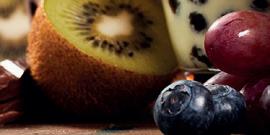
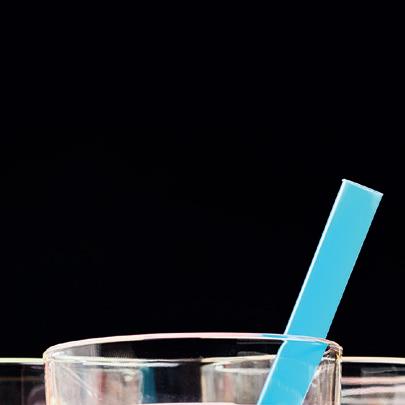



Alex Bell – Editor
4-5 - Data at your fingertips - Lumina
6-7 - Creating a buzz - Sable
8-11 - Smart thinking - Fracino
12-13 - Making a difference - Evoca
14-17 - Super service at speed - Welbilt-Merrychef
18-21 - We’ve got you covered - Conglom
22-23 - Getting the message - Sabert
24-25 - Looking good - Contract Furniture
26-27 - The creativity drive to sales - Grind
28-30 - Four building blocks to success - Serendipity2
32-33 - Time for tea - JING
34-36 - Heart of the operation - Ian Kissick
Editor Alex Bell, Tel: 01291 636349, email: alex@jandmgroup.co.uk
Advertising Paul Steer, Tel: 01291 636342, email: ads@thecafelife.co.uk
Production Gareth Symonds, Tel: 01291 636339, email: gareth@jandmgroup.co.uk
Subscriptions and Customer Service
Tel: 01291 636338, email: subscriptions@thecafelife.co.uk
Editorial Address Café Life, Engine Rooms, Station Road, Chepstow NP16 5PB www.thecafelife.co.uk

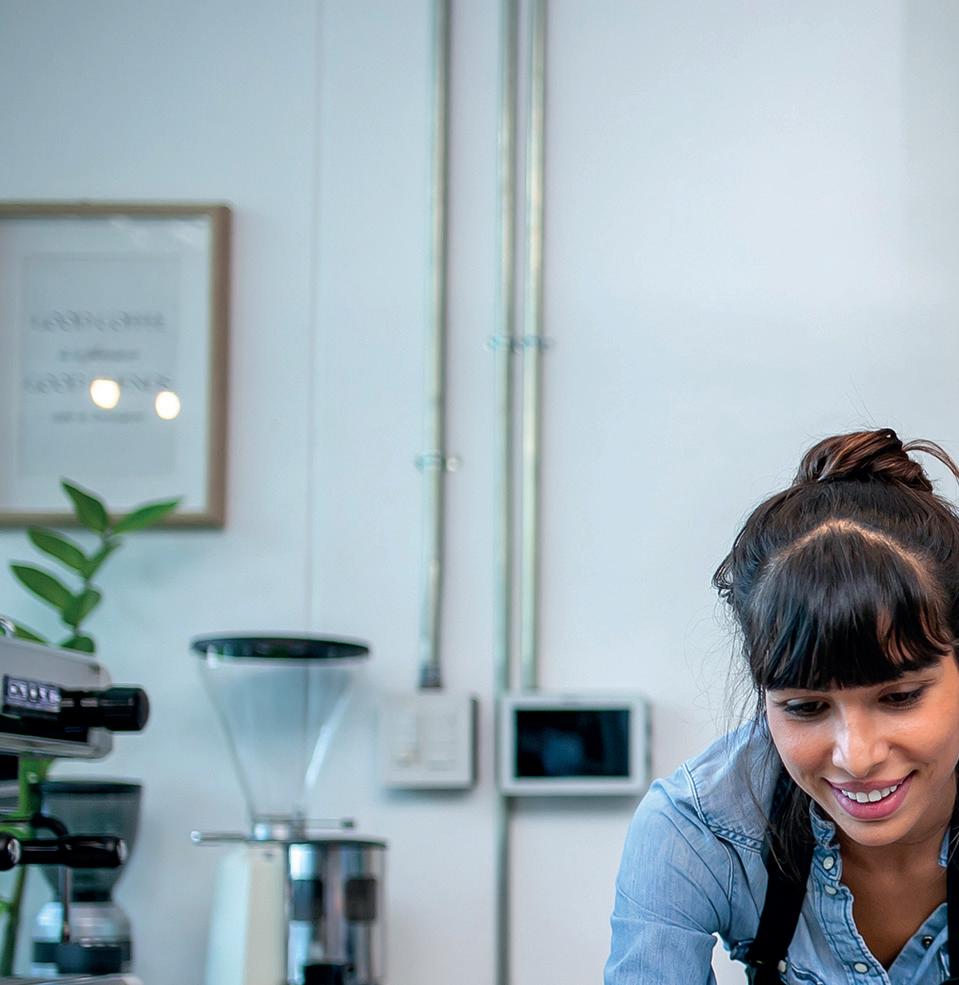
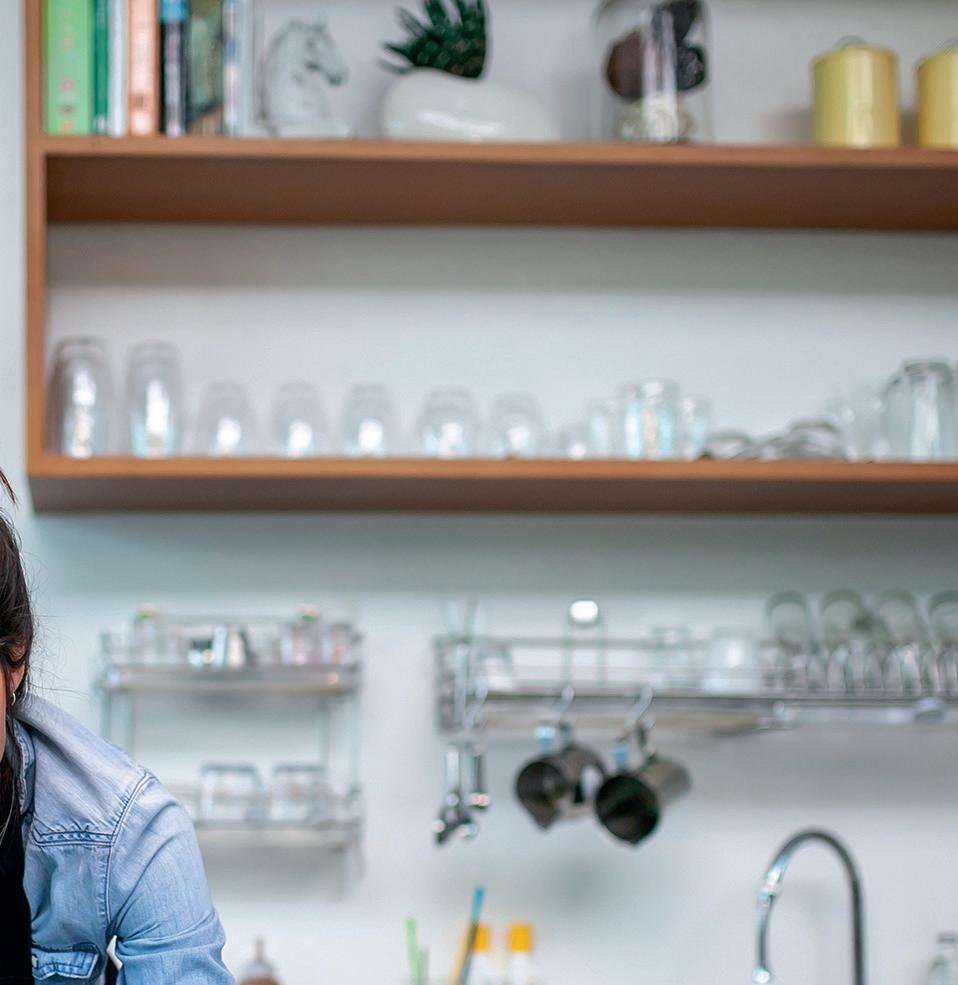


Understanding consumers,
competitors and the industry landscape can only be good for startups, says Maggie Davis, insight manager at Lumina Intelligence.
The coffee/café market is thriving in the UK, buoyed by an enduring culture and strong physical expansion by operators. It is forecast to exceed its pre-pandemic value by +24% in 2024, reaching a total estimated value of £6.2 billion (Lumina Intelligence Market Sizing Insight & Analysis, June 2024).
Unsurprisingly, the dominant players are Costa Coffee, Starbucks and Caffè Nero, collectively holding two thirds of the branded coffee shop/café market share (LI Operator Data Index, June 2024). Delving into the detail of what these companies do, alongside consumer behaviours and attitudes,
can open pathways for new and independent operators to succeed in what has now become a sector that’s exciting and full of opportunity.
Understanding the economic landscape is crucial for new coffee shop owners.
Key economic indicators, including inflation and consumer confidence, provide insight into where and how to spend your money, what consumers are doing and potential economic challenges faced by competitors and consumers alike. The ongoing cost of living crisis poses significant challenges for consumers and operators. Goods and services are more expensive than ever before, impacting household budgets, leading to more cautious spending behaviours.
Cafés need to adapt by finding ways to offer value without compromising on quality. This economic pressure is reshaping consumer priorities and necessitating innovative approaches to maintaining customer engagement and loyalty.

Tracking consumer behaviours and attitudes reveals valuable trends and growth opportunities and is hugely beneficial for new entrants to the market to understand their target audience. Shifts in consumer lifestyles and technological advancements have reshaped the café experience, influencing how consumers interact and how operators tap into trends.
Recent improvements in consumer confidence, reduced train strike action and a return to more normal routines have led to people participating in the out-of-home (OOH) coffee market. Despite this increase in demand, persistent economic challenges and wet weather have kept visit frequency flat compared to last year. As a result, even though more consumers are participating, there is intense competition to capture spending on the one/two weekly occasions consumers venture out for coffee.
However, treating missions are the second-largest driver for coffee
consumers, showing consistent yearon-year growth as people seek small, affordable luxuries and premiumquality coffee. Coffee shops can leverage the ‘lipstick effect’, as the lowcost nature of their products provides consumers with affordable indulgences during the cost of living crisis.
Consumers are returning to prepandemic behaviours, with increased office commutes and high-street footfall. This shift back towards city centres is expected to become even more pronounced in 2024. Lumina Intelligence’s Eating Out & Drinking Panel reveals that demand for experiences in the OOH market is also rising, with 59% of coffee buyers being experience-led, a trend that has grown annually. This shift has prompted in-venue consumption and transformed coffee shops into vibrant community hubs for social interaction.
Analysing the competitive landscape and operator strategies, including market share and positioning of key players, is well worth doing. Strong net space growth is forecast in 2024, driven by the expansion of varied formats and locations including travel hub, drive-thru and kiosk-style services (LI Operator Data Index). Changes to consumer habits – including hybrid
working – have prompted operators to adapt strategies to align and ensure that operators are in the right place to achieve and attract custom.
For instance, Gail’s Bakery is opening its first in-store takeaway site at Waitrose Canary Wharf, leveraging established loyalty and increasing brand presence among its core demographic. Caffè Nero is launching its first-ever drive-thru store at Stansted Airport, providing a template for future expansion.
Consumer demand for convenience is driving digital innovation, via automation, integrated digital experiences and apps. This tech has become pivotal, with brands, including Costa, enhancing the experience through touchscreen ordering systems, mobile order-to-table features and QR codes on the Costa Club app. Similarly, Knoops has launched an app allowing customers to customise and pre-order bespoke chocolate drinks.
Lumina Intelligence’s Menu Tracker Tool provides monthly updates on branded operator food & drink menus, capturing data on options, price points and new product introductions. This can aid operators in navigating a challenging picture.
One trend that operators are currently capitalising on is premiumisation and novelty factors. They are exploiting seasonal events

to launch premium, limited-time-only specials that carry higher price points and tempt consumers to trade up. Operators including Starbucks and Blank Street Coffee are introducing iced drink ranges and flavours during warmer months, tapping into desire for novelty and differentiation.
Starbucks’ crème brûlée-inspired cold foam range and Blank Street’s summer line-up of iced matcha specials take advantage of evolving consumer preferences influenced by social media trends.
Thorough market research and sector insight is indispensable for starting a successful café. New owners can navigate the competitive landscape effectively by understanding consumers, competitors and the current landscape. Armed with the right information and strategies, aspiring entrepreneurs can turn their dreams into a thriving reality.
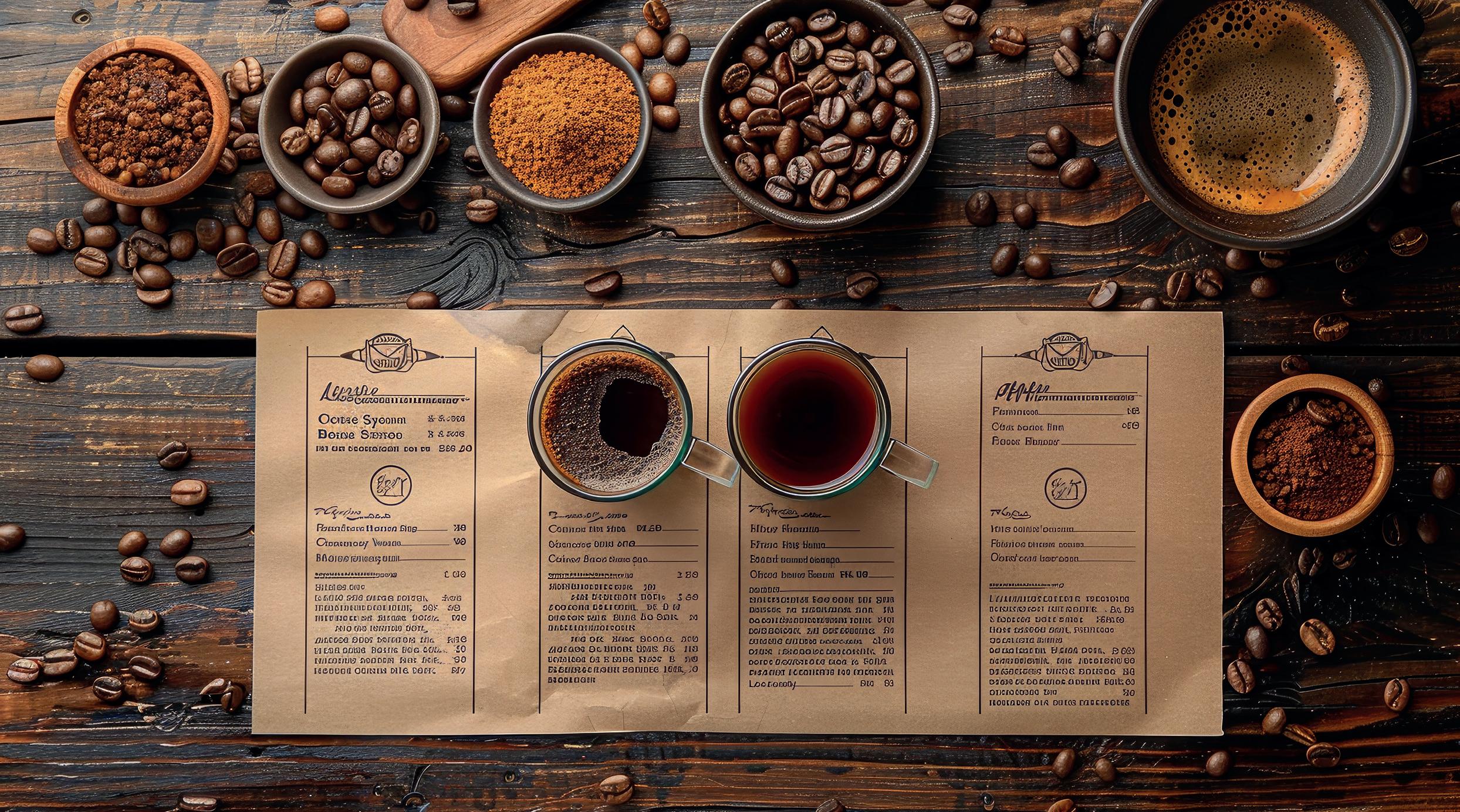

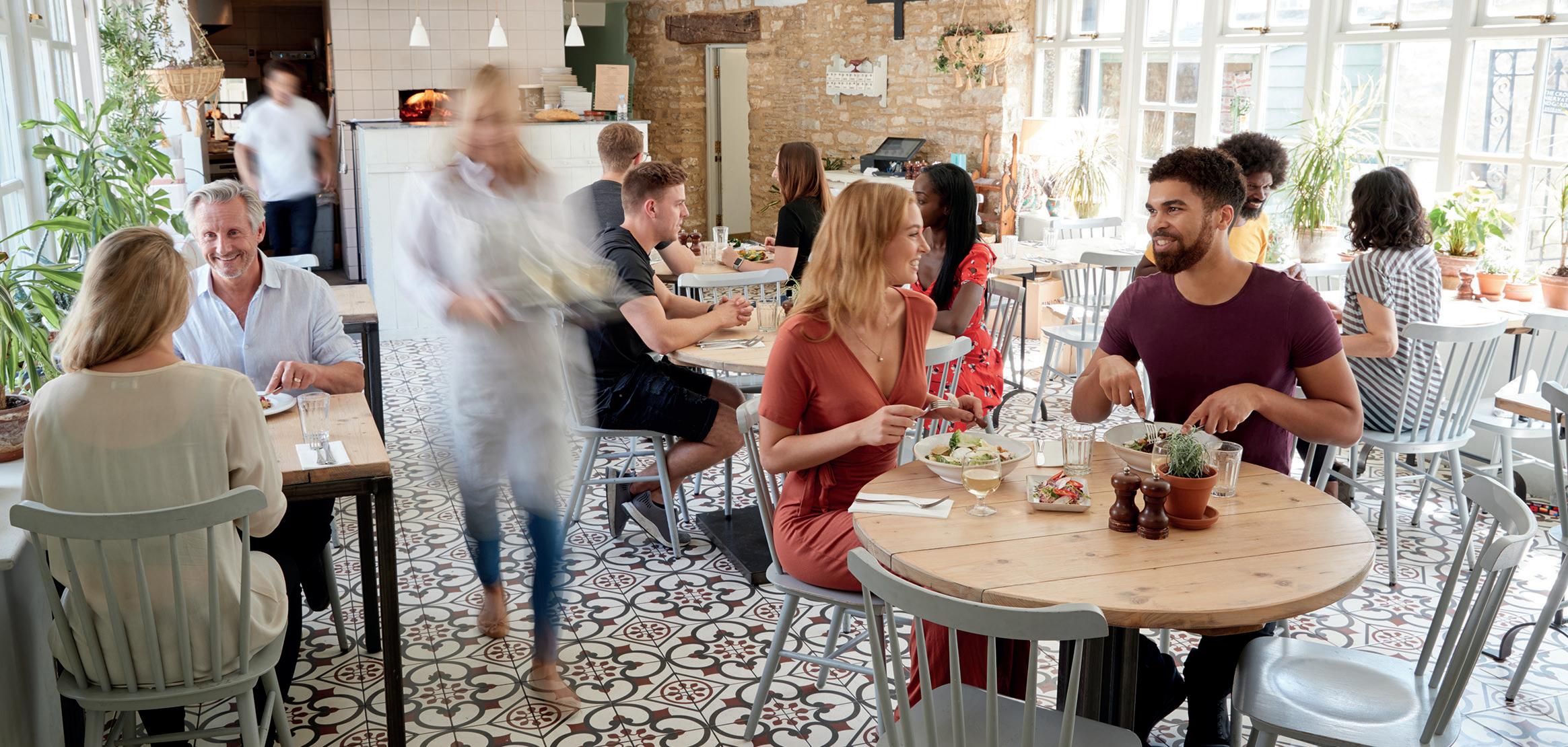

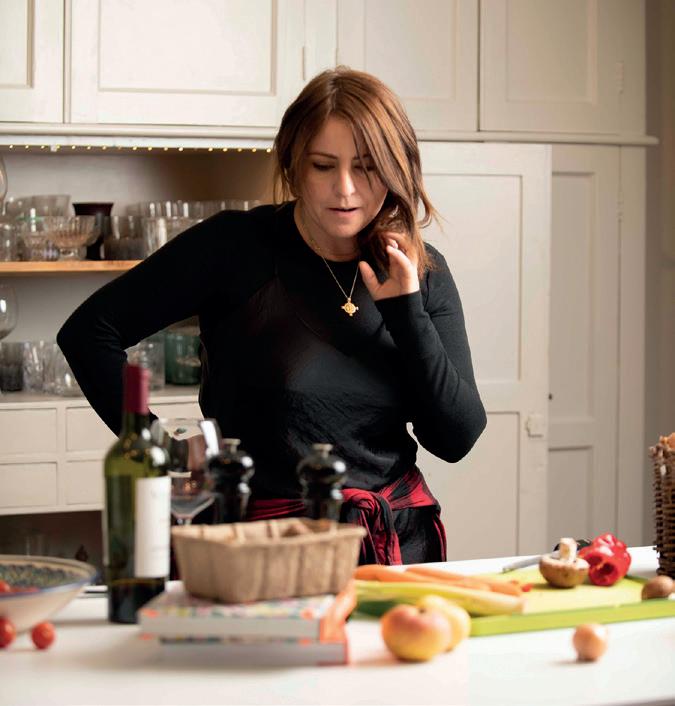
A mere 98 million. That is how many cups of coffee we drink each day in the UK alone. Some of those are enjoyed at home, but those that aren’t have helped shape a UK coffee shop industry worth £4.6bn. According to the British Coffee Association, 80% of people who visit coffee shops in the UK do so at least once a week, with 16% of us embarking on a daily pilgrimage for caffeine. But with our 8000 independent coffee shops now jostling shoulder-to-shoulder on a high street of options, not to mention the many brand chains, it takes something special to stand out.
Here are three ideas to percolate ahead of opening your own coffee shop or café:
According to the World Coffee Portal’s Independents Report UK 2024, the UK is home to an estimated 12,212 coffee shops. Building a brand is one of the most overlooked elements of setting one up – but is one of the easiest ways to stand out.
Rebecca Martin, founder and editorial director of travel and hospitality marketing agency Sable, explains how brand creativity and community can brew a strong start for coffee businesses.
It sounds daunting but can often be as easy as just thinking about how you would like to look and sound, who your target customer is and what differentiates you from the rest. To put it in foodie terms, are you more smashed halloumi on artisanal sourdough or traditional Victoria sponge on a chintzy china plate?
Consider the look and feel of your site – are you veering towards retro cool or rustic and industrial? Perhaps you are embracing the charm of British teatime and all the finger sandwiches, cakes and finery that come with it.
Maybe you are contemporary and stylish, with Scandinavian-inspired interiors and a menu heavy with acai bowls and turmeric lattes. Branding goes far beyond a logo, extending into music you play (remember your licence!), style of food, cups and uniforms, art on the walls, and even the types of books scattered around.
Building your brand is one of the most exciting parts of establishing a coffee shop, so embrace and enjoy it.
While branded coffee shops still rule the roost in terms of large-scale profit, our collective appreciation
for supporting local shows no sign abating. A report by the Allegra Group found that 65% would opt to visit a local coffee shop, with 68% stating that supporting their local coffee shops was an important consideration in deciding where to buy a brew.
Creating a community can also be rewarding for founders. Independent coffee shops have a tendency to become a hub of the community, introducing and connecting locals whose paths may otherwise not cross. Coffee mornings and organised meetups become a treasured date in the diary, while events like run clubs create a space where shared interests build bonds on a larger scale.
Commercially, creating a community and events is a cost-effective way to reach customers. It’s a way of giving back, too. If you are by the coast, hosting a beach clean could help balance some of the environmental impact of coffee culture, while putting you on the radar of local environmental organisations and families looking for a wholesome way to spend some time.
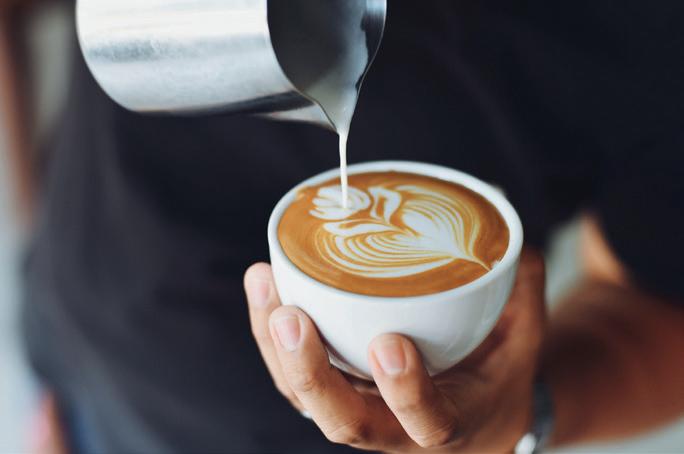

Ripe for creativity, hospitality is exciting – and independents have options when it comes to marketing. Social media is a must but consider new ways of creating content. In a Semrush poll, 89% of customers wanted more video from brands, and social media users have a craving for authenticity.
Whether it is spending the day behind the scenes, a how-to guide to latte art, insider tips on the local area, sharing a banana bread recipe or just focusing on daily comings and goings, video footage increases engagement.
It can be tempting to give social media everything you’ve got but hospitality reacts well to offline marketing methods too. Activations are an unexpected way of promotion and can be inexpensive. Coffee shop by the sea? Task a sand artist with recreating your logo in supersize on the beach for World Ocean Day, handing out free reusable cups. City dwellers will remember much-needed free coffees on their commute, and offering hosted masterclasses as Christmas gifts will generate awareness and direct revenue.
Finally, don’t overlook merchandise. Consumers are keen to be part of a lifestyle rather than just passing trade, and this can create natural ambassadors via customers. Branded reusable cups have become de rigueur and the sustainability element brings dual benefits alongside getting your brand out there. T-shirts, caps, stickers and tote bags are also popular options.
Design wise, don’t be afraid to veer away from your logo and explore graphic imagery related to coffee culture or even travel. Collaborating with local artists can extend reach and create a coveted product.
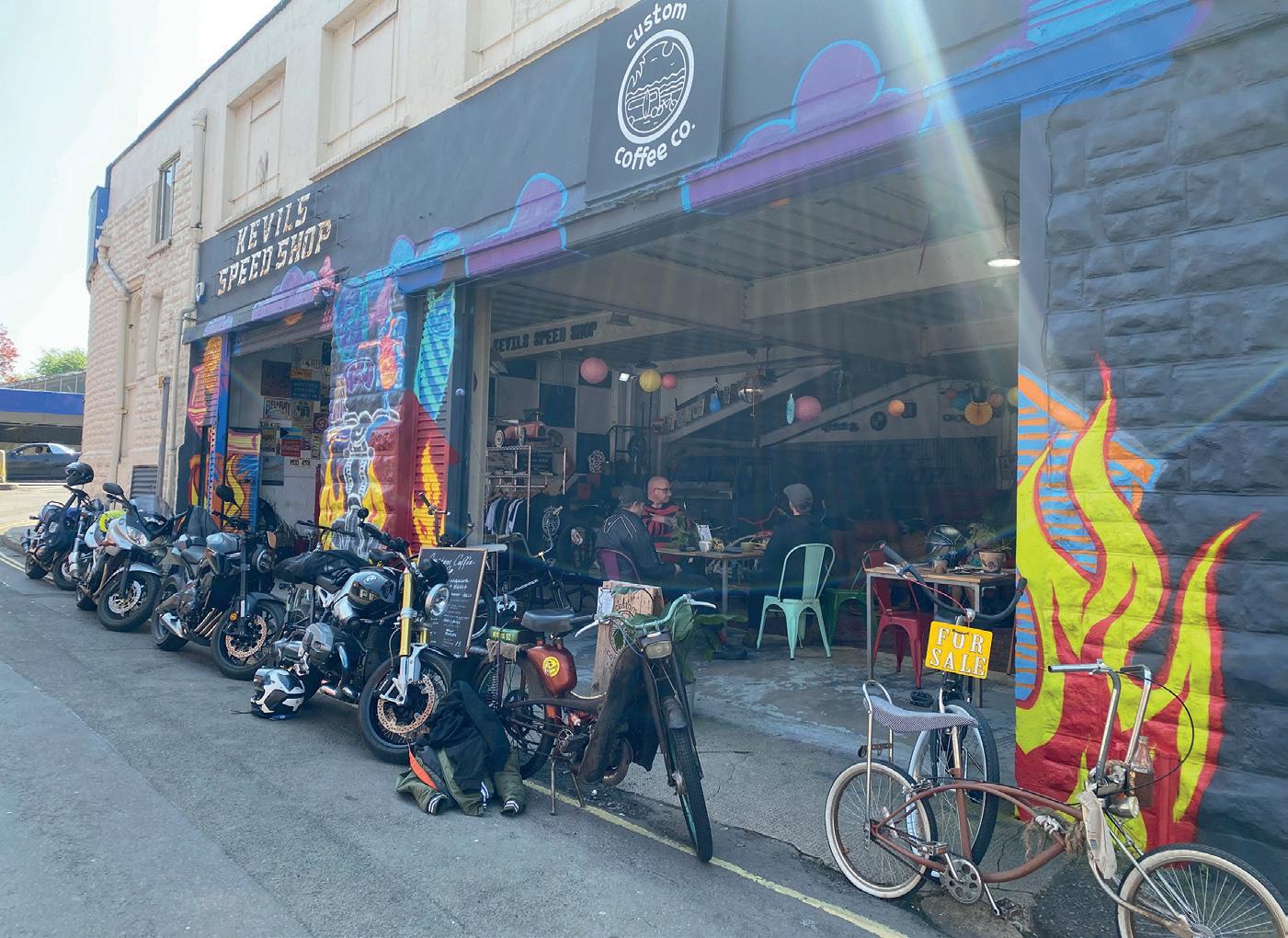
‘Coffee and customs’ was the brief for Custom Coffee Co. Tucked along an ordinary looking residential side street, only the spray-painted beach huts and ice creams depicted on its roller shutters hinted at the coffee shop’s coastal location. Look again at the artwork by renowned street artist Szabotage and you saw the retro Chopper bike, racing seats, motorbike, and a whole host of other indications of what was unveiled when the shutters rose.
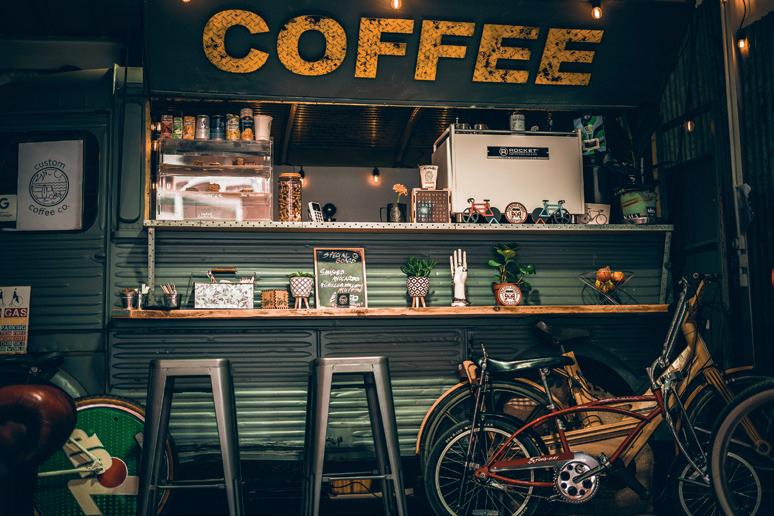
Leon at Custom Coffee Co serves Bristol-based Triple Co Roast from a vintage HY van, parked amidst a melee of retro bikes. Schwinn, Raleigh and Electra vie for the attention of the two-wheel obsessed, heads turned again by the custom builds of the neighbouring Kevil’s Speed Shop that shares the garage space in South Devon.
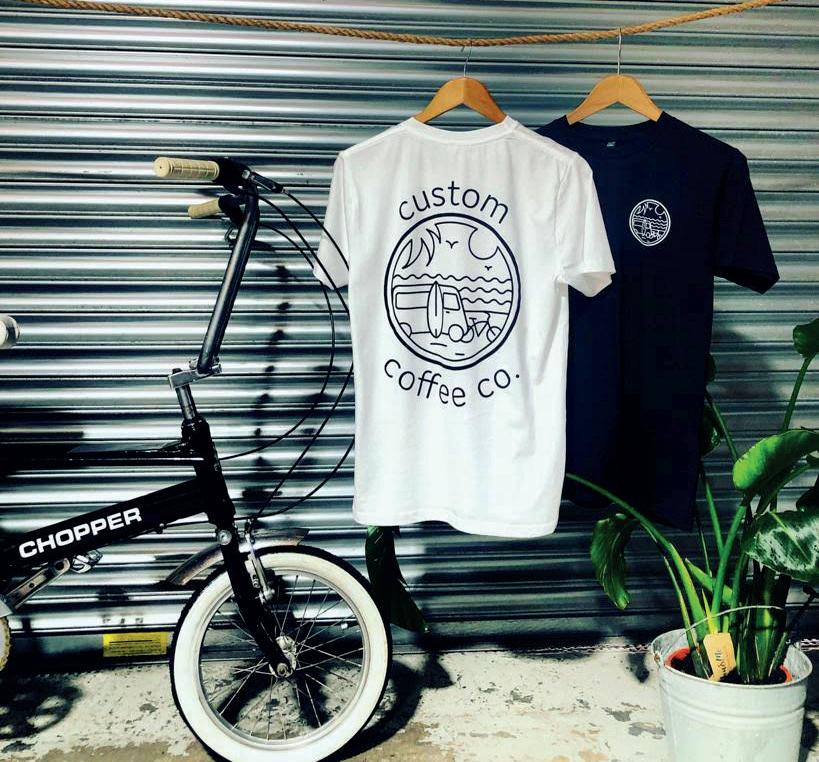
A lifelong obsession with all things both two- and four-wheeled led Leon here. Having toyed with converting a storage container into a coffee hangout on the coast, Leon came to press ‘Buy Now’ on an eBay-listed non-runner that lacked an engine but made up for it in character. In two years, Custom Coffee Co has become an example of the power of brand in creating an independent coffee shop.
Building on his own love of retro, flat whites are served in vintage Poole Pottery mugs, wheels of all shapes are on display in coffee table books on reclaimed wood benches, and two-wheeled steeds aplenty leave no mistaking that this is a bike café first and foremost.
But Custom Coffee Co’s clientele is charmingly varied, ranging from the Lycra-clad, post-cycle coffee and cake crowd of a Saturday morning to adorable 81-year-old Doris and her four-legged sidekick, Poppy.
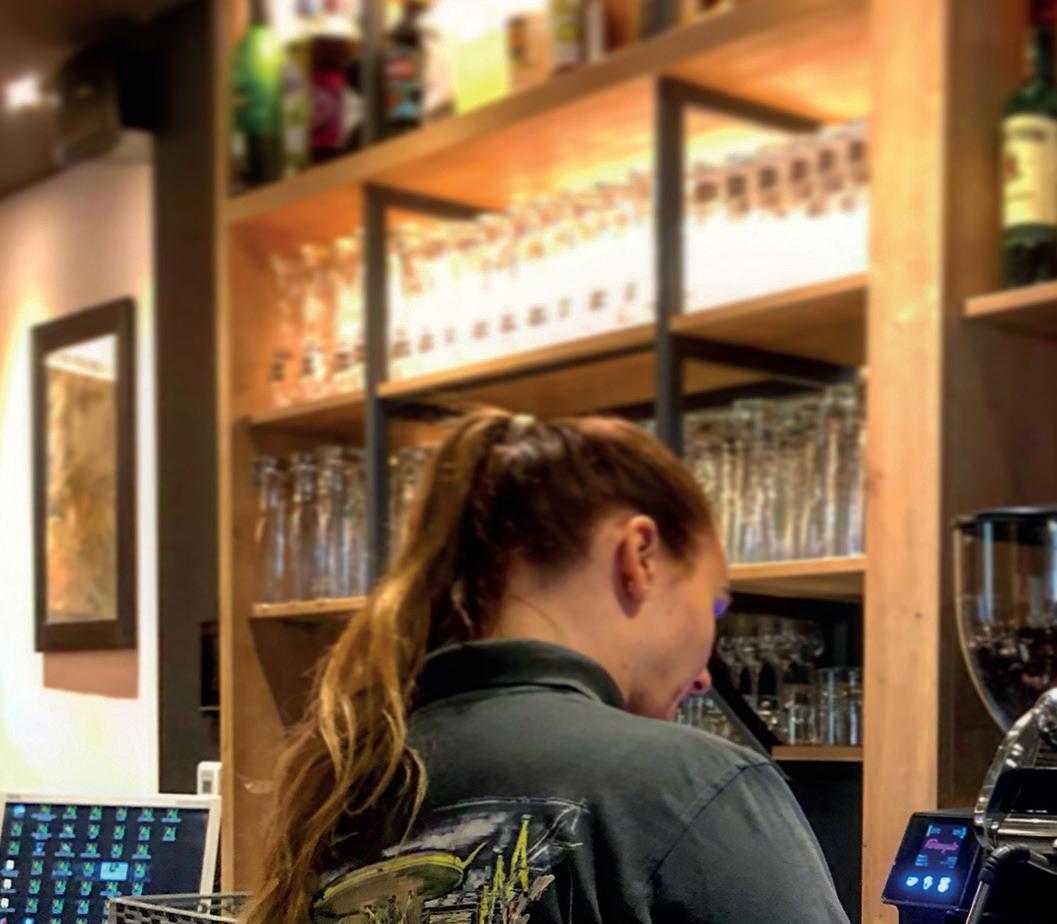
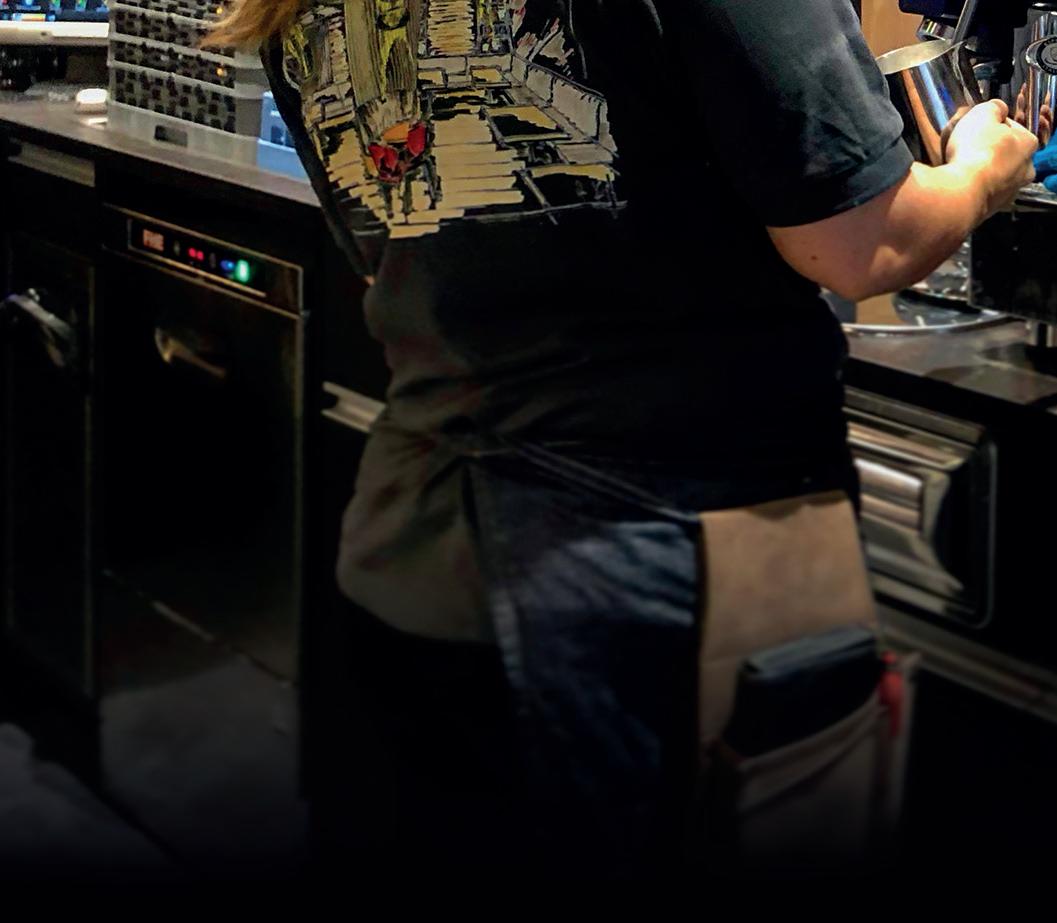

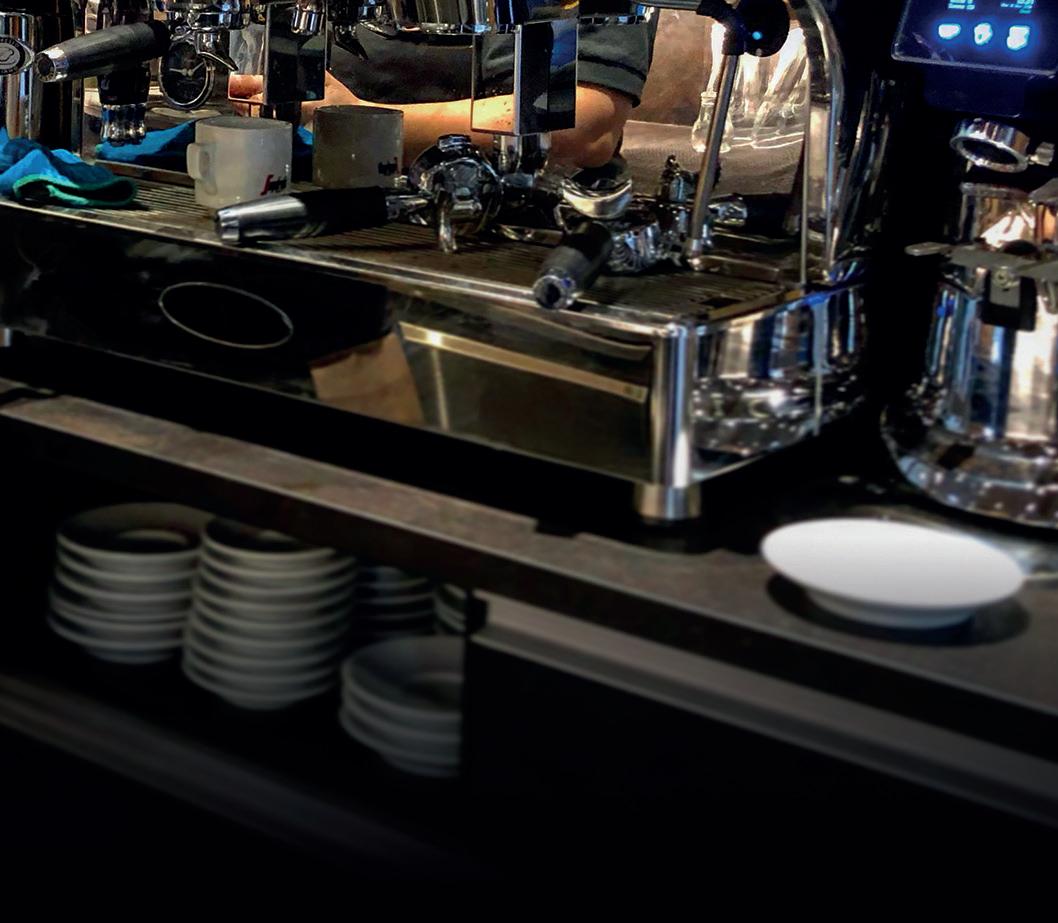
Angus McKenzie, strategic account manager at Fracino, talks tea, trends, staffing and competing with the big guns.
How would you go about incorporating drink trends like chai and bubble tea?
We’ve seen a steady increase in both bubble tea and chai recently, becoming somewhat mainstream in their customer base. Younger audiences are very open to exciting and customisable menus where fun and bold flavours can be enjoyed. While some specialist equipment is used in dedicated stores, you can easily plan to produce and serve a few options.
Just by purchasing clear takeaway cups, wide straws, some tapioca pearls (aka bubbles), you can easily shake up cold strong tea, vanilla or mango syrup, ice cubes, milk and pearls and give it a cool name.

Similarly, by buying a Chai liquid concentrate or powder, you can steam this up with milk to serve a cracking chai. Good prep and storage are the key to fast service – also, make up A4-laminated recipe sheets with photos so the whole team can learn and produce easily. Fracino has all the equipment you might need: from hot water brewers for tea, steamers on all espresso machines and the new standalone steam vault system. We also supply ice machines and warewashers.
"simple things like on-demand grinders make a huge difference to consistency and quality."
For smaller sites operating premium cookies/cakes/buns, is there an accessible way to offer hot drinks at a lower volume?
Yes. We recognise that in this growing sector, hot drinks are not core but a powerful spend builder and critical in the early morning breakfast sale window. Our Velocino hybrid system is perfect for this type of environment for three key reasons:
● It’s a one-button push operation for all drink choices so little skill is required, with the automated milk foam system that delivers in the cup.
● The machine has a small footprint, with just a 13-amp power supply.
● Low cost, with minimal maintenance, so it can return the investment quickly, even with daily sales of say fewer than 25 drinks.
Can a new independent coffee shop compete without the topline equipment seen in artisan chains? Absolutely. Topline style and

performance equipment is aspirational and ever so expensive, but the traditional espresso machine, as invented in Italy and used all around the world, has the performance and options for most hot drinks menus.
What’s more important is fresh and good coffee beans, a decent grinder and clean machine that’s looked after, plus well-trained staff. Luckily, Fracino can help across all these areas, and we help many foodservice customers deliver a successful drinks menu of the highest quality, with a relatively low capital equipment investment. Forget the hype and the sales fluff and spend your money wisely!

Staff training can be costly and time-consuming, so are there affordable automation options? Working smart is really important and we build our equipment with this in mind. Simple things like on-demand grinders make a huge difference to consistency and quality. Most of our grinders also have built-in shot timers –bringing a useful training aid for newer baristas. All our espresso machines have preset cleaning programmes that save time. Also, if you’ve got new staff or are recruiting people with

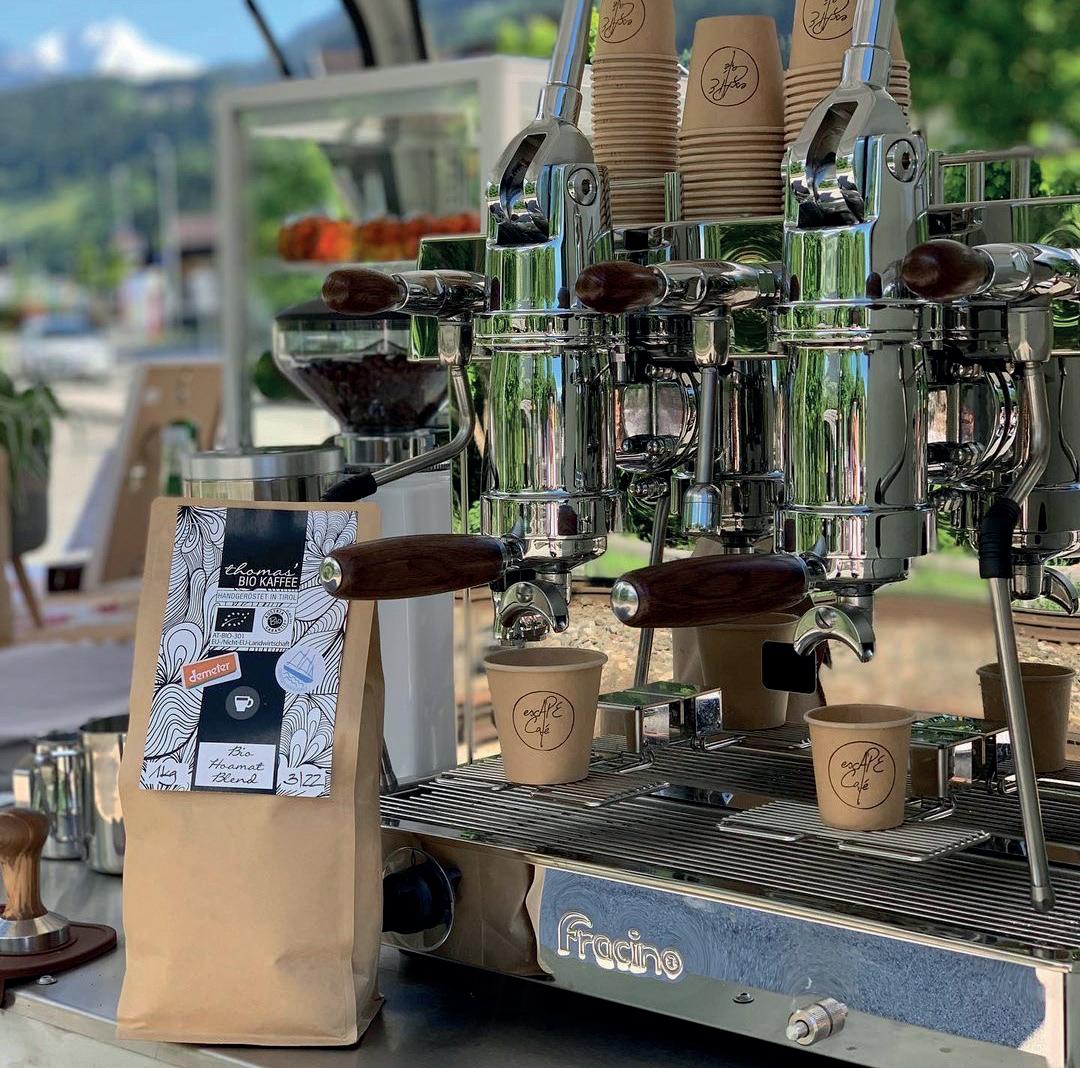
no barista skills, our Velocino system uses a traditional machine base but incorporates automatic milk foaming for a one-button push system. Most of our traditional two group coffee
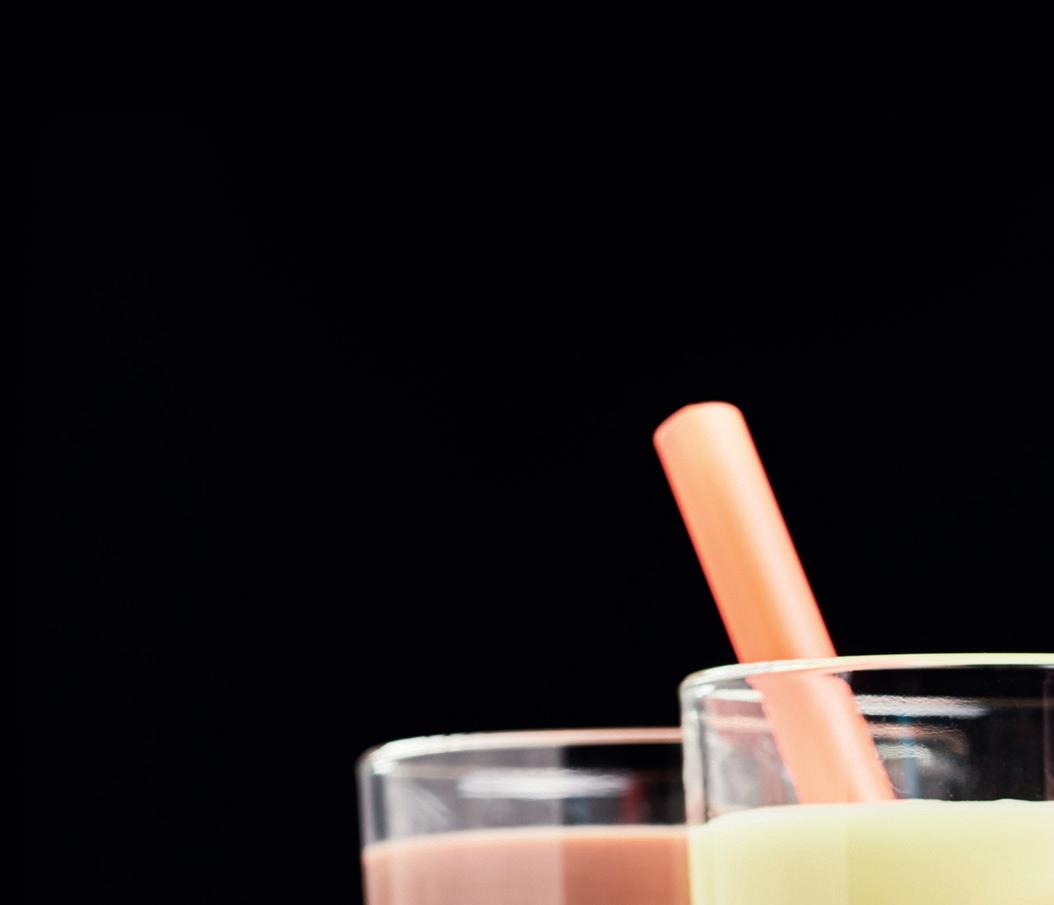


machines can be ordered with a clever F.A.S.T steam tube option – a touch button system enabling the automatic heating of milk for cappuccino (frothed) or latte (steamed). The steam
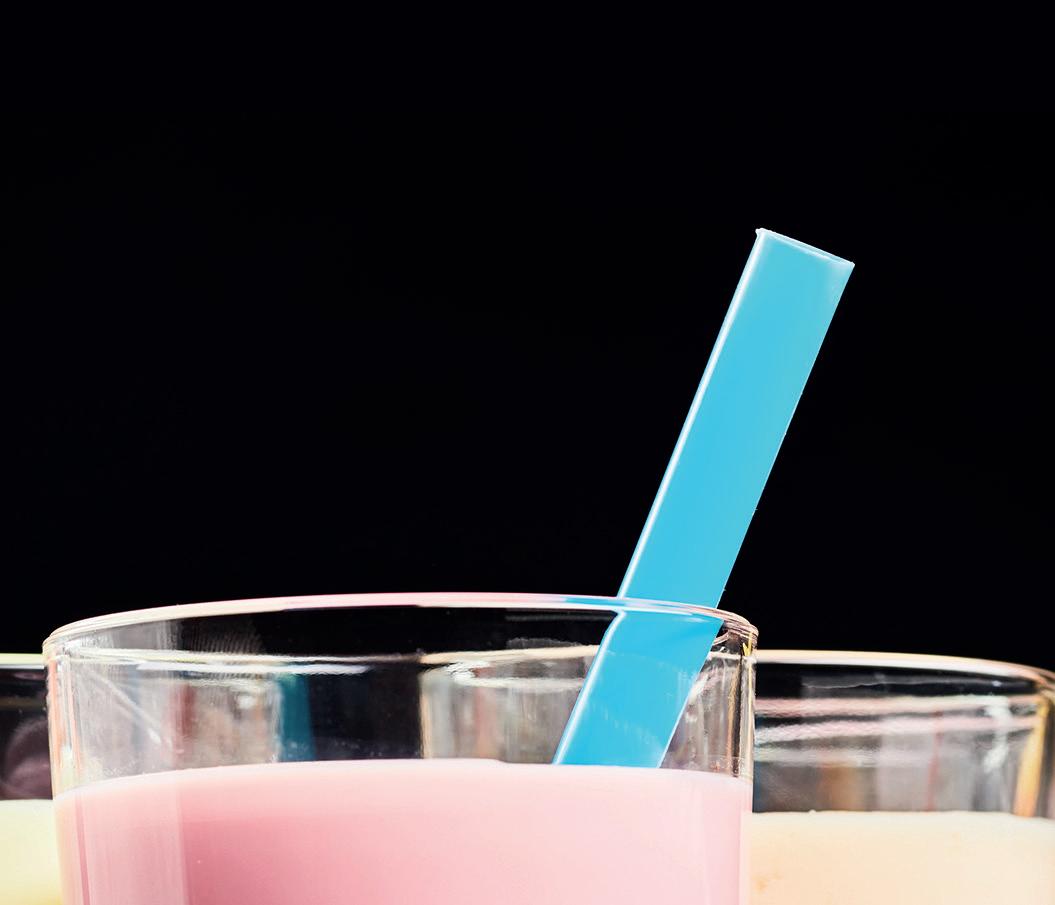


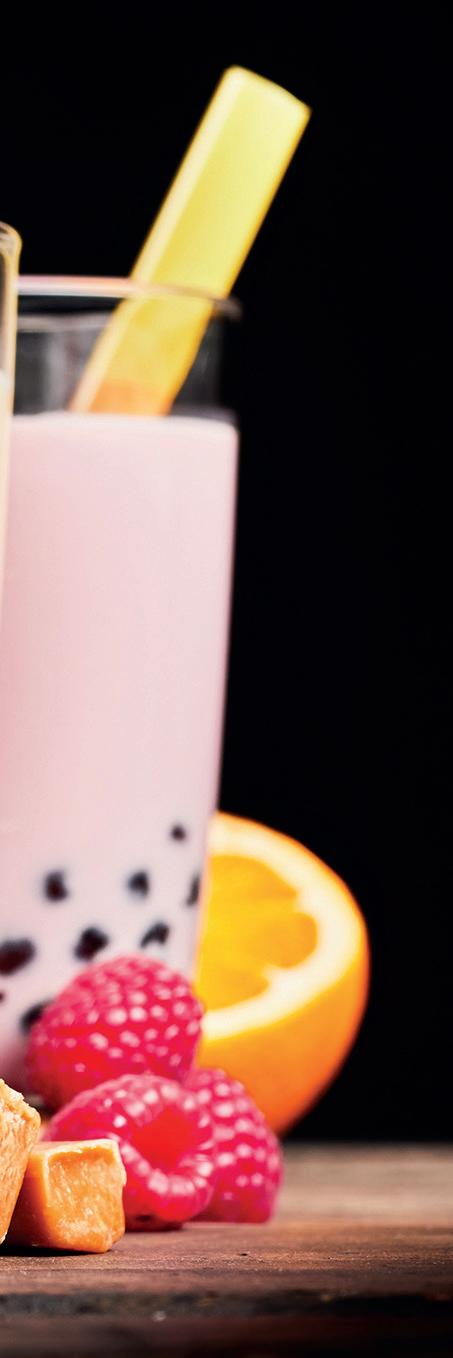

system automatically stops when the jug of milk has reached the required temperature. At Fracino, we’re all about saving you time and money!
How can I be attractive to potential customers when there are three coffee chains within a 10-minute walk?
Don’t try to copy! People want to see character, personality and strengths. It’s good to be different! Find one or two things that make you unique. You might invent/offer/serve drinks that aren’t on other menus or find quirky ways to define your style. Maybe have one or two drinks that represent great value – regular tea and filter coffee can help you do this and still be profitable. If you work with people like Beyond
the Bean, they will inspire you through their range of syrups and sauces to knock out a special, diverse and unique drinks menu, hot and cold. Tell customers about supply chain choices. This may involve supporting a local coffee roaster or explaining that your new coffee machine was made in Britain at Fracino in Birmingham! Also, give the warmest welcome with big smiles. The big chains get lazy and forget this, so build it into your culture.
When thinking about cold drinks, while keeping a coffee/tea/hot choc theme, can that be done without slowing down speed of service or investing heavily in fancy new equipment?
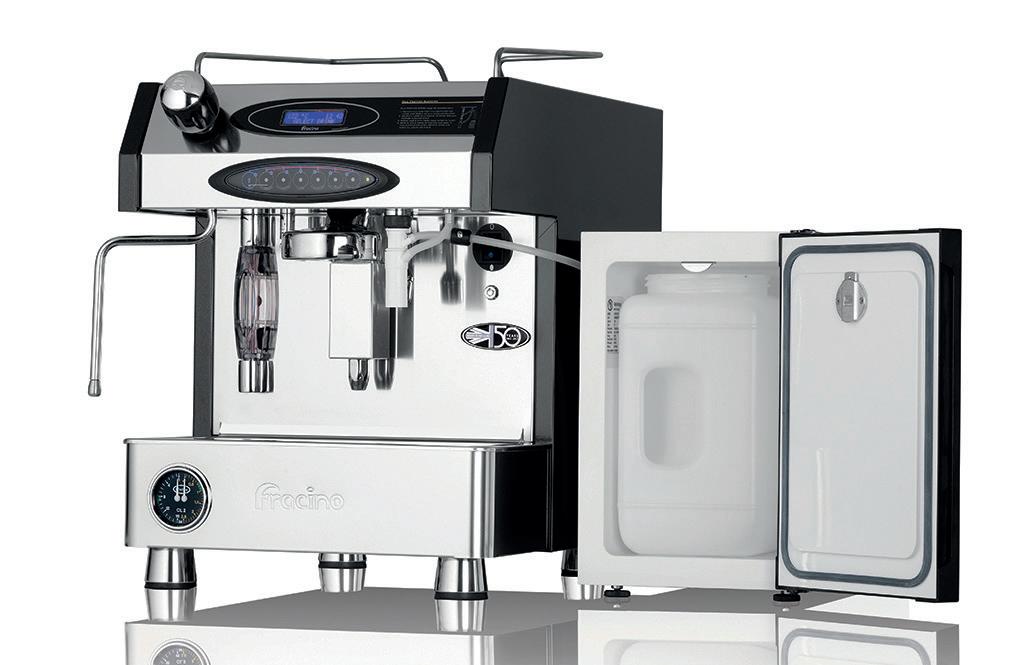
Yes – maybe explore buying in ice or getting an entry level ice machine (see the Fracino website for our models). Once you’ve got a constant source, you can shake or build/pour many drinks without the use of an expensive blender. It’s so easy to do something special. By using concentrates, your service can still be fast. Some coffee shops serve pre-diluted coolers in nice Kilner style dispensers on the bar –super-fast and very high margin. You can also make hot chocolate paste by mixing powder and water to a gloopy consistency that is easier to dispense and mix in drink recipes.
Most teas can be brewed and left to chill overnight, then jazzed up with ice, fruit and herbs. Also, pre-brew espresso and keep it chilled in the fridge and dispense as a base for coffee-themed drinks when mixing with ice/milk/ syrups/other ingredients. Look at shops online – in towns like Bristol or Edinburgh – to get ideas. And don’t be afraid to see what’s hot in Tokyo/ New York/Melbourne. A number of fun concepts are pinched from abroad.
But you don’t need to reinvent the wheel! We work with dessert bars and funky coffee operators and are always willing to listen to your needs and give the best possible advice. We know the market and menu are both changing, so we stay ahead of the curve in both the advice we give and the equipment we make at Fracino!
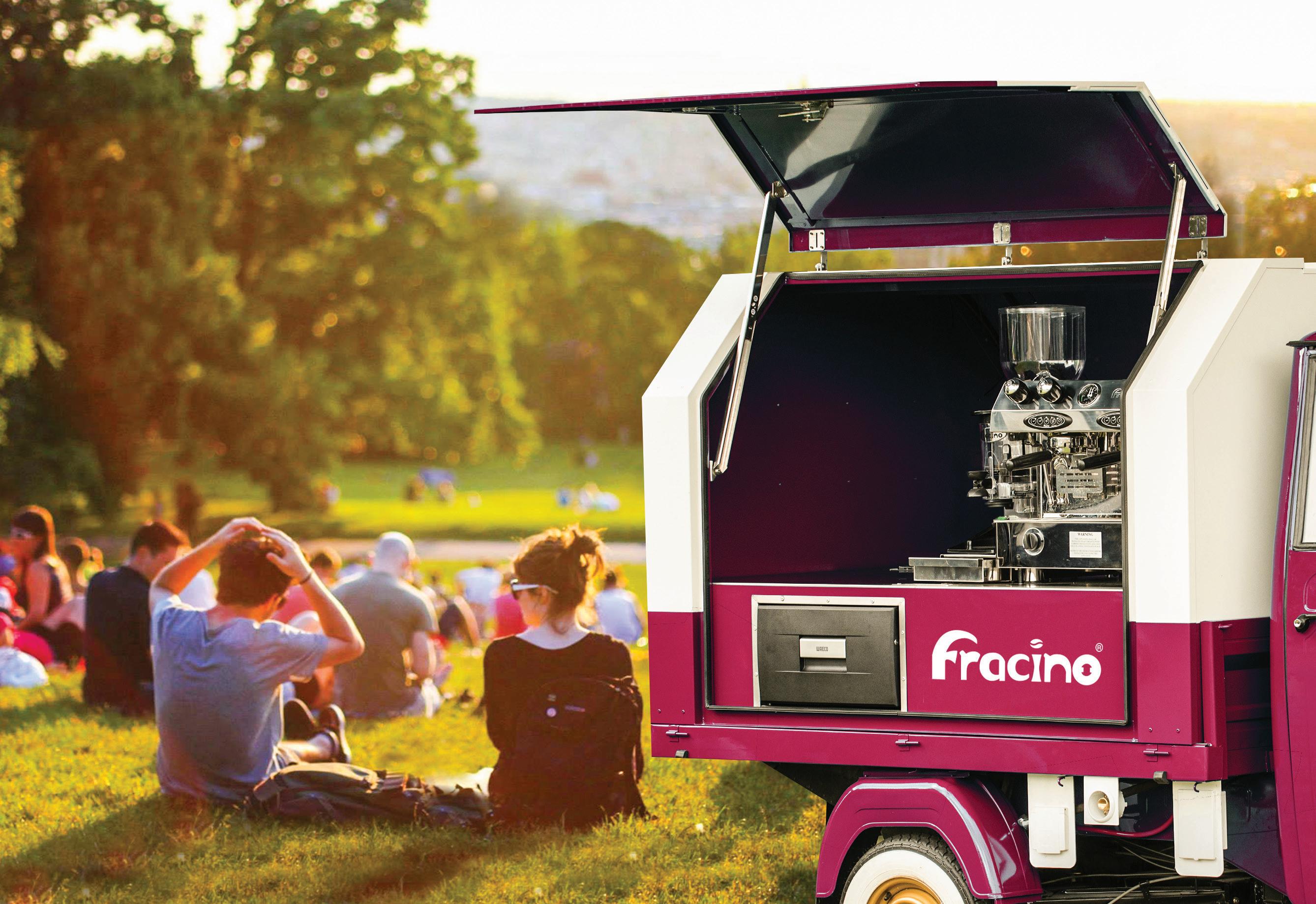

























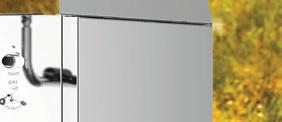














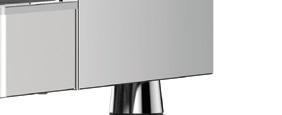


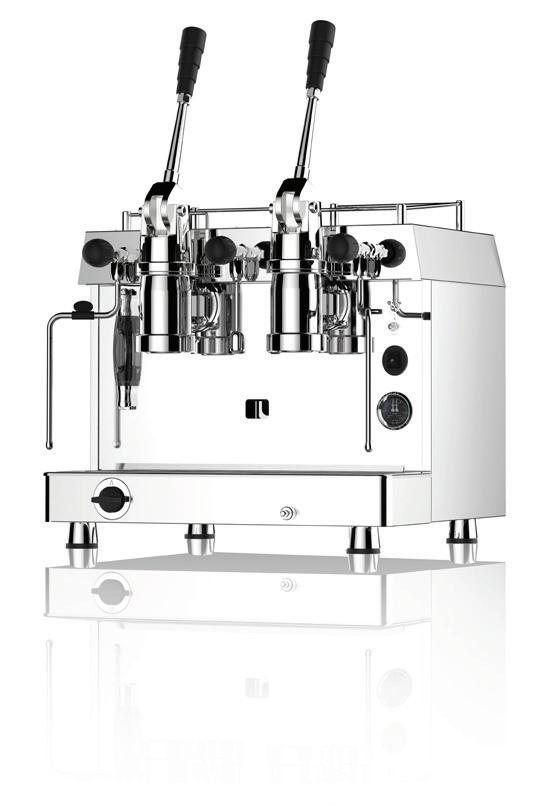



or
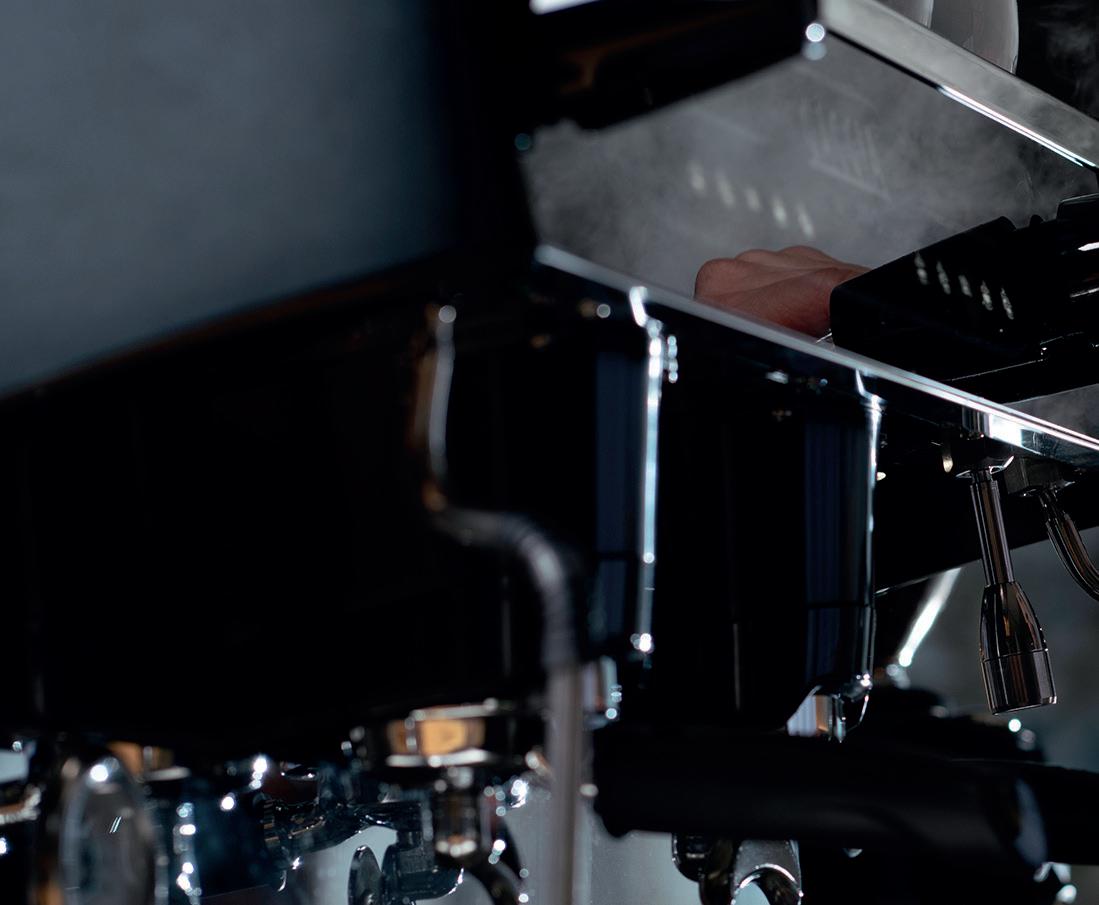
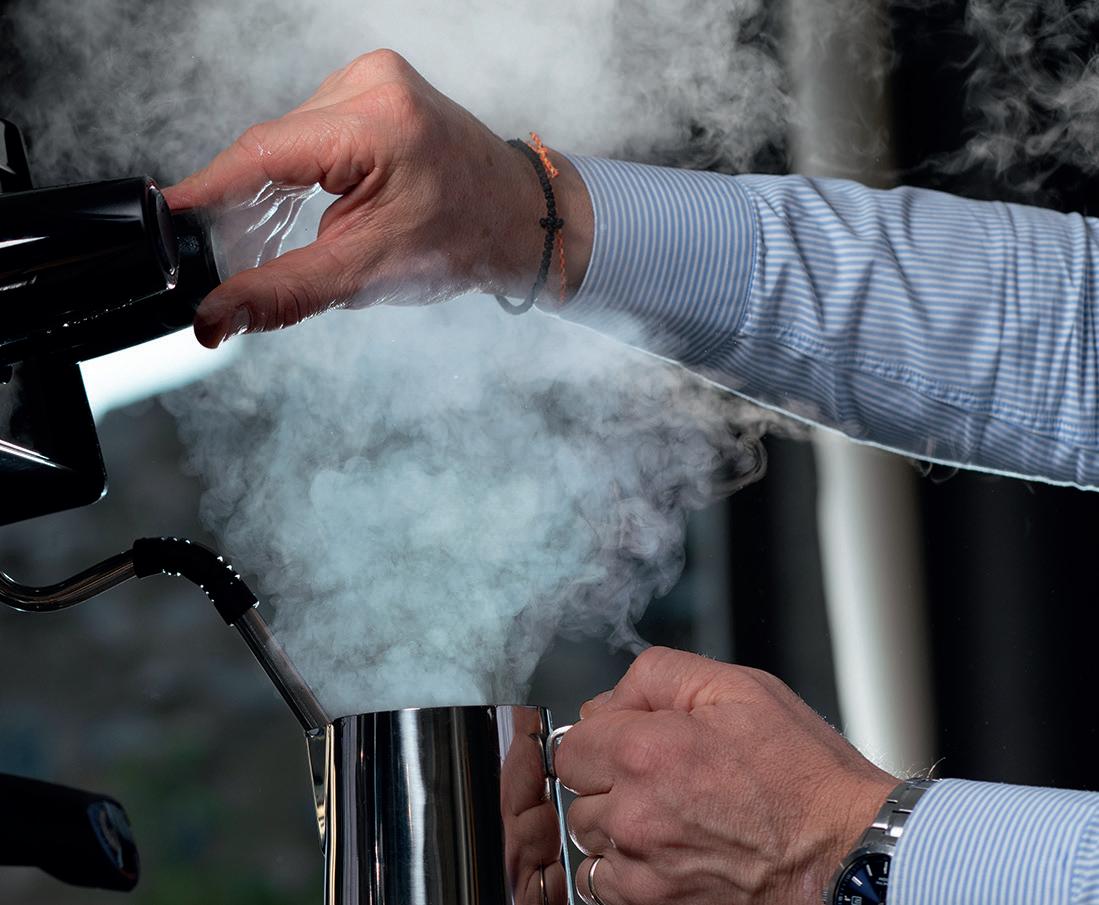
Modern-day co ee machines are beautiful pieces of equipment, blessed with remarkable technology and versatility. So, which model is the right t for your business?
Ultimately, the type of serving environment in which you operate will dictate the type of machine required. It’s a subjective decision with numerous factors to consider.
“There are two main choices,” said Andrew Barrow, sales director for the Gaggia Professional brand in the UK. “A fully automatic, which are basically baristas within a box. Providing it is installed well and calibrated to dispense a beautiful tasting espresso, it will consistently do this, time and time again. The great thing about a fully automatic is that it removes the requirement for extensive sta training. Just place the cup and enjoy the drink.
“The other option is a traditional machine, consisting of fewer moving parts. Less complex than automatics, they do require a skilled barista to operate safely and, more importantly, to create the best hand-crafted drinks. A good understanding of calibrating a grinder and measuring an espresso dose are also fundamentals to getting the besttasting espressos. The untrained user can be nervous about this, plus using a steam arm, but once mastered, the barista will soon learn perfect milk steaming techniques.”
But how many drinks will you serve on a daily basis – and how much counter space do you need?
“Of course, if you choose traditional you need to accommodate the size of the grinder. Gaggia manufactures one, two and three group machines, with the number of baristas another consideration. Each of Gaggia’s fully automatics come with a recommended drinks-per-day capacity, which can help guide your choice.”
Co ee machine technology has evolved signi cantly over the past decade, making it much easier for new operators to use them e ectively. Here’s how:
● One-touch operation: Modern machines often come with pre-programmed settings for the likes of espresso, cappuccino and latte. This allows new users to make complex drinks at the press of a single button.
● Automatic grinding and tamping: Integrated grinders automatically grind the right amount of co ee beans and tamp them with precise pressure. This reduces the need for manual skill and ensures consistent results.
● Auto-cleaning functions/cycles: These maintain hygiene and reduce the manual e ort required to clean the machine, a task that could be daunting for new users.
● Touchscreen displays: Intuitive screens guide users through the process with visual instructions, making it easy for beginners to select options and customise drinks.
● Energy-saving modes: Can reduce power consumption when the machine is idle, which is not only eco-friendly but also simpli es operation by eliminating the need to turn the machine o manually.
“The Gaggia Professional brand is manufactured by Evoca. They have extensive experience in manufacturing, giving operators the option of any type or size of machine from one brand. The history and legacy of the Gaggia name assures owners that they are in safe hands.”
The power of visuals cannot be underestimated. The theatre and air associated with hand-crafted drinks is an allure for customers. “And the design of the machine must t with the overall ambience of your café,” continued Barrow.
“The Gaggia range is imbued with Italian style. It encompasses La Reale, with copper accents; La Precisa and La Decisa with black fascias; and La Nera’s brushed stainless-steel panels. These features ensure that any Gaggia ts the bill.”
Another key consideration is environmental credentials.
“In recent years, Evoca has embarked upon an ESG project that puts sustainable development at its heart. The company is committed to reducing emissions in the short term, using a Science Based Targets initiative. We’ve also reduced the use of plastics in the manufacturing of our automatic machines while also signing the United Nations Global
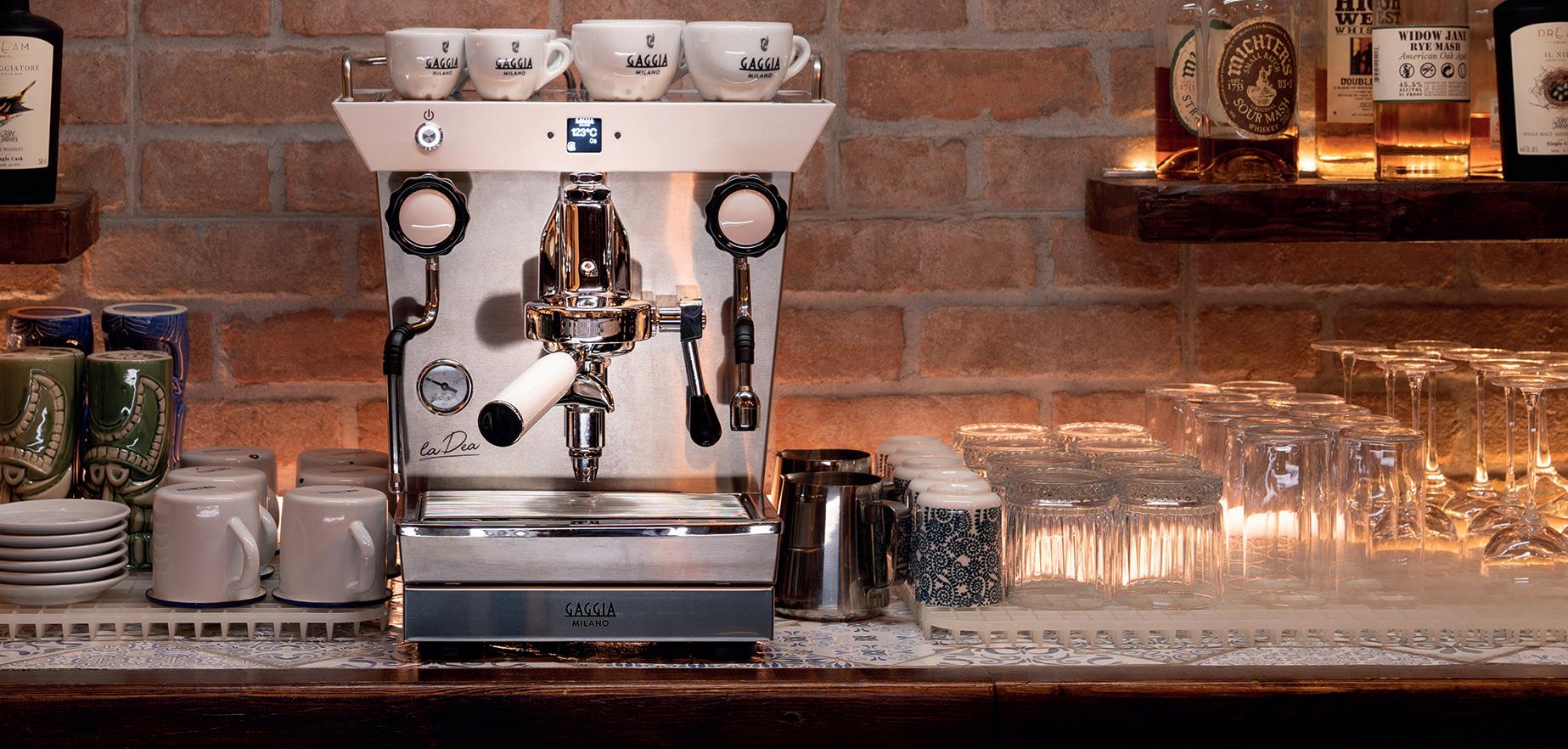
Compact, con rming our commitment to key principles on human rights, labour, the environment and corruption.
“But if your business is about co ee, your priority should be serving the best drink you can. The vehicle for achieving that is the machine, so it’s the most important piece of equipment. It should be considered an investment, not a cost.
“And while budget constraints are clearly a concern for startups, leasing options can help spread the cost – many stockists o er this as an option. The advantage with a Gaggia is that while they o er the full range of functions that you would expect, they do so at a more advantageous price point than many other brands.”
1. Underestimating business volume
Mistake: Choosing a machine that can’t handle peak times. What to avoid: Don’t focus on budget alone. Consider the volume of co ee you expect to serve during busy periods. A machine that’s too small or slow will lead to longer wait times and frustrated customers.
2. Ignoring maintenance needs
Mistake: Overlooking the machine’s requirements. What to avoid: Don’t forget that all machines require regular maintenance. Invest in a product that has easy access to parts and service providers. Maintenance failures can lead to costly downtime and repairs.
3. Prioritising aesthetics over functionality
Mistake: Going for looks rather than performance. What to avoid: While the machine’s appearance matters, especially if it’s visible to customers, it should not come at the expense of functionality.
4. Not training baristas properly
Mistake: Failing to provide adequate training for baristas on traditional machines.
What to avoid: Don’t assume that all baristas know how to operate every type of machine. Invest in proper training, which will also help maintain quality.
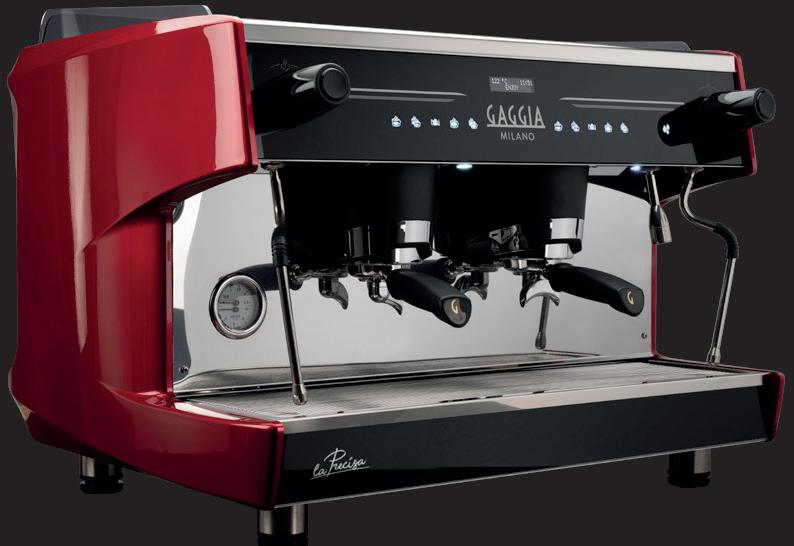
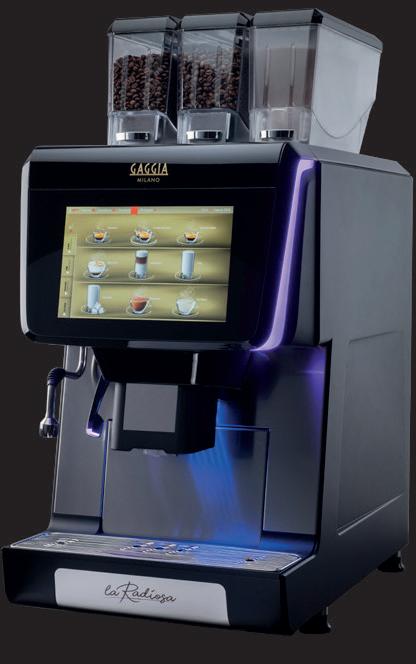

Alistair Farquhar
CFSP MIH, national key account director, Welbilt, o ers top tips on that vital café component – food!
1 Fitting it all in & available space
1 2
By nature, many co ee shops are tight on space, especially in terms of the kitchen and serving. And while it’s understandable, it’s important to turn over as much room as possible to customers for seating. It makes sense to ensure all equipment can multitask to optimise countertop availability.

For co ee shops serving hot food, there can be a myriad of equipment that is needed such as a grill, a microwave, toaster, etc. All of these take up space which can cause issues for sta trying to ful l multiple orders and make drinks.
Instead of numerous bits of kit, a high-speed oven can handle the work of several pieces of equipment, saving precious space. With a perfectly balanced combination of microwave, convection and tuned impingement, the Merrychef conneX®12e delivers maximum performance from a compact footprint, with minimum energy demands. As it is also ventless and runs o a low-amp plug, owners can simply plug in and start cooking!
For the essential hot food menu that makes such a di erence to customer retention, one of the most important things is delivering a consistent o ering – and this is where the Merrychef conneX® 12e excels.
Sta can cook the same dish repeatedly and it will always arrive the same. Providing a good service is all about delivering, with customers expecting the best each visit. Using di erent equipment to grill, toast or warm food means sta need to keep an eye on that as well as continuing to serve customers, which can result in food that is burnt or undercooked.
With the conneX® 12e, popular food items are pre-programmed meaning sta only have to press the relevant image and the Merrychef takes care of the rest.
Cooking up to 70% faster than a conventional oven and featuring the latest next-generation 7” HD touchscreen controller that can have sta fully trained in minutes, the Merrychef conneX12e® is perfect for small businesses and startups.
"instead of numerous bits of kit, a high-speed oven can handle the work of several pieces of equipment."
3
Ensuring fast delivery of food direct to tables or for takeaway is a must, so investing in equipment that can cook multiple items and/or speed cook is crucial. Whether it’s toasted sandwiches and pizzas or a wider o ering, a consistently high standard makes life a lot easier for those behind the counter. And the Merrychef conneX12e® can toast a teacake in 35 seconds, warm a Danish pastry or croissant in 20 seconds and prepare an open ham and cheese panini in 50 seconds. Fast, easy and always good.
4
Included as standard with the Merrychef conneX®12e are a paddle with hand guard and sides, a full size cooking tray, a non-stick cooking liner
and a at cook plate allowing operators to start creating straight away.
Other accessories are available, such as full, half and quarter sized cooking trays, egg moulds, soup bowls, etc. These allow multiple food items to be cooked at the same time, while di erent diets or allergens can be catered for easily. Heating a vegetarian panini on a half-size green cooking tray and a meat-based product on a purple tray, for example, can speed up service even more and using speci c trays means no clean down in-between.
Whether o ering hot food for the rst time or expanding the menu, the Merrychef conneX® 12e o ers an a ordable, entry priced, versatile appliance that can cook, grill, toast and reheat food from fresh or frozen.
It’s the ideal entry model for a café looking to add a hot food option to its business or wanting to improve throughput. Stylish, small enough to t on a countertop, easy to install and with ventless operation as standard, (so no extraction hood is needed), the conneX®12e features a patented cooling system with Air Curtain Technology® which keeps exterior surfaces cool-to-touch. This latest model is perfect for small businesses.
Visit welbilt.uk for more information.




Welbilt has promoted Alistair Farquhar CFSP MIH to national key account director, UK & Ireland. He will take over full responsibility for the key account team and have oversight of national hotels, multisite operators and chains in the UK & Ireland, leveraging his extensive experience to build even stronger relationships with the key account network, to further strengthening Welbilt’s position with EMEA based hotel groups.
Jonathan Butler, UK & Ireland sales director, said: “Since joining Welbilt nearly seven years ago as speci cation manager, Alistair has a set a high standard of professionalism and built incredible relationships with both customers and the wider Welbilt team. Taking on this new role will allow him to leverage his knowledge to support more key accounts with the comprehensive equipment across the Welbilt group.”
As an award-winning, global leader in the manufacture and supply of professional catering equipment, Welbilt has a range of brands, including Convotherm, Merrychef, Olis, Frymaster, Garland, Crystal Tips, WMaxx and Del eld.
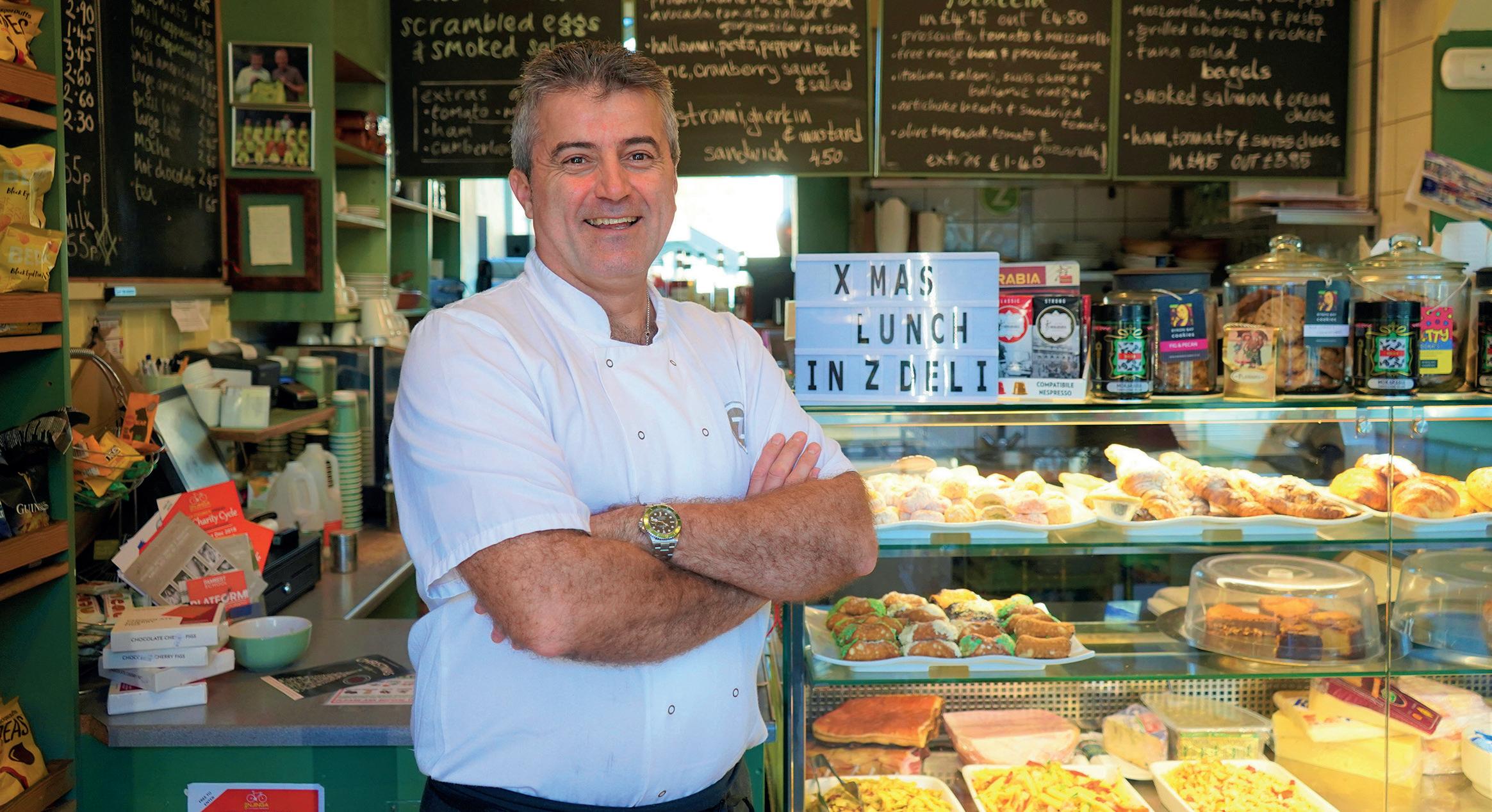

Twickenham-based delicatessen, ZORAN’s, explains how Merrychef has helped to stabilise food sales and maximise customer retention and satisfaction.
ZORAN’s, an independent delicatessen in the heart of Twickenham, London, has been o ering fresh continental style wraps, pastries and pasta for nearly two decades.
However, it wasn’t until the Merrychef was installed that the business was able to take hot food provision to the next level, as owner and manager, Zoran Jokic, explained: “The Merrychef is an unbelievable machine – in fact, it’s the best product I’ve ever had the pleasure of using in ZORAN’s entire 18-year existence!”
But it hasn’t always been this way. “Before the Merrychef, we used a basic panini press and salamander. We no longer need these appliances, as the Merrychef produces all our dishes in a much quicker time. In fact, we have been able to shave around 90% of the time that it used to take.”
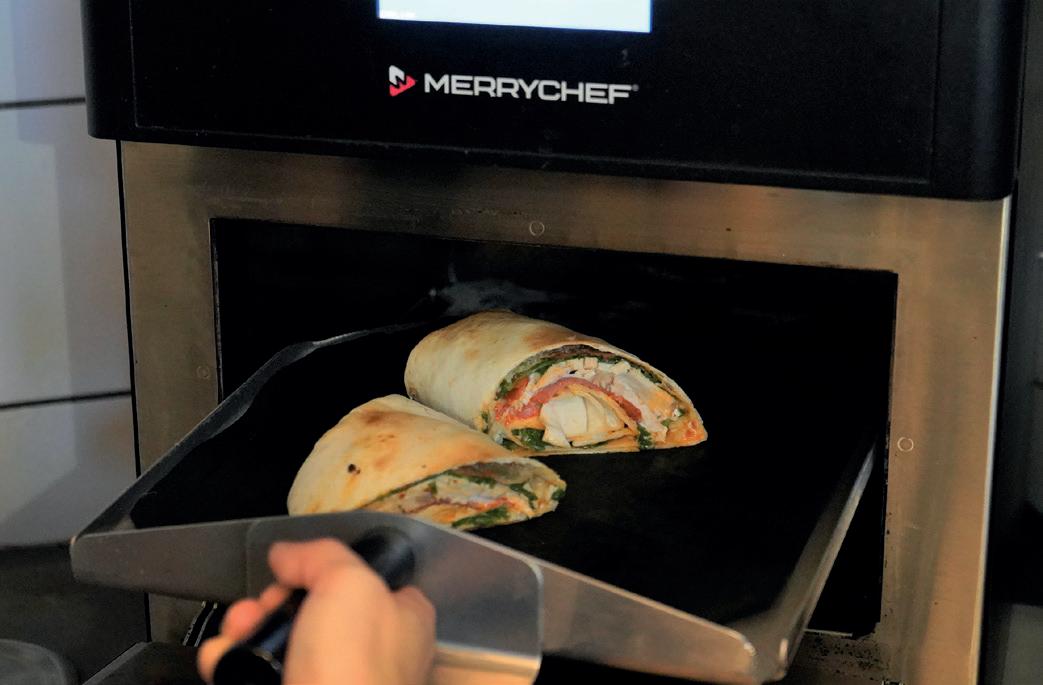
Exceptionally versatile and well equipped to deliver fastpaced and consistent results with every order, the Merrychef opens up a world of menu opportunities to independent businesses. This is thanks to its combination of three heat technologies – convection, tuned impingement and microwave – allowing for cooking times up to 10x faster than conventional ovens, as well as exceptional food quality.
“The most important part of my business is being able to deliver consistent food, fast. Now, with the Merrychef, I can cook the same dish over and over again, knowing that the quality will always be the same.”
Featuring easyTouch® technology with an icon driven screen, the Merrychef is simple to operate, allowing sta of any skill level to produce professional food results without the need for excessive training, overcoming any language barriers, limiting errors and potential food wastage. Arriving partly pre-programmed, the Merrychef allows operators to cook a wide variety of popular menu items at the touch of an icon. For further exibility, operators can utilise the Merrychef ‘Ready Recipes’ portal – a downloadable resource with hundreds of recipes at the click of a button.

THE FUTURE OF THE FOod to Go MARket >>>
including Simon Stenning
Strategy Advisor & Futurist
Rhian Thomas
Institute of Grocery & Distribution
Gavin Rothwell
Food Futures Insights
Sustainability and the Move to Net Zero >>>
including George Lamb / Andy Cato
Wildfarmed
Fran Haycock
The Greencore Approach
Joanne Elsdon / Paul Irwin-Rhodes
Heading for Net Zero at Greggs
Transforming work through technology >>>
including Warwick Wakefield
Director Customer Experience, Flexeserve
Mostafizur Rahman
Chief Engineer AI Technology, MTC
Joe Heather
Deliverect
PLUS >>>
Peter Backman
Market Analyst Camilla Young GS1
We’ve got you covered

Rob Preece, sales manager at Conglom International, guides you through the many packaging options on the market.
So, you have decided to go it alone and set up your own coffee shop. Congratulations!
You will be in good company. Latest research from Allegra reveals an estimated 12,212 independent coffee shops in the UK, an increase of 2.2% on the previous year, so it’s a good time to embark on a new venture.
There is a lot to think about – and we accept that packaging may not be top of your ‘to-do list’. Nonetheless, it is worth spending time researching the market and seeing what is on offer ahead of the big launch.
Assessing what packaging is needed can be a bit daunting for those new to the industry, as factors such as pricing, menus, supplier relationships and environmental concerns will all play a part in determining what works best.
The surge in the takeout and home delivered sectors has driven a big increase in the type and quality of packaging available in foodservice.
Consumers are demanding more adventurous options and this has driven innovation in design, particularly in terms of new materials.
There are some key food safe ‘coffee shop essentials’ which are appropriate for any business offering an eat-in or takeout menu:
These are available in various environmentally friendly materials including recyclable, home compostable and biodegradable.
There is a choice between single or double wall hot cups – the latter retaining the heat for longer and protecting the hands, which customers will appreciate. Our 12oz ripple double wall cup is strong, waterproof and retains its shape. A real bestseller!
"assessing what packaging is needed can be a bit daunting for those new to the industry."
Sleeves are needed when serving hot drinks or soups in single wall cups. Most speciality drinks menus offer beverages in various sizes, with seasonal varieties adding interest through the year. A range of cups – i.e. 4oz, 8oz, 12oz or 16oz – is required. And if going larger, just make sure they fit under the coffee machine’s group heads, or you could be in trouble.
For of cold beverages, 12 and 16oz clear recyclable cold cups are popular and a high-volume seller for the smoothie, shakes and ice-cream sector.
Don’t forget the extras
Takeaway cup trays are another essential. Usually made from recycled cardboard, they allow four cups to be carried at a time.
Cup lids are also vital and available in various formats. Domed plastic lids are useful for drinks with toppings such as hot chocolate with whipped cream, while standard flat and straw less lids are suited to beverages like cold brew.
Ancillaries such as straws and stir sticks make all the difference, enhancing the customer experience.
Disposable containers come in many shapes and sizes to cater for all types of businesses, offering a flexible choice

for serving full meals, side dishes or just bite-sized snacks.
There has been an explosion in the popularity of brown Kraft containers, as operators tap into the general move towards eco-friendly solutions.
Made from wood pulp, which is a sustainable and renewable raw material, Kraft boxes are biodegradable and recyclable, with a lower carbon footprint than other comparable materials.
Food safe and known for strength and durability, Conglom IECO Kraft boxes and bowls are aqueous coated, so water and oil proof. We recommend this range for all types of takeout choices, including fried food, burgers, sandwiches, salads, sushi and tacos.
Customers buy with their eyes, so how the food is presented is critical. Attractive, contemporary packaging –with a clear lid or cutout revealing the contents – can elevate the perceived quality and help drive sales, particularly in a retail environment.
made from PEFC certified paper, which is laminated with water-based material that ensures the containers are robust and leakproof.
Unlike many options, the IECO range is truly environmentally friendly, being home compostable and 100% recyclable in general waste-paper bins.
The industry as a whole has made efforts to tackle waste by introducing recycling cup points or encouraging reuseable cups. It is important to highlight the way your business plans to limit packaging waste – e.g. via recycling points, as consumers will be interested, plus it affects buying decisions.

The move towards eco-friendly disposable food containers continues at pace, so we are seeing the market flooded with materials like bamboo, paper or eco-friendly plastic.
Conglom has gone one step further with the introduction of the IECO range of food safe plastic free packaging, including takeaway cups for hot beverages and soups and brown kraft fold boxes and bowls.
IECO aqueous coated products are
This is a great marketing tool and a simple and cost-effective way of building awareness. Most items can be branded with corporate logos and messages – but bear in mind the lead time required may be up to six weeks.


Also consider investing in branded stickers as another way to promote your shop. These can be used on poke bowls, cake boxes and paper bags, etc.

In a typical coffee shop, around 73% of food is consumed in-store, with the remaining 27% takeaway. This will vary according to the outlet, location, customer base and menu but should act as a rough guide for operators considering packaging volumes.

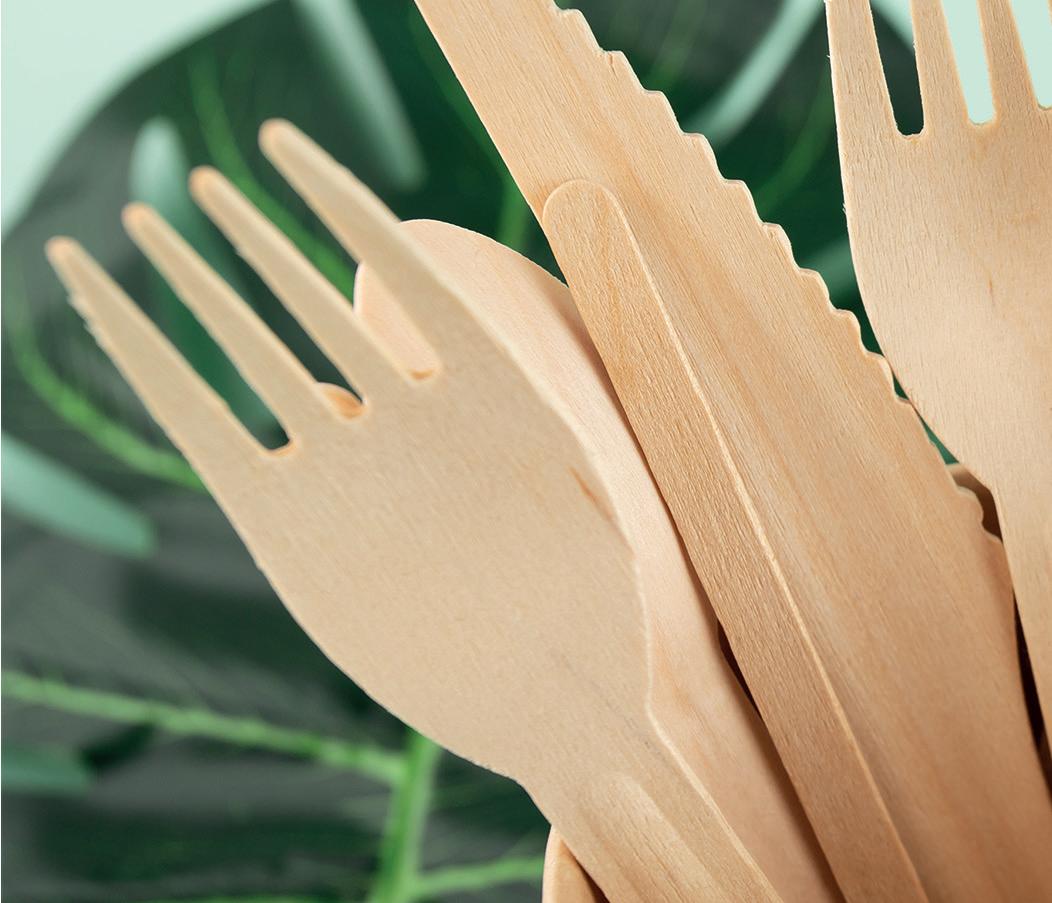
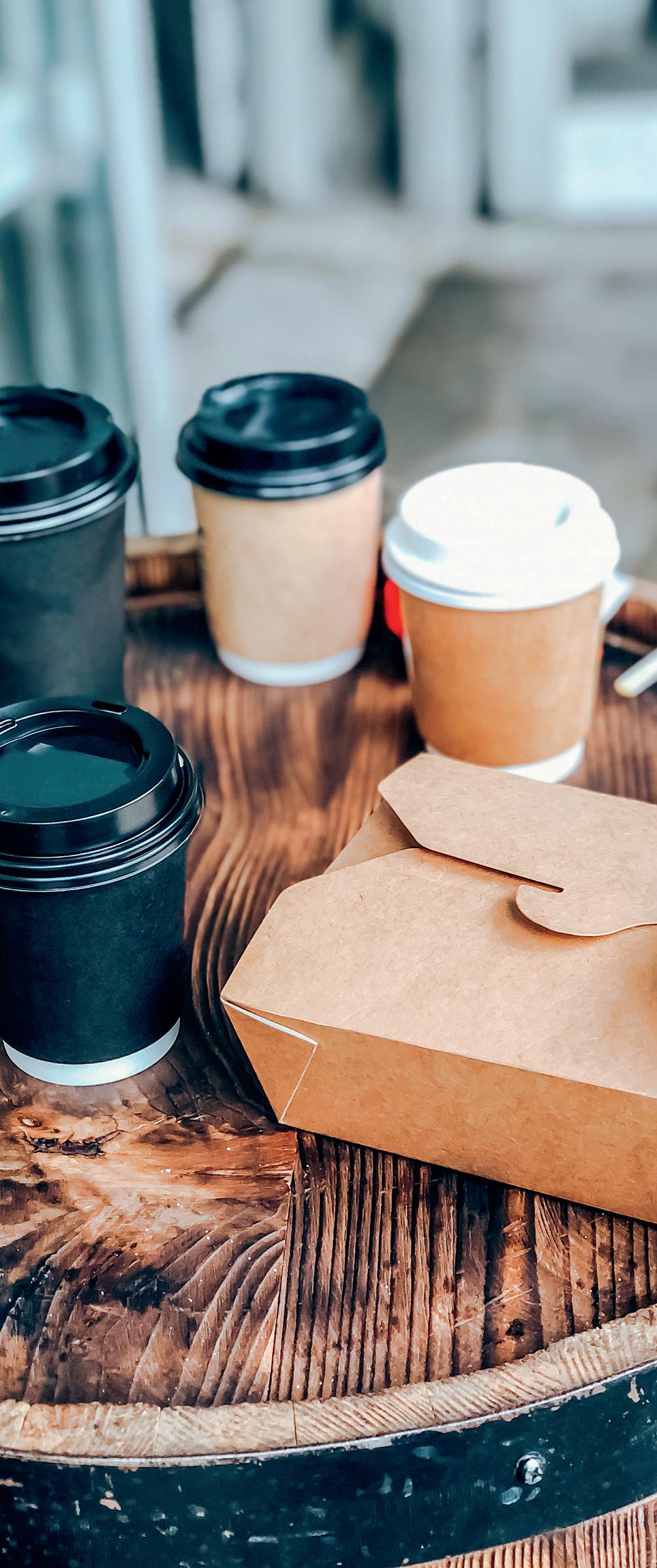
Beverages:
Hot cups; cold cups
Cup extras:
Lids; sleeves; carriers; stirrers; paper straws
Takeout food:
Kraft food containers; wooden cutlery
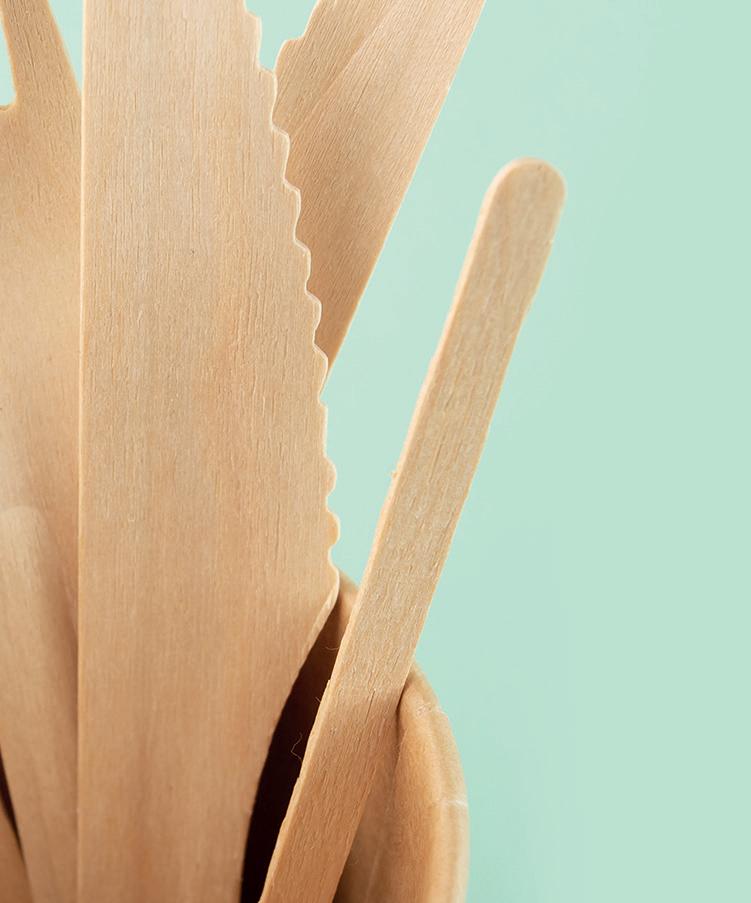
Ancillaries: Napkins; paper bags
Back of house:
Silicone baking paper
Cling film
Foil rolls
Vinyl or nitrile gloves
Rubbish bags
Plastic containers for storage
Blue roll for spills


PE Polyethylene and PET Polyethylene Terephthalate
● Enhanced protection
Polyethylene is leak-proof and can be heat sealed, meaning plastic can be wrapped around the product and secured with an airtight seal.
● Extremely lightweight
PE is light and does not require much storage space, is easy to transport, so reduces carbon footprint.
● Durable
PE is durable and resistant to external influences. HDPE –a type of PW – is puncture and tear resistant, and lower in stretching, making it ideal for packaging films.
● Excellent rigidity
Derived from polyethylene, PET offers excellent rigidity compared to other plastics. It maintains a firm protective structure and has excellent moisture resistant properties.
● Superior exibility
Low Density Polyethylene (LDPE), another form of PET, is highly flexible, soft, puncture resistant and heat sealable.
● Easily recyclable
This requires less energy to produce in comparison to other materials.
PLA Polylactic Acid
Made from renewable resources such as corn starch or sugar cane, it is a natural polymer designed as a substitute for widely used petroleum-based plastics like PET.
● PLA is certi ed industrially compostable
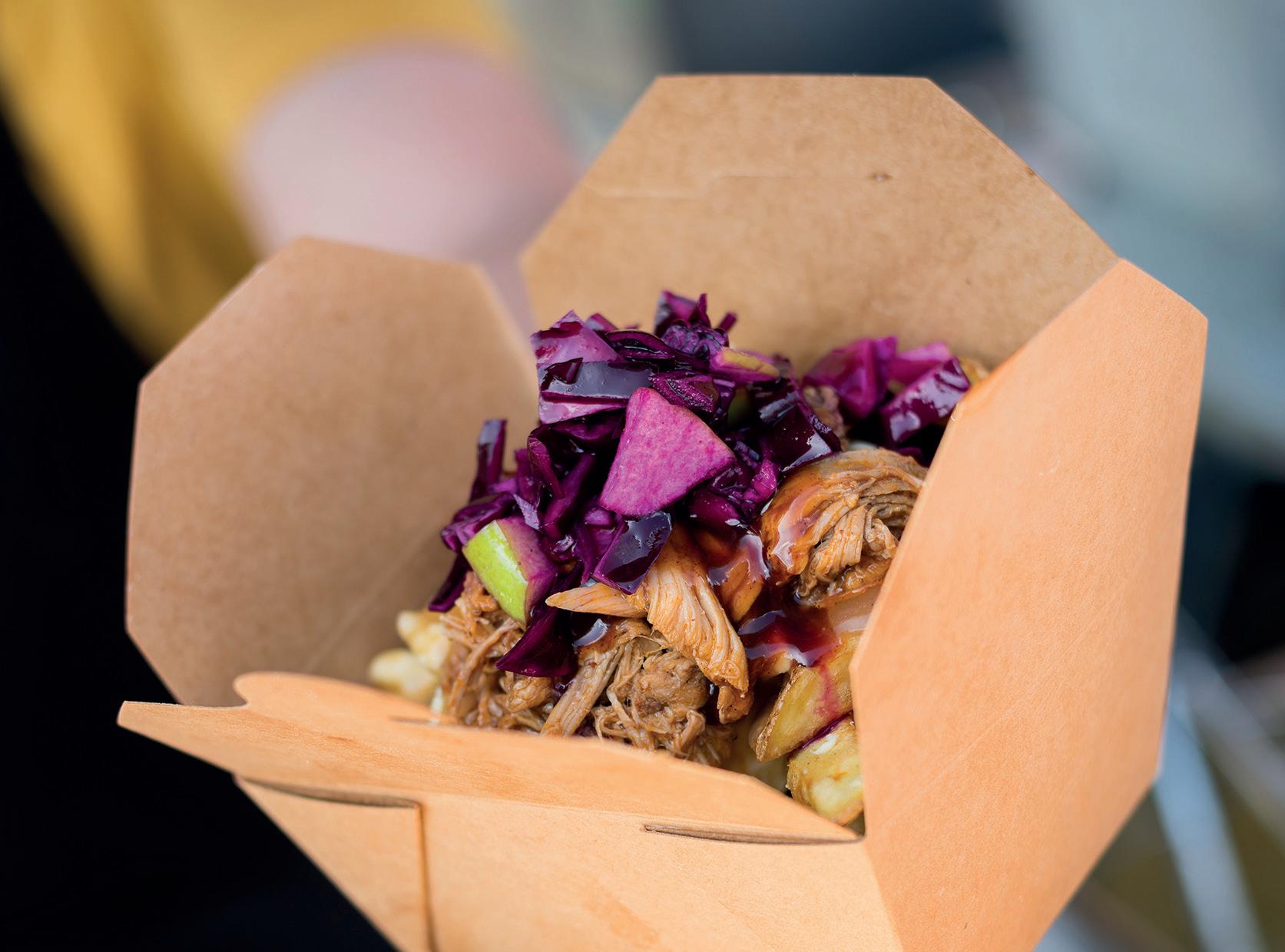
● PLA has a lower carbon footprint
Compared to conventional plastic derived from fossil fuels, fewer greenhouse gasses are created to produce PLA.
PP Polypropylene
● Biological Resistance
PP plastic does not deteriorate, or form mould caused by biological variables such as fungi and bacteria, making it suitable for storage.
● Water resistance
Highly impermeable, essential for food packaging.
● High melting point
Microwaveable, making it an excellent material for kitchen utensils, food appliances and storage.
● Recyclable
Polypropylene plastic is a sustainable material. Entirely recyclable, it can be used repeatedly.
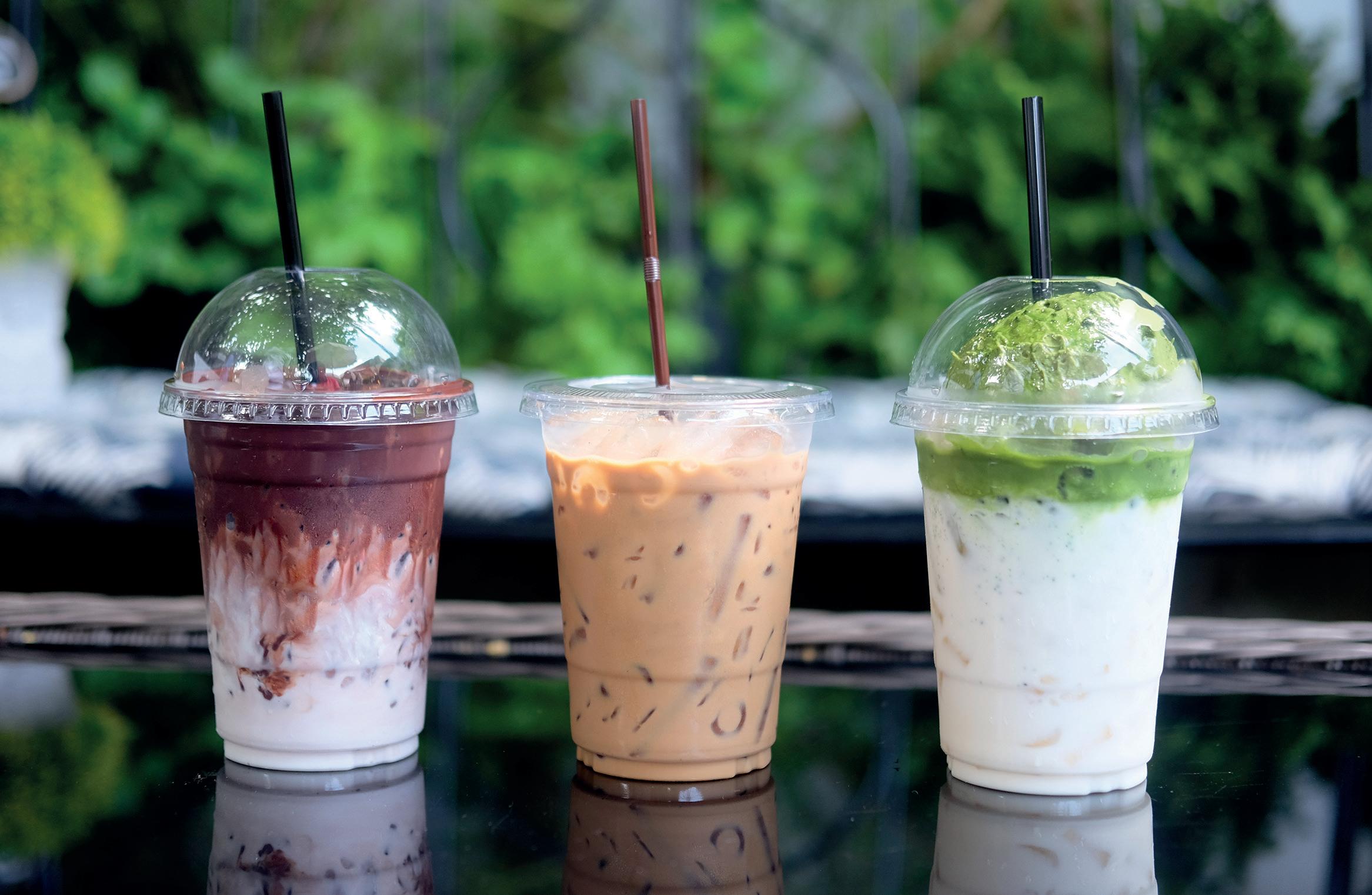


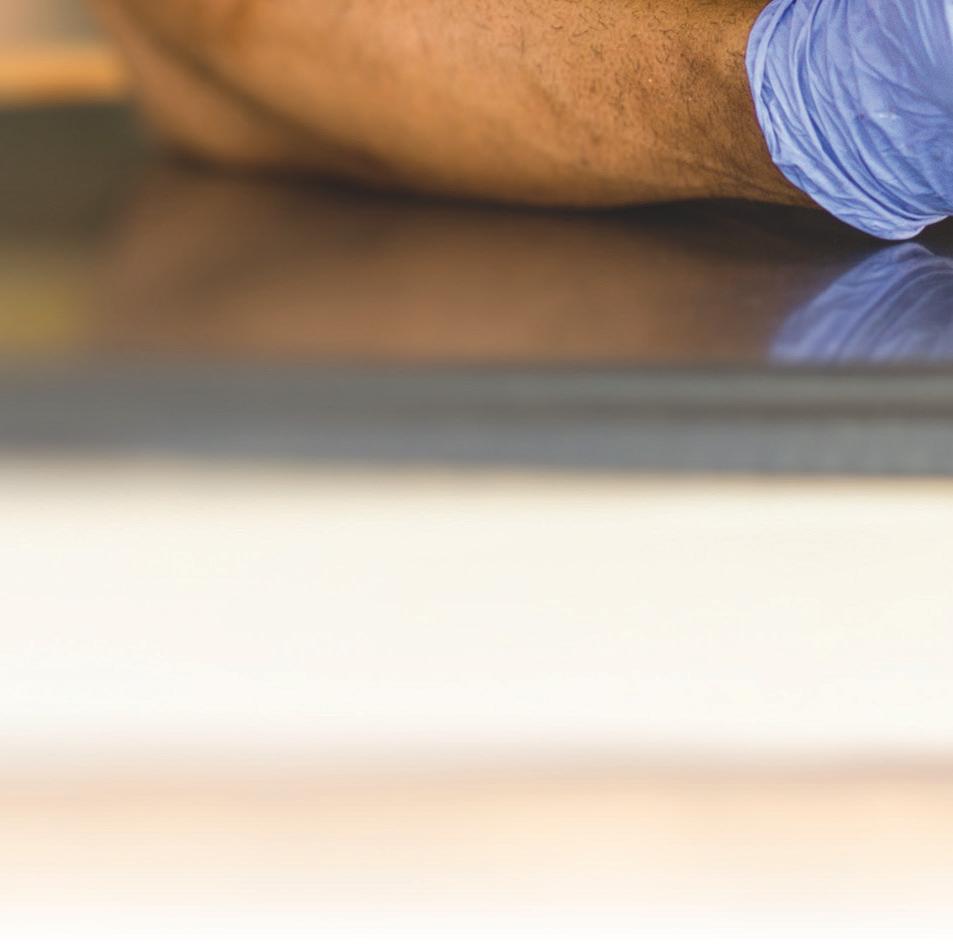
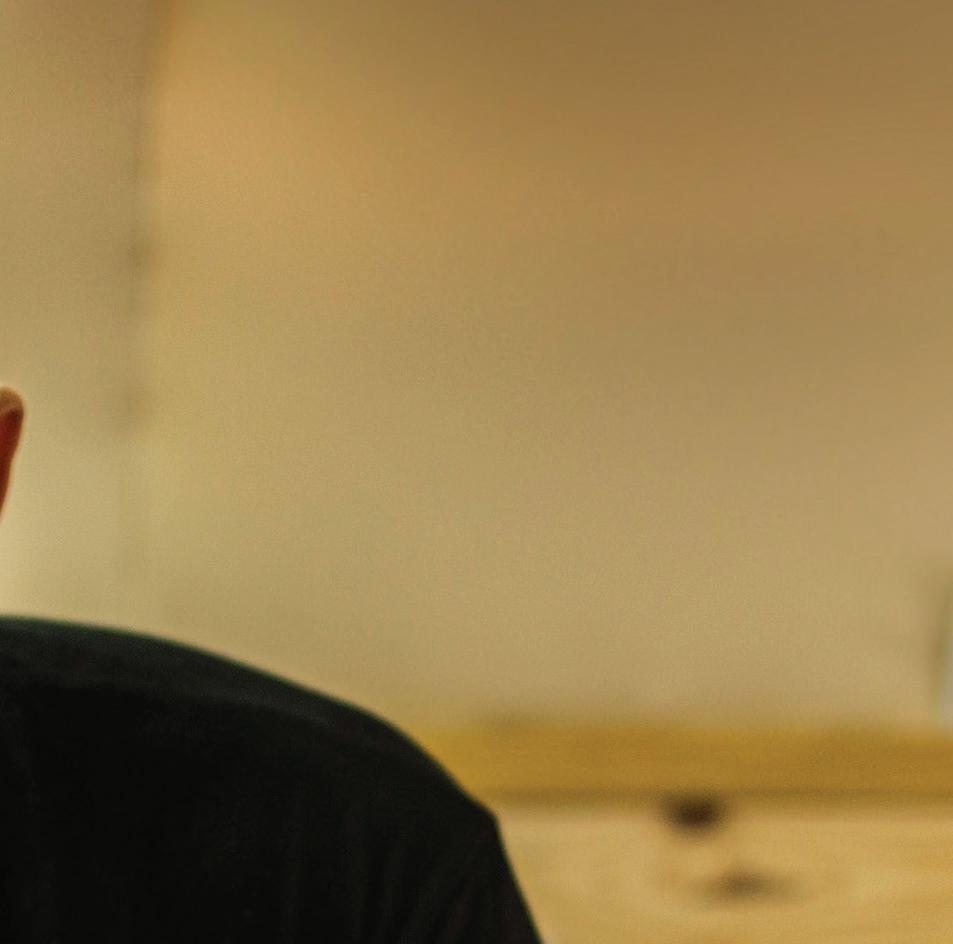
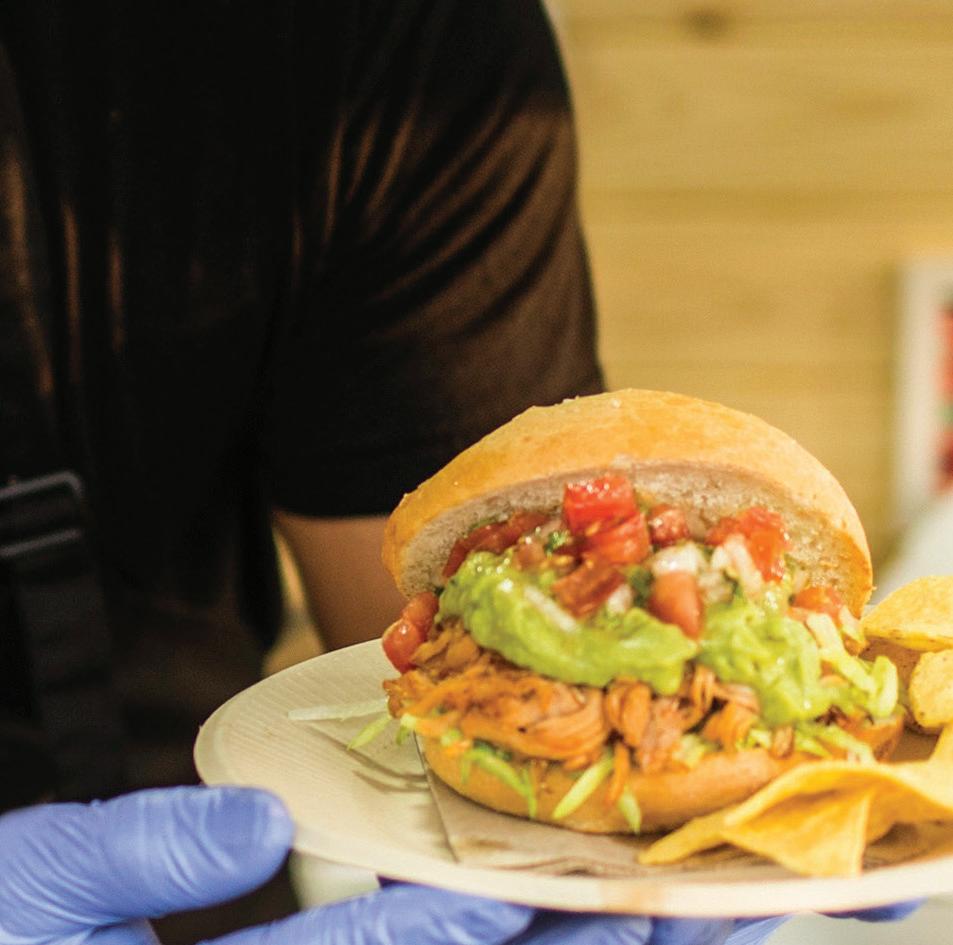
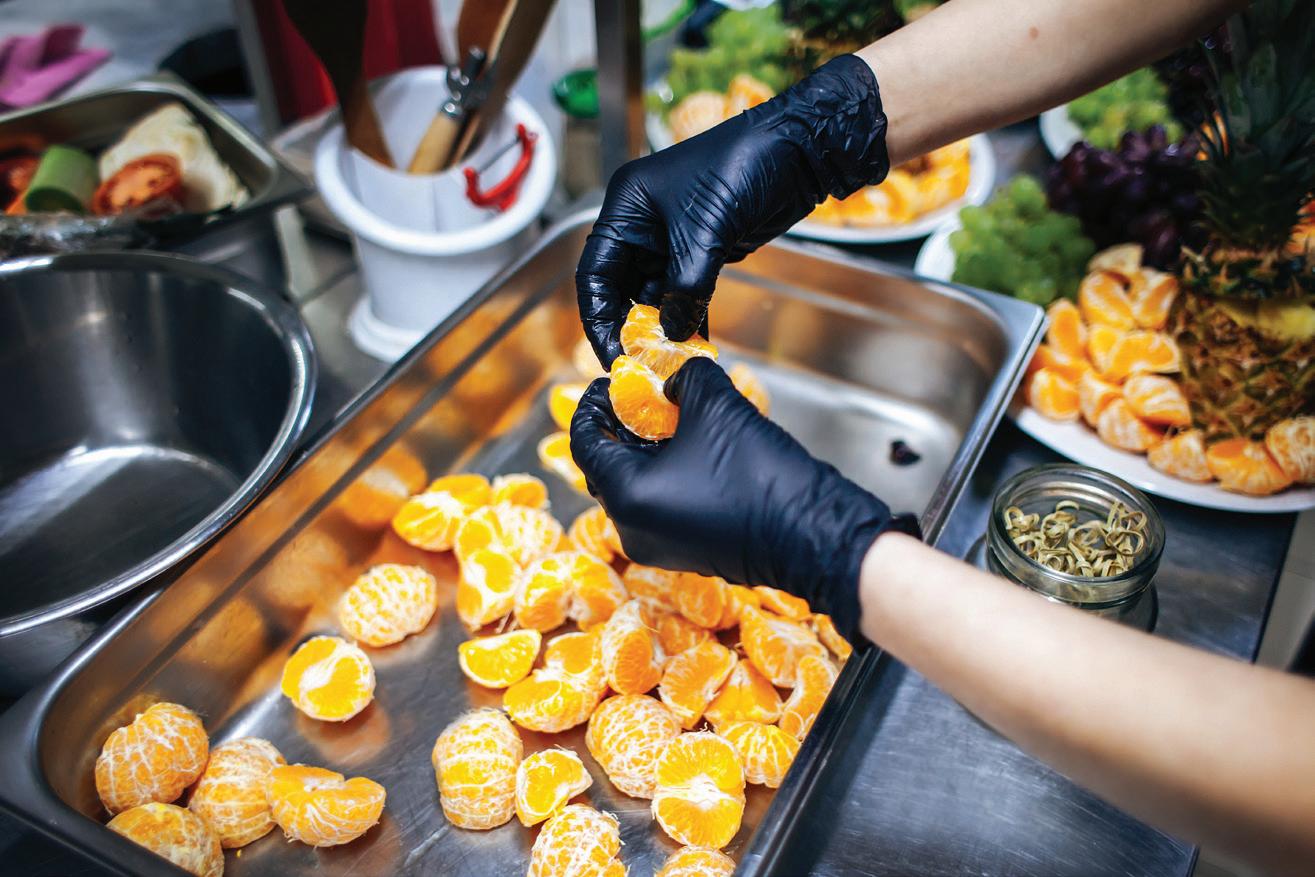

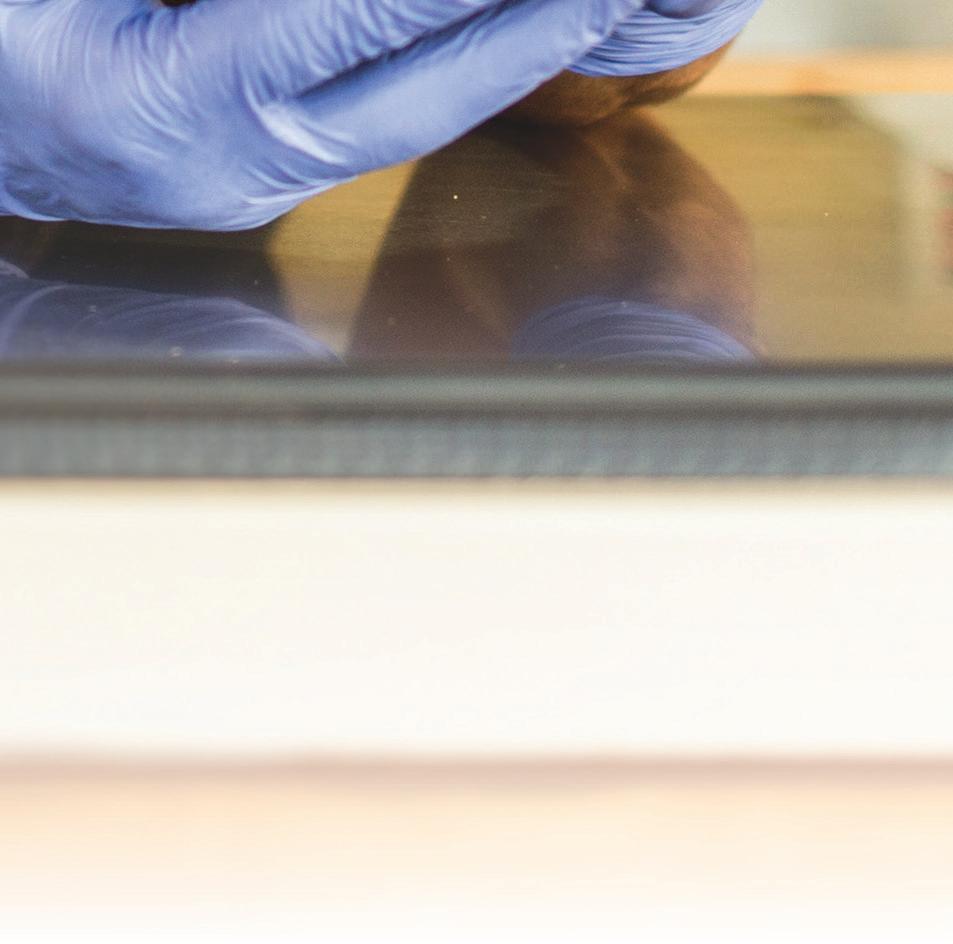
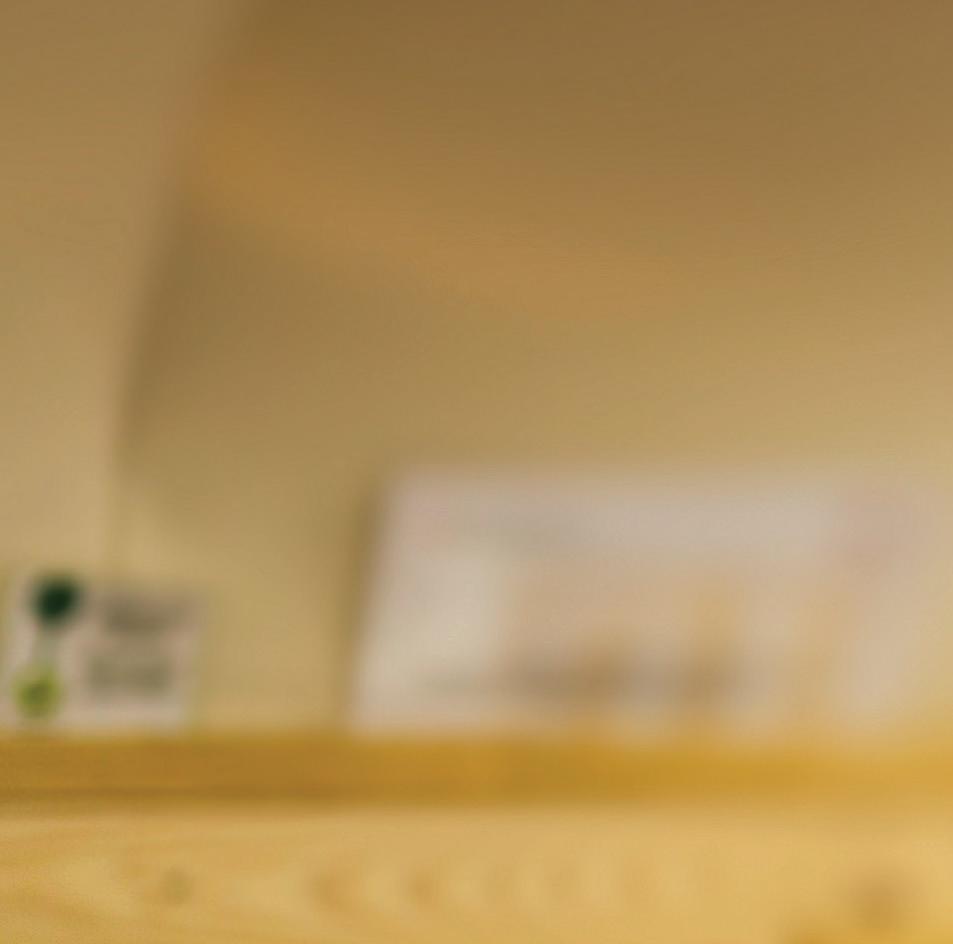
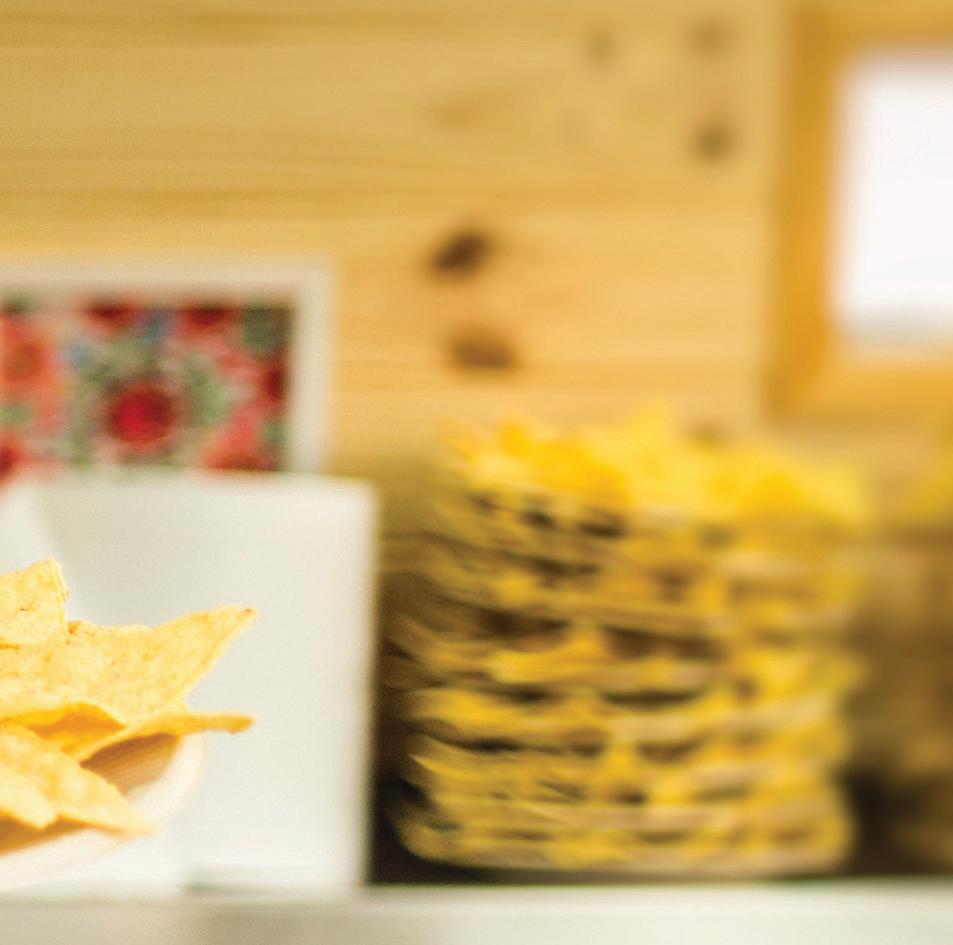
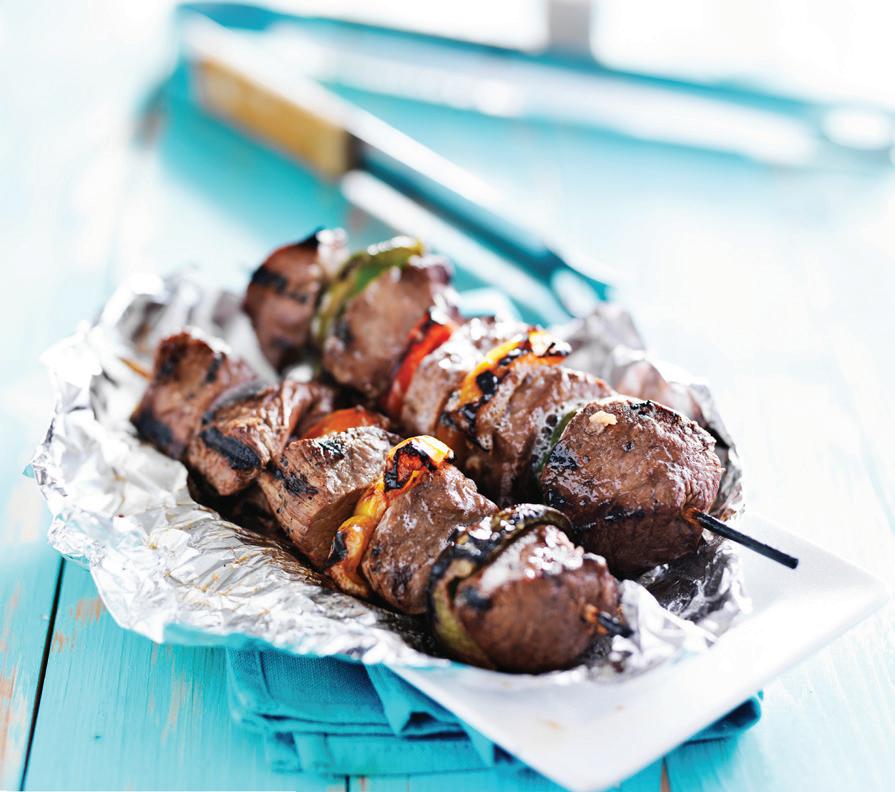



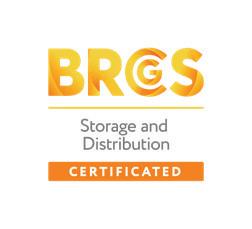
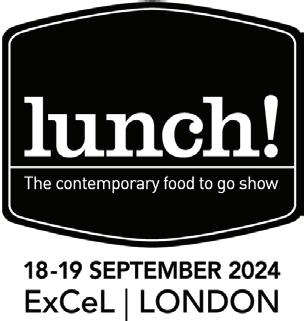

Sabert’s UK&I MD and European commercial director, Alex Noake, on sustainable packaging choices to build your brand.
Standing out in a crowded marketplace is always a challenge, and if you are opening or developing a co ee bar, then you know you’re competing with established high-street chains and other independents. Branding and positioning are therefore crucial, and you need to decide why you are di erent or better.
Great co ee and tasty food, with excellent customer service, is a good place to start and will help
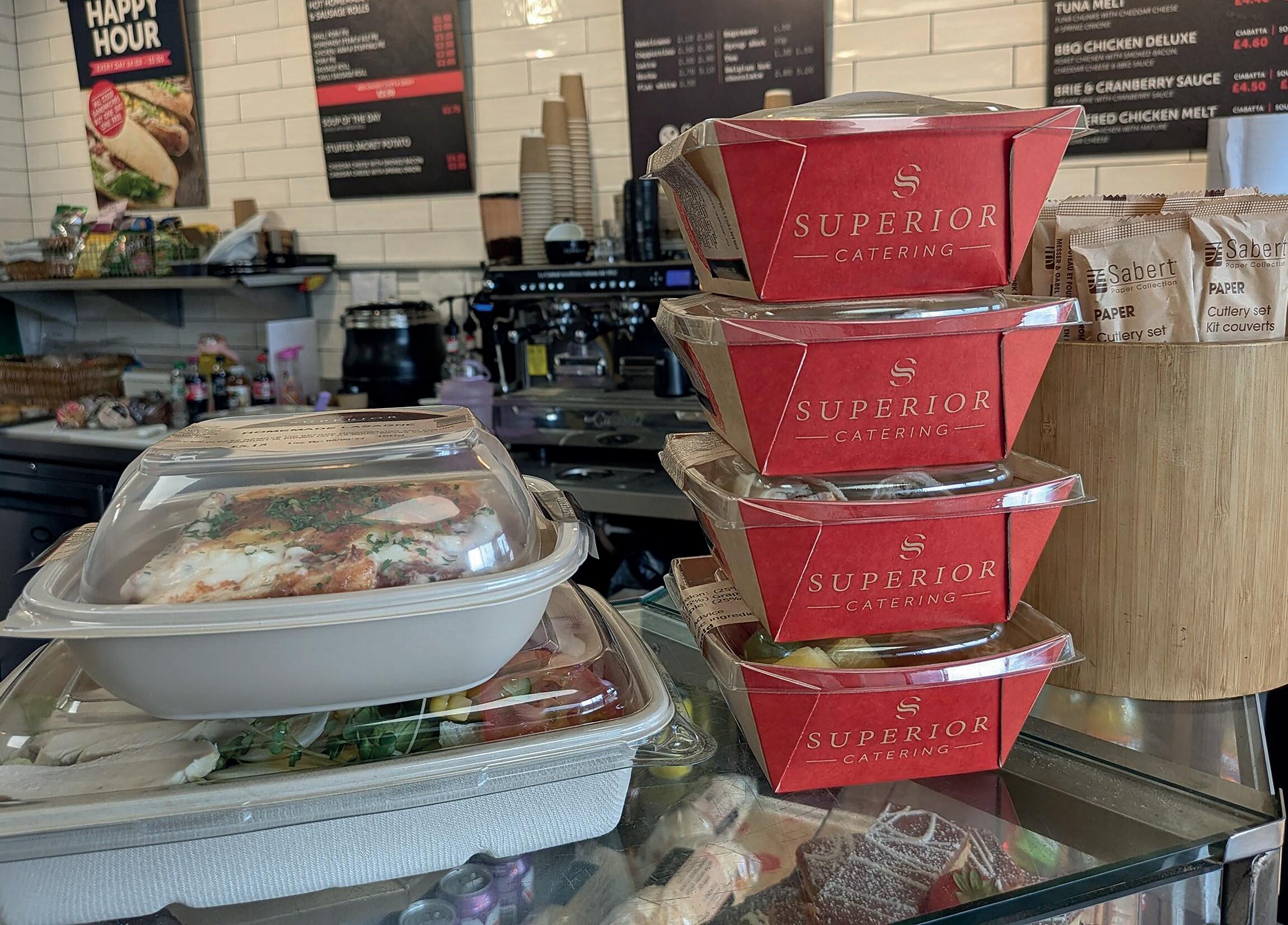
build reputation over time, but communicating your values will intrigue and draw in the new and potentially loyal customers you need.
Is your co ee Fairtrade? Do you champion local suppliers? Do you support local charities? Are you environmentally aware?
To ensure that you have a watertight sustainability story to share, check that the materials of your chosen packaging have the correct provenance, such as being Forestry Stewardship Council approved, with full FSC® chain of custody accreditation. All packaging should be fully recyclable and feature recycled content where appropriate.
A good example is our Tray2Go range, which is made using sustainable materials and fully recyclable. The board bases, manufactured in the UK, are made with FSC® certi ed material, while the lids are made from rPET at our facility in Belgium, and comprise a minimum of 50% recycled material.
There’s also our recently launched Hot2Go range, made with a unique FSC® certi ed and fully recyclable micro- uted paperboard – entirely free from plastic lamination. The design features a high-clarity, recyclable rPET lm window, with a guaranteed minimum 30% recycled content.
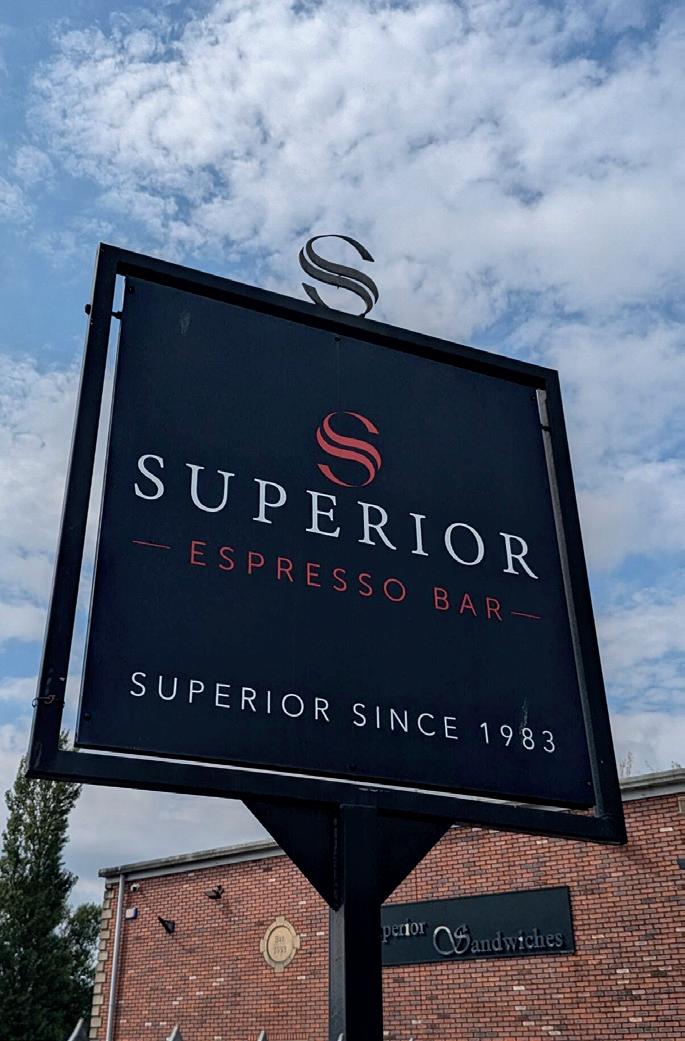
You’re going to ensure that your premises is beautifully sign-written and maybe you have a vehicle which can be liveried to promote your brand –but it should also be printed on your packaging. That will support your values in-house, and if you’re o ering takeaway food and drink, it will be exposed to a wider audience.
Sharing your sustainability story via branding is a must, and many of our
"communicating your values will intrigue and draw in the new and potentially loyal customers you need."
products support that story really well with strong messages – such as our Snap2Go range, Made in Europe, it is fully recyclable, and each one carries the printed sustainability phrase: ‘Let’s meet again. Recycle me.’
If your branded packaging is going to leave the premises, then ensure your customers know how to recycle it and encourage them to dispose of it responsibly. There’s great PR value in branded packaging, but it’s a problem for you if it becomes branded litter.
Practical and versatile packaging saves
time both back and front of house, so opt for stackable and nestable to speed up preparation times. For takeaway and food on the go, choose leak-proof packaging – easy to hold and use – to enhance the customer experience.
Products such as our Tray2Go feature a secure tting, high-clarity click-lock lid, delivering great product protection for food-on-the-go and delivery, and enabling one-hand closure for more e cient preparation in the manufacturing process. Snap2Go features a secure, snug- tting anti-fog rPET clip-lid which protects food, while o ering easy one-hand closing.
To gain the full bene t of any sustainability plan, choose the right packaging partner, who will help grow the brand. Sabert has over 40 years’ experience in providing innovative, value-added products to the highest quality standards, supported by outstanding customer service. Our mission is to o er clients the best guarantees in terms of quality, safety and service, so you could say Sabert is the ‘go-to for all packaging solutions’.

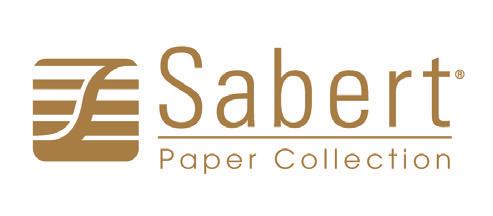


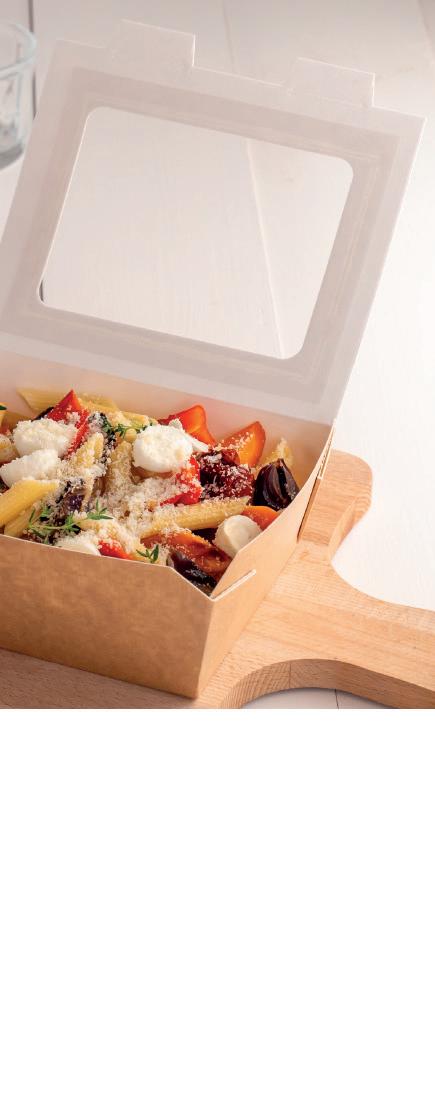
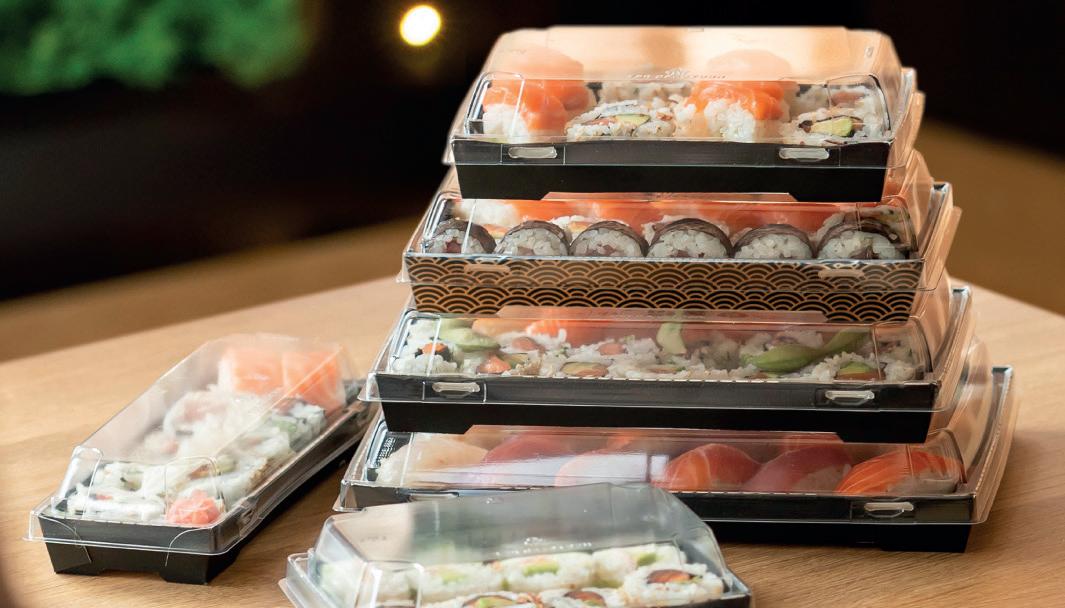




The choice of furniture is crucial. Not only is it the first thing people see upon entry, but it needs to set the tone and ambience for the venue and is likely to be one of the longest-term investments
“Budget is a primary consideration,” said Paul Muckle, marketing director at Contract Furniture, who are specialists in the hospitality leisure and care sectors – including work with 200 Degrees on multiple site openings.
“It’s essential to determine how much can be allocated, without compromising other areas. There must be a balance between cost and quality, while investing in durable, long-lasting pieces. Sustainability is another priority. Modern consumers are eco-conscious, so consider your materials or even explore refurbished or upcycled pieces.
“And whether it’s the minimalist Scandinavian look, industrial chic or vibrant, eclectic styles, the furniture should reflect contemporary tastes, while still being timeless enough to avoid the need for constant updates.
“And brand standards are vital, aligning with the overall identity. They should reinforce the desired atmosphere and experience the operator wants to offer.”
Drinking and dining alfresco is a key point of difference, with a superb
opportunity for sites to capitalise. And aesthetic consistency is a crucial theme.
“Durability and quality are imperative, albeit in slightly different ways. While indoor furniture needs to be sturdy enough to withstand daily use, outdoor requires endurance of weather, without deterioration.
“Comfort is another shared priority, with products that not only look good but provide ergonomic support. And how well does it serve the space? For example, outdoor furniture might need to be stackable or easy to move for, while indoor furniture should maximise seating without feeling cramped.”
When it comes to common mistakes, new café operators must ensure the floor plan is optimised effectively, with space often at a premium.
“Overcrowding with too much furniture can make things feel uncomfortable, while too few seating options can limit customer turnover and revenue potential. It’s a balance between comfort and capacity.”
Another frequent mistake is not considering the style that best suits the
Trends, comfort, interior, exterior, durability, expense… all key considerations for those furniture decisions.
target clientele. Furniture should be chosen with the customer base in mind – what appeals to a younger, trendier crowd might not work for a mature, traditional audience. Styles should align with the overall theme, while catering to the intended demographic.”
Ultimately, the bottom line is financial – and Contract Furniture has a variety of options to accommodate. “Value for money is at the core of our approach. We aim to be the market leader in cost-effective solutions, without compromising on quality. We achieve this by sourcing materials efficiently, streamlining manufacturing processes and passing those savings on to customers. We offer a range of options at different price points, allowing operators to choose pieces that fit their budget while still achieving the desired look and feel.
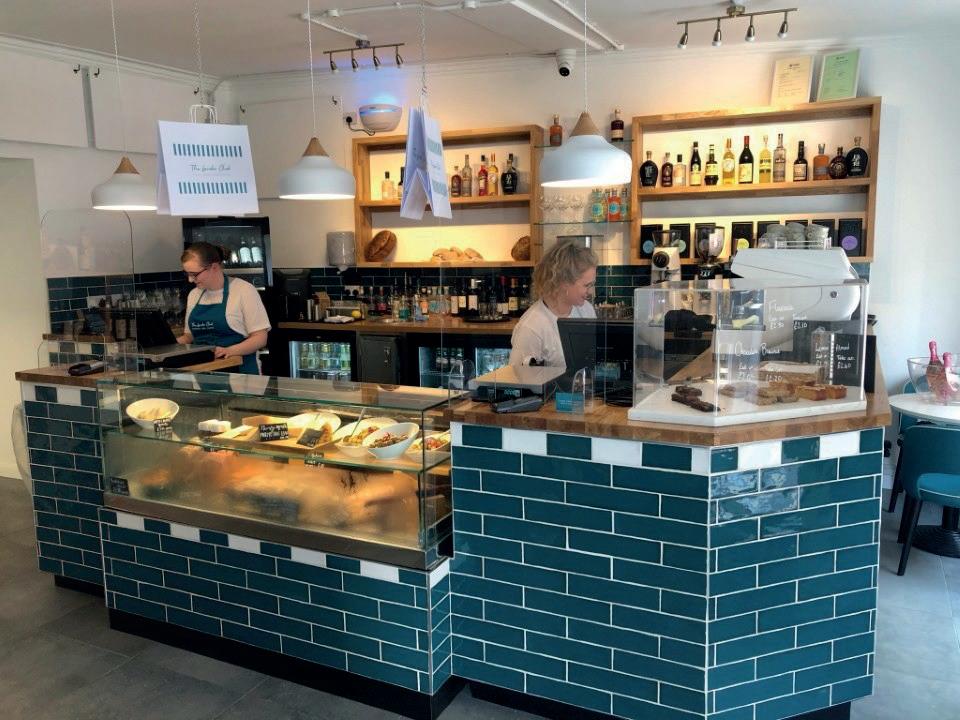
“Our commitment to durability and value means customers invest in furniture that not only looks good but also stands the test of time, reducing the need for frequent replacements, saving money in the long run.”
While cafés seek out their own unique personality and identity, key trends have emerged in recent years.
“We’ve observed a significant shift away from traditional timber seating towards upholstered lounge seating. This reflects a growing desire for comfort and a relaxed dining experience, especially in settings like cafés where customers often spend extended periods of time working or socialising. Upholstered furniture offers a softer, inviting look and feel.
“But to stand out, operators should focus on a unique aesthetic that showcases their brand values. This could involve distinctive styles, custom finishes or bespoke pieces.
“A café emphasising sustainability might choose furniture made from reclaimed materials, while one that
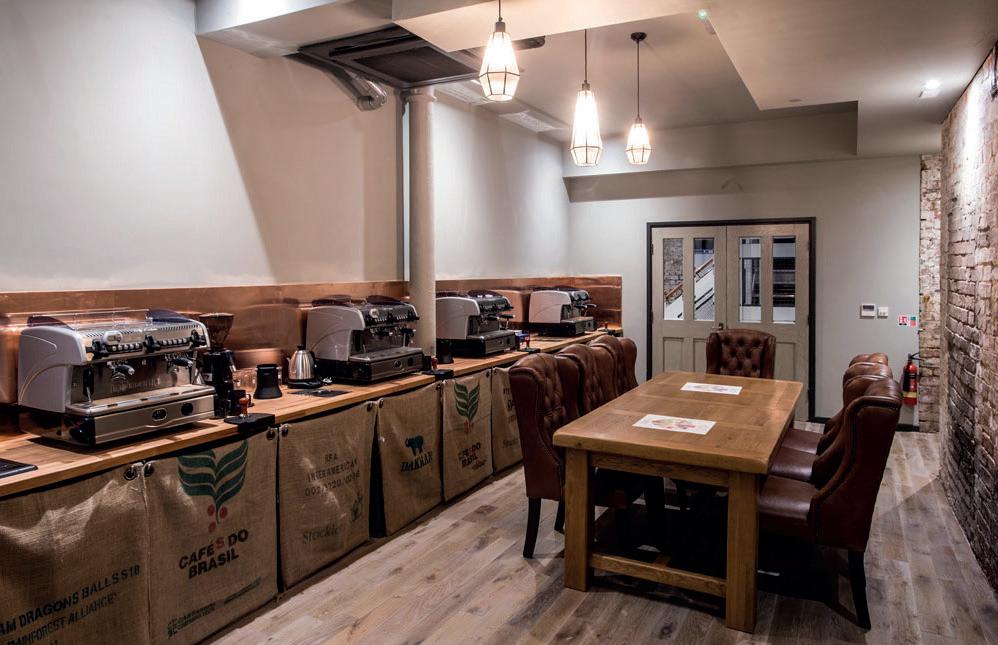
wants to evoke a vintage charm could opt for retro-inspired pieces. The key is to create a lasting impression.
“Each project with 200 Degrees has allowed us to showcase our ability to tailor solutions to a rapidly growing brand, while maintaining a consistent look and feel across locations. This collaboration is a testament to our delivery capabilities on large-scale, multi-site rollouts, ensuring each one
meets the standards expected by the client and their customers.
“But don’t forget sustainability – which is at the heart of what we do. We offer a refurbishment service called ‘Refresh, Rejuvenate, Refurbish’, providing an option to update existing furniture rather than purchase new items. This extends life, reduces waste and supports a more sustainable business model,” concluded Muckle.


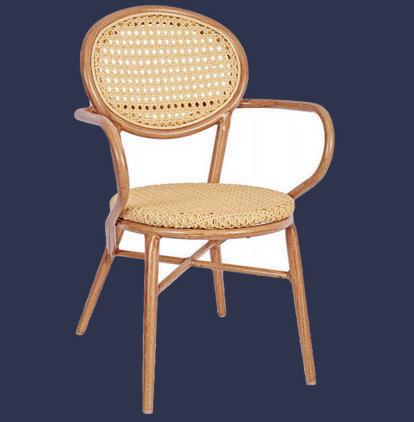
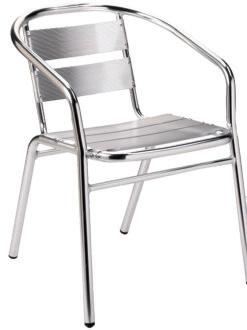
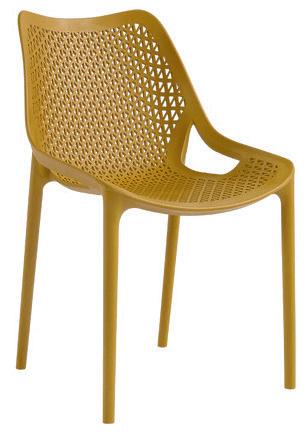

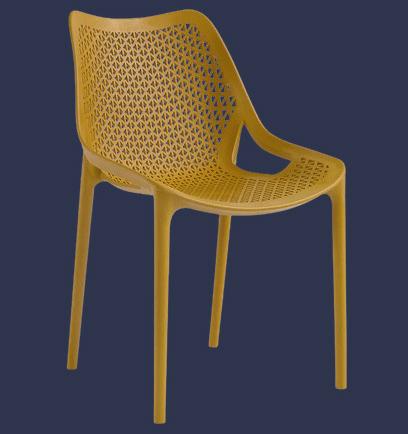
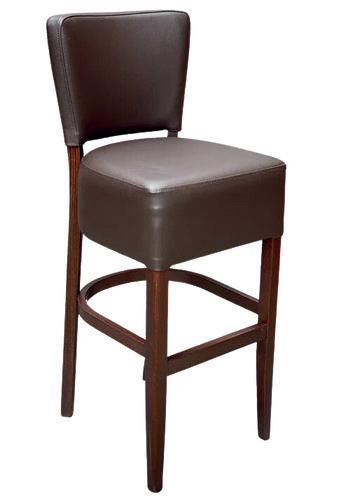


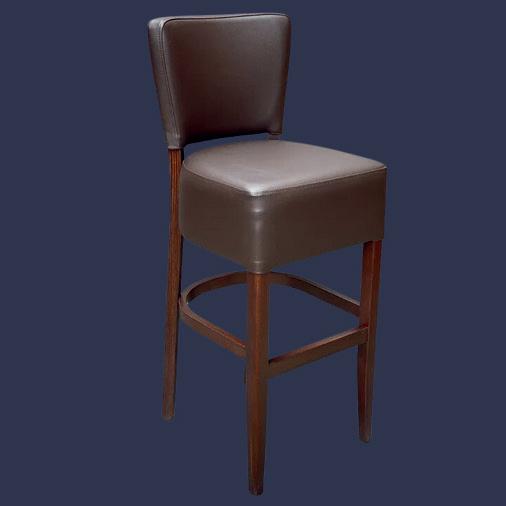
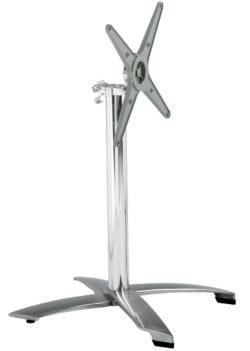












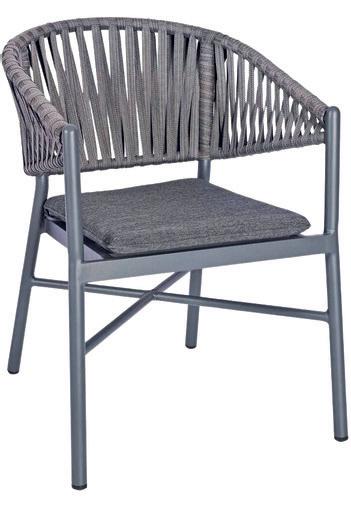






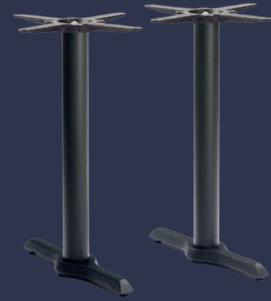
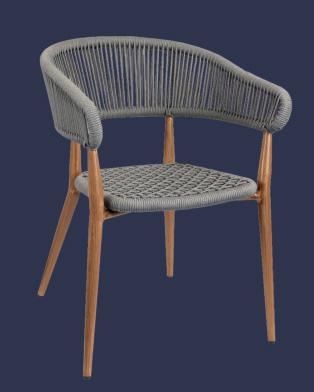
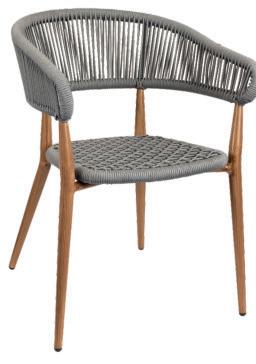



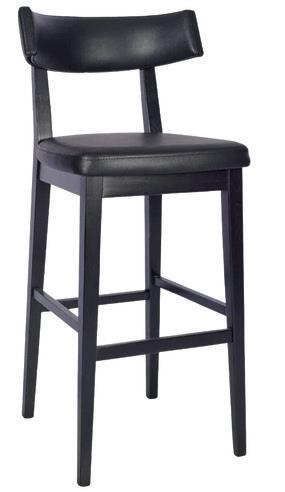


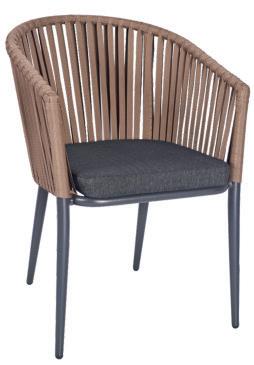

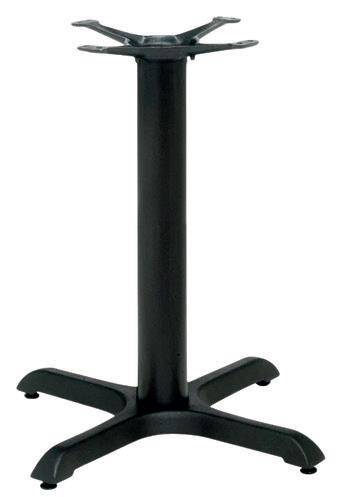

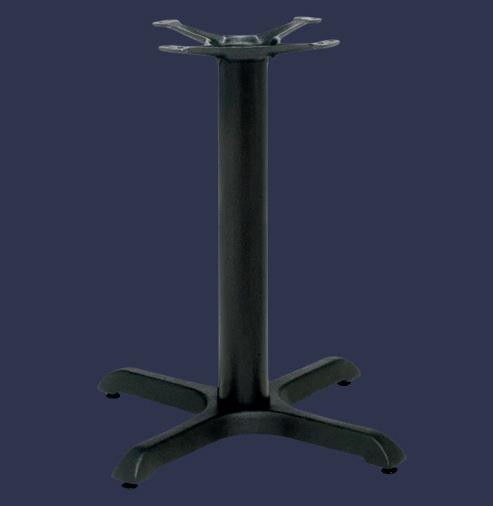

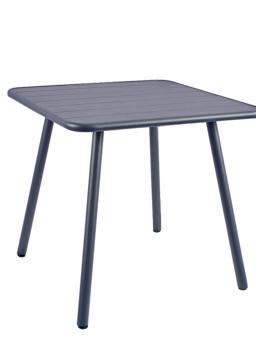



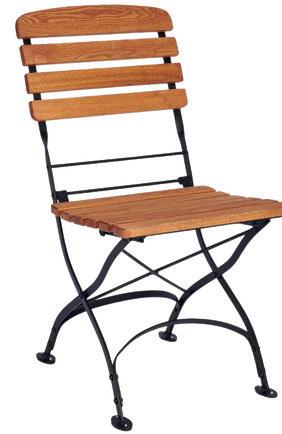

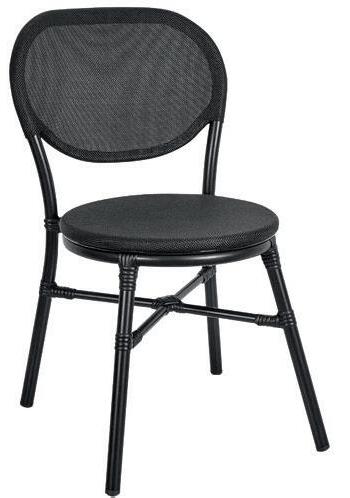



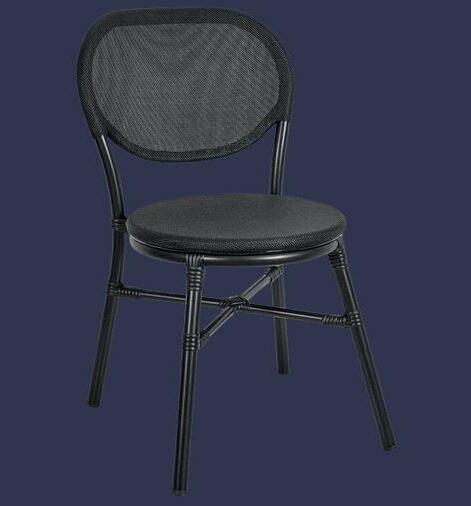
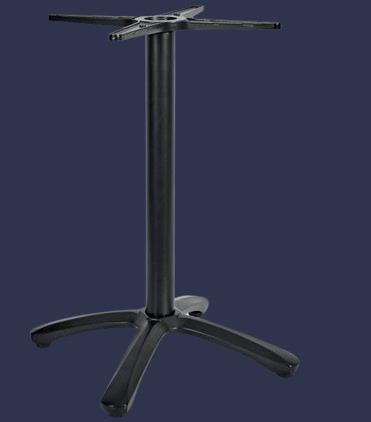
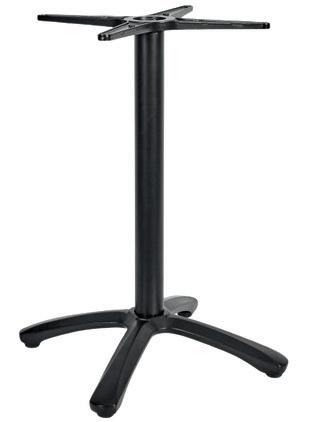

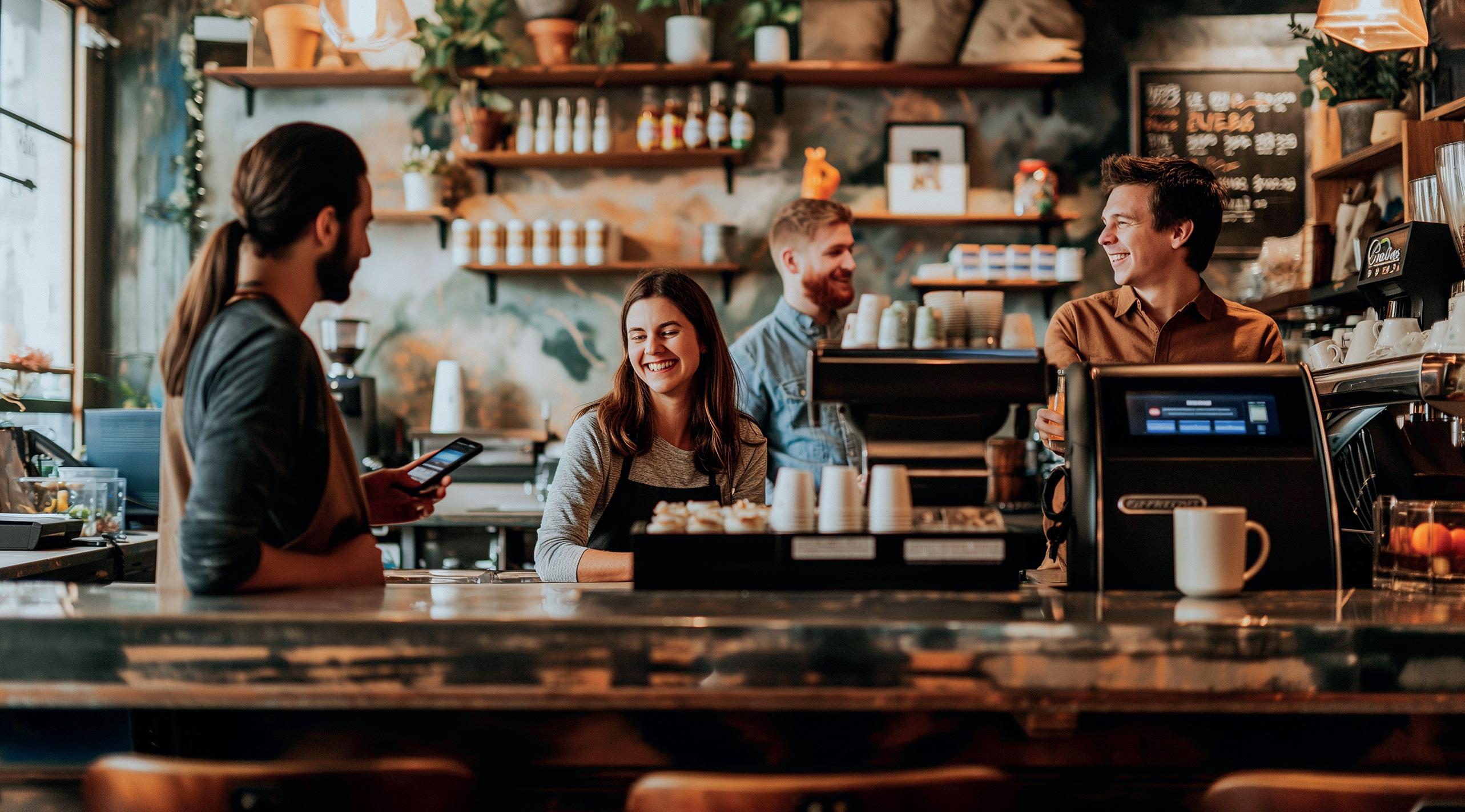
Howard Gill, head of coffee at Grind, shares his thoughts on how to keep the tills ticking over, while seeking inspiration from others.

IN THE KNOW
Coffee shops have been essential to social life for centuries. They’re places we go regularly, and (in the good ones) everyone’s really friendly, meaning you get to know the staff and they get to know you. You share news, you try tasty things, you see each other on good and bad days – I’m still friends with people I met as customers years ago!
Recent research by BRITA Professional found over a third (37%) of Brits spend more time in coffee shops and cafés than other high street destinations, which I don’t find surprising at all. Despite this, it’s really challenging to be an independent coffee shop team right now.
The economic situation is tough for small businesses, as rent and other costs are so high. This puts immense pressure on keeping sales strong and those tight margins positive, which in turn can be really exhausting for the teams behind the coffee.
However, there are a huge number of people who adore a cup of Joe! Rather than thinking about competing with other specialty locations, at Grind we try to focus on what makes us stand out. Here are a few of my thoughts on how coffee operators can find their own inspiration and creativity to help drive sales.
At Grind, we’re always thinking of ways to shake up our menus. Although we love to generate ideas ourselves, it’s really useful to take inspiration from trends popping up elsewhere.
Following the seasons is always a good starting point. BRITA Professional’s research found that new food items and recurring seasonal drinks were among the most popular elements to entice customers into a coffee shop.
For example, iced drinks are everywhere, as is always the case whenever it starts to get warm for 10 minutes in the UK. This year feels as if the cold drink trend is so strong that it will continue into winter, so it’s worth considering that.
Lean on your team to come up with suggestions and test them on each other before going to the customer. Maybe we won’t serve spring onion lattes this year, but who knows what will be next.
Striking the balance between consistency and creativity can be really difficult. I often think it’s the creativity that will bring someone in, but delivering the classics in style also creates a loyal customer. That being
said, you want a varied offering that will allow customers to freshen things up once in a while, as a change in routine can help spark creativity.
Consistency is something that the large chains deliver really well, and specialty coffee brands need to consider. A great way to do this is to create consistently great-tasting coffee by eliminating fluctuating factors like water quality. Tech like BRITA’s PURITY C iQ monitors and adjusts its filtering for the water entering your coffee machine, keeping it at the right balance to unlock the best flavours.
It’s important to remember that consistent doesn’t mean we need to remain static. My advice would be to have fun with it; be consistent in your newness. It can be a great talking point with customers, even those who stick religiously to flat whites.
When it comes to sources of inspiration, I feel lucky to live in London and be surrounded by so much art and culture. I absorb it all and try to let it inform my whole life, especially my coffee!
While a gig isn’t exactly going to trigger a groundbreaking new matcha latte, feeling empowered and inspired

to experiment is what I constantly need.
Perhaps more tangibly, I love visiting other sites. Formative Coffee and Nostos are both at the cutting edge of barista competition-style coffee. Forts in Margate has an amazingly creative food menu, making it exciting to visit.
And places closest to me have the best vibes. Moko in Tottenham offers a Japanese-style listening bar and incredible DJs for music and coffee

lovers. And Moloko serves its own delicious roasts from Seven Sisters tube station, which is a unique vibe.
It’s these locations that clearly have creativity pumped into everything they do that win loyal customers (including me), who will in turn tell their friends. I also love to follow coffee places in other countries and see what they’re up to – they always have great ideas that inspire me daily.
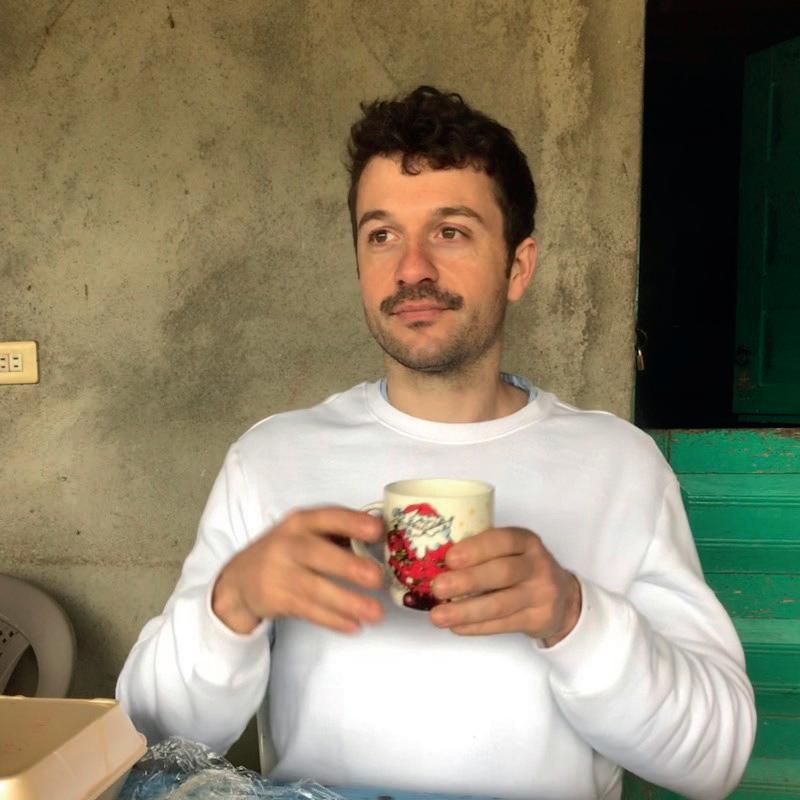
Howey Gill is part of the BRITA Professional Grounds of Innovation judging panel, an annual award that celebrates coffee shops as creative hubs within their communities.
Find out more about the awards at brita.co.uk/grounds-ofinnovation-2024.
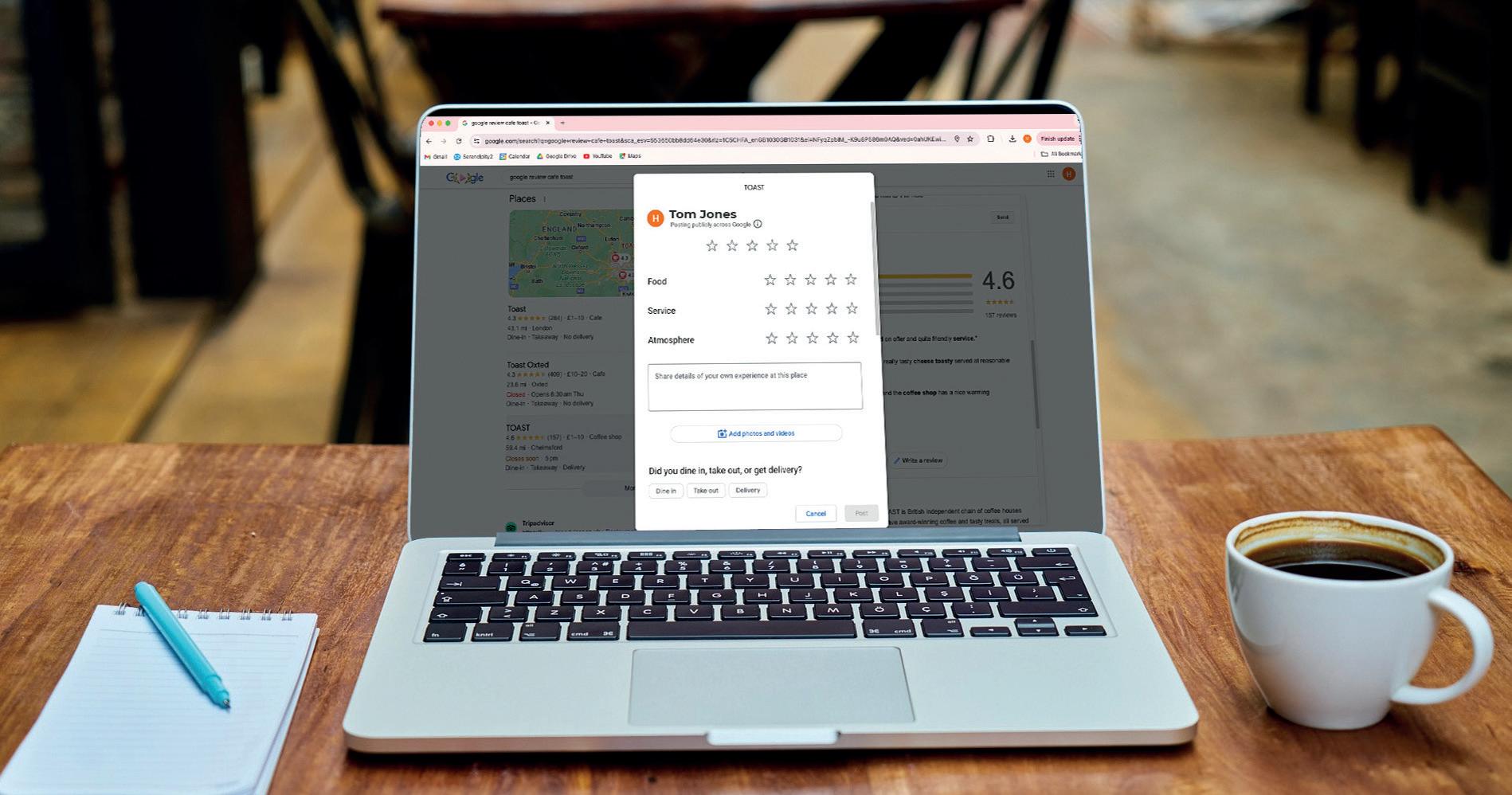
Starting and running a café can be a fulfilling venture but requires careful planning and strategic decision-making. Harriett Type of Serendipity2 is here to guide you through.
1. Know your consumer
Regardless of what your brand offers, fundamental to success is that you know who your target audience/s are and who they aren’t. This understanding will help you on many levels from the brand look and feel, designing products and services, outlet location and so much more.
It will also allow you to develop meaningful marketing communications, enabling you to target the right people with the right messages, via the right channels. This, in turn, vastly improves media targeting and produces more effective ROIs. Additionally, if all branding and marketing is based on the target audience and their wants and needs, it will differentiate your brand from competitors, as it resonates more effectively and will be closer aligned to your consumer values.
The best way of identifying a target audience is through research. A combined approach using online surveys (quantitative research) and focus groups (qualitative research) means a brand can home in on those most likely to visit your venue.
2. Location, location, location
While it might feel like a cliché, the old adage continues to be critical when opening a new outlet of any kind – and is especially important in food and beverage.
It’s no longer sufficient to rely on gut feeling or intuition. With the dramatic
"Identifying the best location can be complex. Get it wrong and expect to see diminished returns."
changes in retail on UK high streets, the uptake of delivery apps and consumer behaviour changes post Covid, it’s not enough to open an outlet in a popular street and expect instant success.
By using the power of locationbased data analysis, brands can make informed decisions that increase their chances of being profitable.
Identifying the best possible location can be complex. However, this process should be embraced as an essential aspect of a successful expansion strategy – and is just as important as the outlet fit-out or recruitment drive. Get the location wrong and expect to see diminished returns.
With access to a huge wealth of data and technology platforms, brands can now identify a location which is based on data science, mitigating much of the risk. This includes everything from social demographics (ideally identifying target audience), competitors, footfall data, local transport, retail hubs and attractions to name just a few sources. Additionally, other data – for example, outlet sales – can be overlayed to provide a blended overview.
Expansion is not simply a ‘one-sizefits-all’ process. More and more we see what works in one location may not be suitable for another, due to the intricacies of that specific venue combined with the brand and its

target audience. Location-based data provides the guiding light and removes many of the unknowns.
3. Be data driven
Whether the new outlet is the first for the brand or the 85th, ensure that you are set up to collect the right data from the beginning. What you obtain can be wide-ranging and effective, while
analysis may need initial investment. However, data driven decisions will ultimately become a major asset.
Invest in an EPOS sales system with granular data capture – an effective reservations platform which links to your Customer Relationship Management (CRM) and menu engineering. Ensure you can match the data and loop it through, to see the
whole story. For example, can you identify who orders which dishes, and when, plus the value of that transaction in terms of margins?
From a marketing, sales and operations perspective, this provides you with a wealth of opportunity to maximise efficiencies. You can identify best-sellers with the highest margins, create appealing upsell opportunities and support white space periods and drive traffic. Menu engineering can increase profit by 10-15%1
With an attuned reservations system, you can also identify which guests align best with your core target audience and where they live and work. Translate these into marketing opportunities by developing campaigns which promote specific products and services which you know engage these specific audiences. CRM platforms have been shown to increase profitability by 30%2
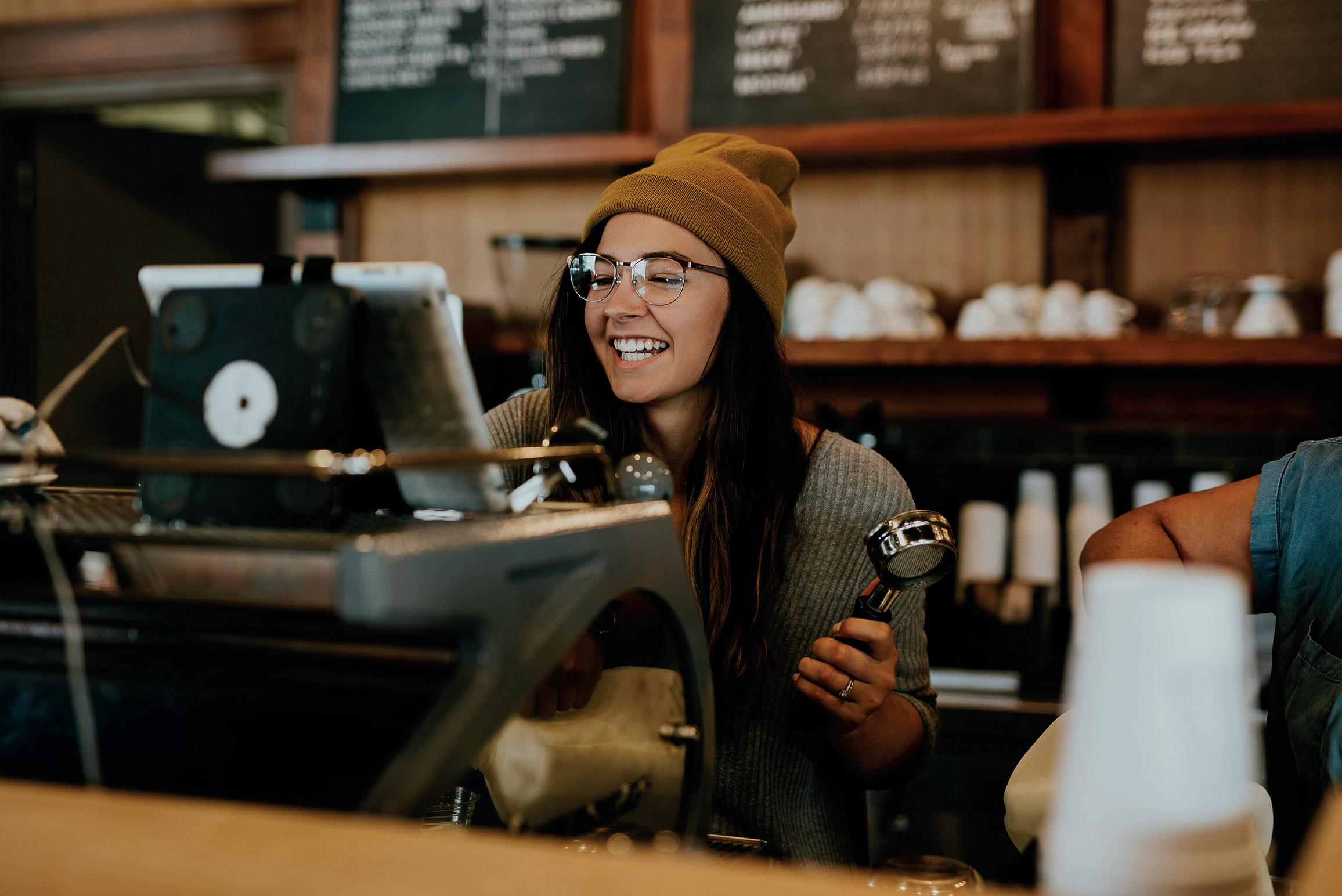
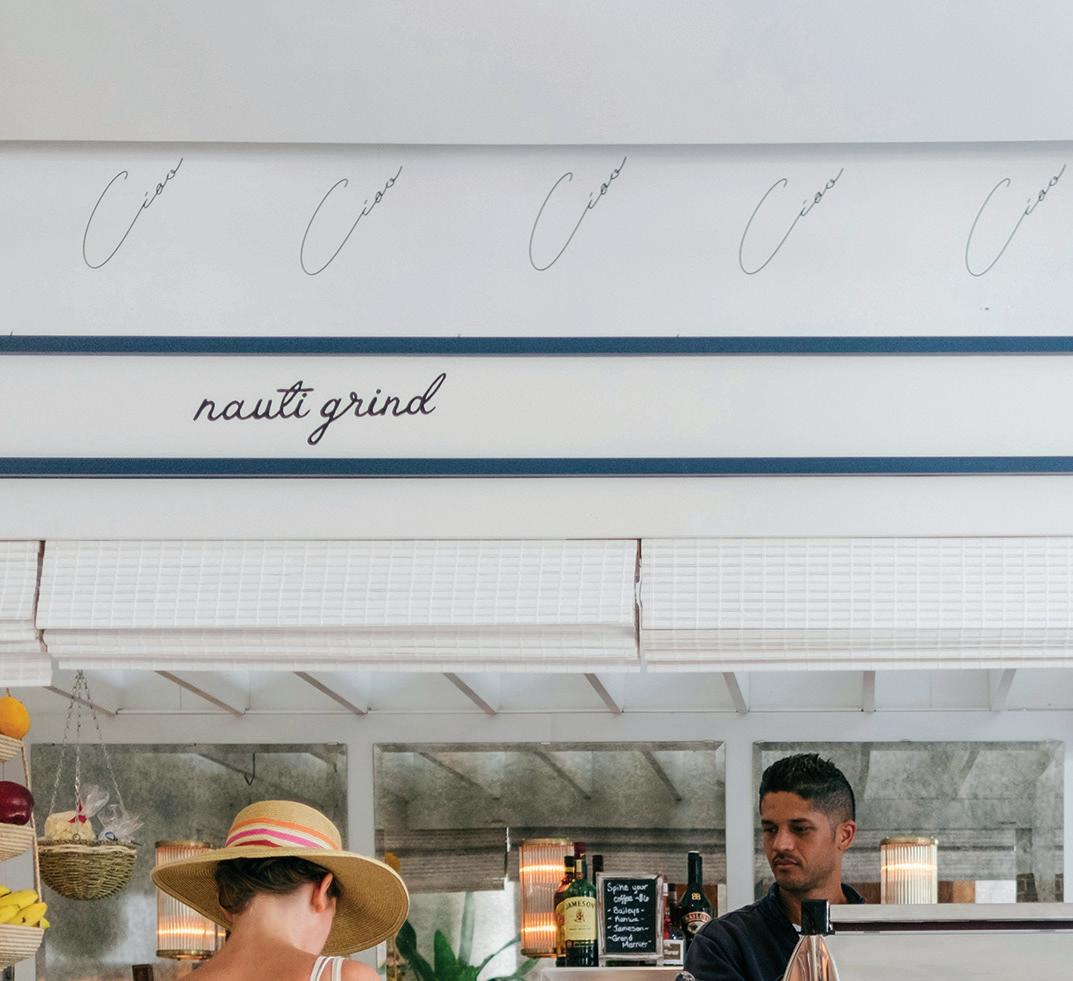


Via data analytics, assumptions and guesswork are again eliminated, meaning that risk is reduced and the likelihood of success is in your favour.
4. Focus on social proof
Social proof has become a core part of the decision-making process for millennials and younger age groups. Stats indicate that 60% of restaurantgoers check reviews before going out for a meal3.
So, develop a clear strategy to ensure reviews are maximised. Social proof cannot be a passive process;

don’t wait for feedback to flow in. Develop prompts for reviews across key sites including, but not limited to, Tripadvisor and Google My Business. The serving team can verbally prompt customers to do reviews while they are in the outlet, and you can use tent cards or posters. Post-visit follow-up emails requesting a recommendation are ideal for increasing traffic. Ensure that team members see the reviews on a frequent basis, so they know how important they are. Celebrate good reviews to ensure they stay engaged –and reward those highlighted.
The positive presence online will help drive more visits. Additionally, companies with good reviews have better Search Engine Optimisation (SEO) results, as Google gives these sites better organic ranking results.
The other natural byproduct of creating a positive review culture is that your café will be known for its customer service, ultimately driving repeat visits and more spend.
Opening a new café has many moving parts. These four building blocks work together to reduce the financial risk by not only creating cost efficiencies, but by driving the business forward and maximising proactive efforts – serving you well long after the opening.
1menucoverdepot.com/resource-center/ articles/restaurant-menu-engineering/ 2linkedin.com/pulse/bene ts-pro tabilityusing-crm-based-strategy-quaxar/ 3reviewtrackers.com/blog/restaurantsocial-media-statistics/


Harriett Type has a vast array of marketing experience having worked across a range of different sectors – both client and agency –for over 20 years, internationally and in the UK. She has developed and launched new brands, as well as partnering up with established hospitality names. She specialises in ‘go-to market’ strategies and creative execution development and delivery.













































































































































A must-have for sandwich bars, cafés, restaurants and food-to-go delivery outlets, this jargon-busting guidance covers:

• Food hygiene
• Allergens











• Labelling
• Transport




















• Employment









• Training and more
• £45 per year













































Association membership starts at £6.25 per month and can be purchased with the MINT MAX plan.






SIGN-UP TODAY AT WWW.THEMINTGUIDE.CO.UK
Use LUNCHAT10 for 10% off MINT and MINT+ plans


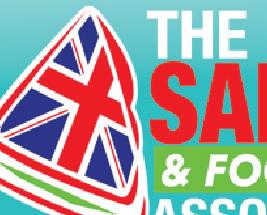

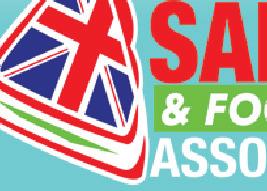



















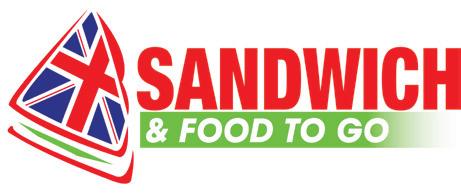






Use LETSDOLUNCH with a MINT MAX plan and save 25%

































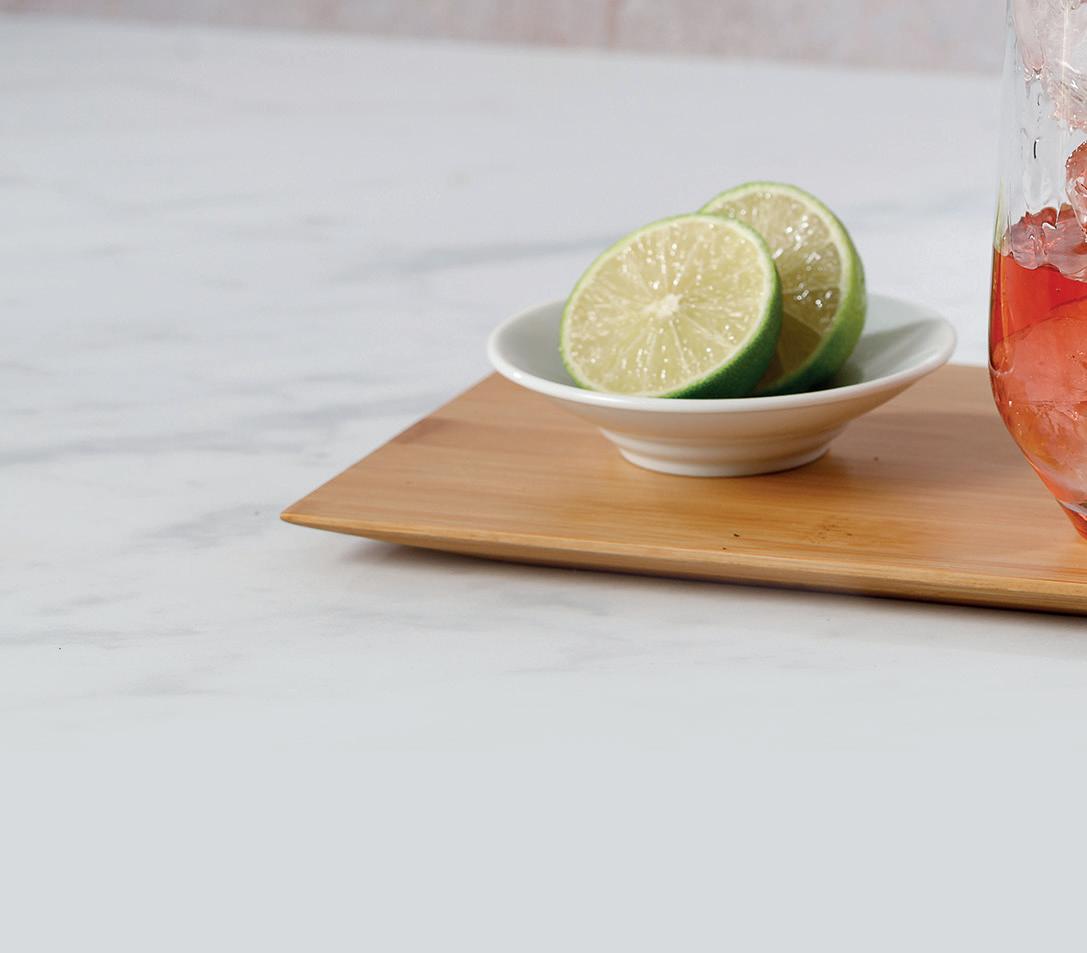

Felicity Fowler, head of
experience
explains how versatile this essential menu o ering can be.
What are the key factors a new café/ coffee house operator should consider when putting tea on the menu?



With consumer demand for higher quality drinks, whole leaf loose tea is the obvious choice for new tea services. Using JING glassware elevates the consumer experience even further, as tea lovers will see the quality of leaves, and infusion colours, knowing they’ve been served something special – a world away from the dusty teabag they might be used to at home.
As well as delivering better taste and consumer experience, loose tea is by far the most sustainable tea choice with its minimal packaging.
Finally, consumers want to know where products come from too –so thinking about the bene ts of single origin, fully traceable teas is useful. At JING, our direct sourcing approach means that we have personal relationships with the incredible people who make our teas. We love telling their stories and share their names,
plus information about the gardens, so consumers can be reassured that they are supporting the world’s best farmers while enjoying their incredible drinks.

Additionally, what is particularly prevalent trends wise as we move into autumn and winter months?
We’re getting more requests for recipes for complex milk teas – matcha lattes continue to grow in popularity, but moving towards the cooler months, consumers expect warmth and comfort. We’re experimenting at the moment with teas like Chai and even Hojicha, a roasted Japanese stem tea
Despite the slow start weather wise to this summer, the past few months have been huge for iced tea. When made with high quality and whole leaf tea, it doesn’t require sugar or excessive ingredients to be delicious –it’s also easy to prepare in advance and big batches.
Favourites from this summer include our Jasmine Silver Needle – because








it’s scented using the actual buds of jasmine owers, it has so much natural sweetness and refreshment. The team at GAIL’s Bakery has run an incredibly successful iced tea programme with us this summer. The 2nd Flush Darjeeling Tea and Strawberry combination has been especially popular.


Are there specific preparation skills and processes that are important to the tea-making process?




Yes! Tea is simpler to prepare than co ee but a little knowledge, care and attention ensures a full avoured and balanced serve – and crucially the delivery of that, ‘Wow, I never knew tea could taste this good,’ moment.

At JING, we worked with The Fat Duck to come up with recipes for tea making. Although they are based on ancient rituals, they are incredibly simple – it’s just balancing the amount of leaf, water temperature and infusion time. Our bestselling Tea-iere™ and glass sand timers make these recipes very easy to implement operationally.
Coffee has obviously impacted the UK hugely in recent decades. How does tea compete – it must be a challenge?
Tea o ers avour and taste varieties –and a exibility unmatched by co ee. There are teas that are great at all times of day – from the strong breakfast options to wake up with, those that help you focus, all the way through to sleep assistance. The avour di erences between tea types such as green and


"it offers flavour and taste varieties –and a flexibility unmatched by coffee."

oolong from di erent origins are very marked, while foodies tend to love the opportunities tea gives for taste exploration. Wellness trends tend to favour tea too – green and white have been in growth for a few years now, thanks to their high antioxidant content. Plus, more recently, awareness of the bene t of L-theanine – which occurs naturally in tea – is beginning to creep into consumer awareness and again raise the product’s pro le.


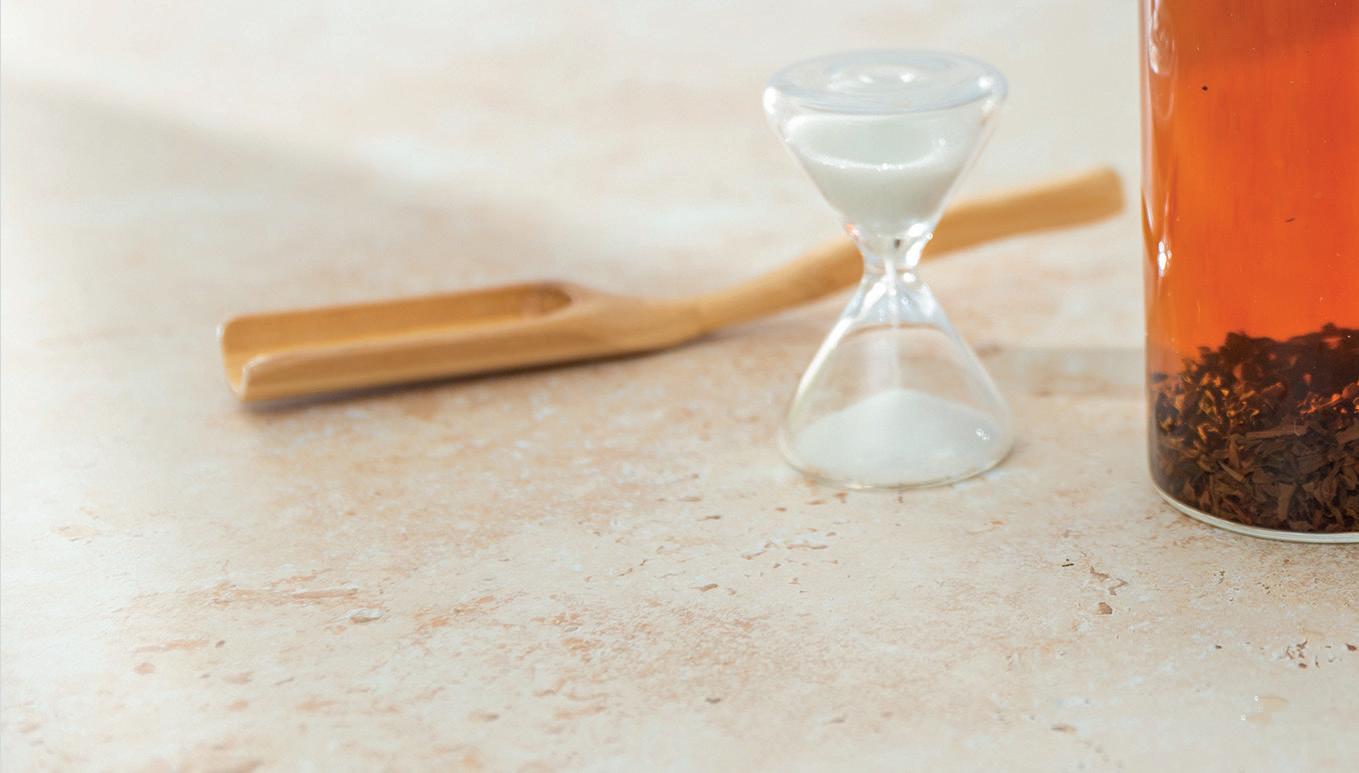

There are so many different tea flavours to enjoy. How can new businesses narrow it down?






An easy way is to select a range of teas that ensure you have options for all times of day – as di erent moments have di erent requirements. You will naturally get a good selection of avours by taking this approach.









An example of a great menu would include a strong black tea which works well with milk for rst thing. Our 3* Great Taste award-winning Assam Breakfast is an example. Moving into mid-morning, tea drinkers often want a pick-me-up, and ideally one that’ll help them focus – green teas tend to work well here or a sweet Jasmine.

Classic afternoon options include Darjeeling or Earl Grey but we are also seeing interest in the Oolong category – Phoenix Honey Orchid has some of the strength of black tea but complexity and fruity characteristics. Later, consumers like less ca eine, so include herbal infusions such as whole peppermint leaves, or zingy avours such as Lemongrass and Ginger.
What are the tea flexibilities that an operator may not have considered?

As well as the opportunities to make milk teas and iced teas mentioned above, they might also think about how well it pairs with food. We’ve recently worked on a series of pairings with this season’s Cédric Grolet pastries at The Berkeley Café – it’s so satisfying when the two enhance each other.


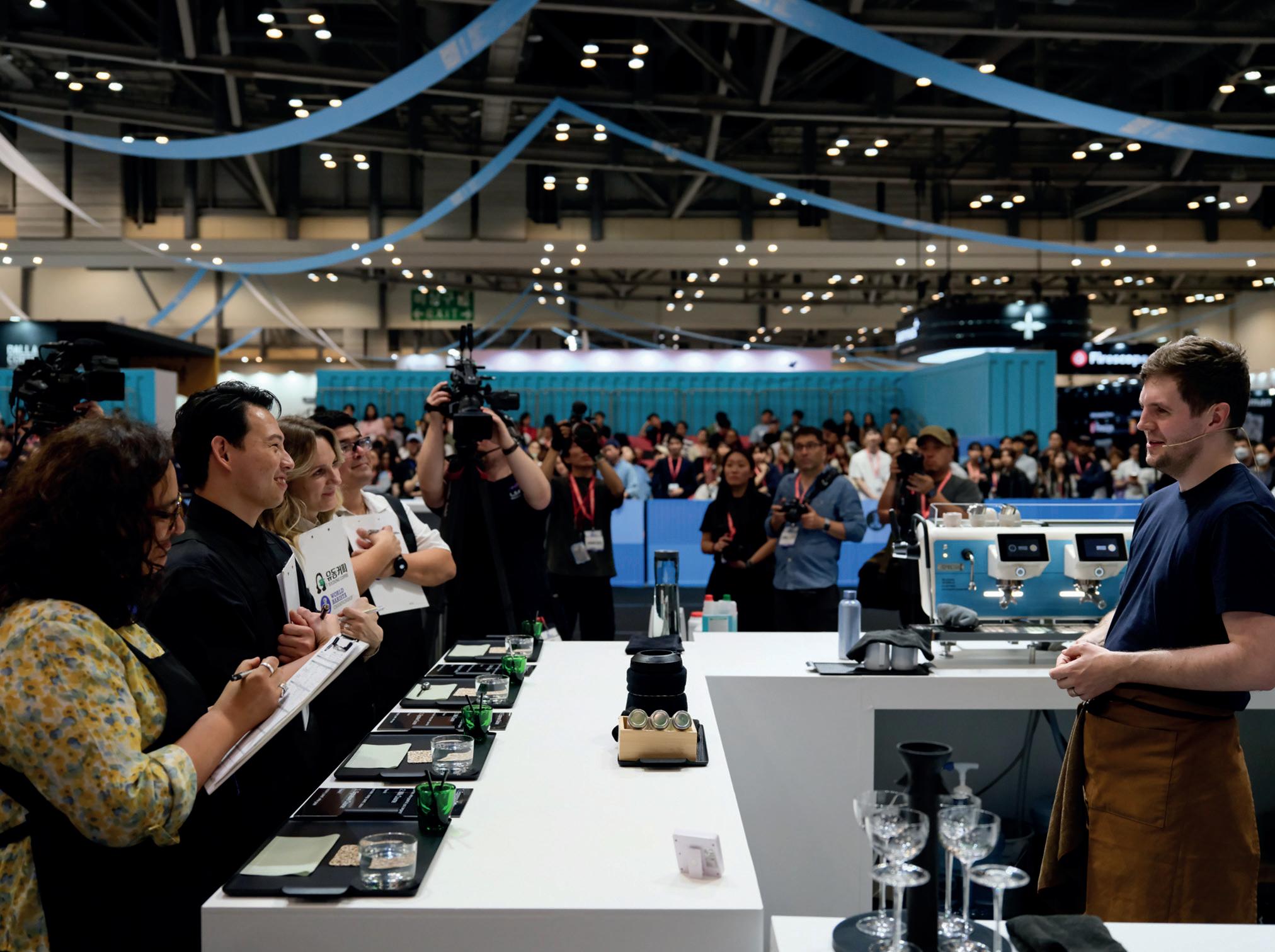
As 2023 UK Barista Champion and founder of Formative Coffee, Ian Kissick understands better than most the difference a quality barista can make.
What are the key elements new, independent startups need to consider before hiring a barista?
The first is to ensure you understand your café’s concept, operating model and standard of beverage.
For example, if you’re seeking an experienced barista to serve high-end coffees from a variety of international roasters, you’ll have different staffing needs to a grab-and-go venture at a train station, focused on speed of service and value for money.
This is important for a couple of reasons – you can hire baristas with an appropriate level of skill and experience but also ensure that your expectations match those of the team, meaning better staff retention in the long run.
Sometimes, attitude is more important than experience, so it’s good
to be aware of training opportunities that are out there.
If you partner with a wholesale coffee provider, like Formative Coffee, often they’ll be willing to provide custom training for your staff, tailored to your business model.
But the main priority is to make every effort to understand the realities of working in a café. And the best way of doing this is to actually get a job in one for a while!
You’re a hugely experienced barista. How would you say the role has changed over the years?
In the past decade, we’ve begun to see a shift towards specialty coffee as a baseline, with more precision and knowledge required from the barista, resulting in a much better quality of beverage for consumers.
Meanwhile, I’m grateful to see that the old trope of the rude, coffee-snob barista is dying off.
Operators are realising the importance of providing exceptional service to guests, rather than trying to prove that ‘the barista knows best’.
Ask yourself lots of questions:
● Will customers be comfortable in the space you design?
● How will you source coffee?
● What will your food menu look like?
● How can you create a stimulating environment for your staff?
Once you have a clear idea of identity, have a chat about it with other business owners, friends and family. It’s worth sense-checking your ideas, trying to figure out if there’s something that you’re missing. Use this as an opportunity to clarify the identity of your café.
Tell us about advancements in machinery for startups.
Once you understand your business model, and priorities for potential guests (speed, price, quality or something else), you can begin to assess equipment options.
If you anticipate a large volume of customers who expect rapid service, but you don’t want to sacrifice on quality, I’d advise grind by weight grinders (for example, the Mahlkönig E80 GBW), which will help speed up workflow, while maintaining accuracy. Combined with automatic milk steaming solutions – like the Übermilk – your team, given sufficient training and strong coffee sourcing, will produce quality drinks in a timely manner.
On the other hand, if you really want enormous control over the coffee you’re brewing, while targeting a lower sales volume, you could look at an espresso machine from Decent Espresso. This offers control of loads of parameters and live feedback on the performance of each shot.
Even if you have worked in the industry, it’s worth talking to
"sometimes attitude is more important than experience, so it’s good to be aware of training opportunities.”
manufacturers and an independent third party with more knowledge and experience, to help clarify potential technology solutions.
How important is the barista role to the business – and not just in terms of making coffee?
My favourite cafés are those which place baristas at the heart of operations. Not just doing the drinks but serving guests at point of sale (POS) and their tables.
This ensures efficient service of quality drinks and a flow to the
operation. Also, the baristas – who are best placed to know how the menu is prepared and how to tailor what’s on offer for your guests – will have an opportunity to guide customers.
How can a barista improve?
If you’re an owner or manager, you must ensure that baristas are empowered to do their jobs successfully. This means setting out clear expectations, providing training and resources to equip them to do the basics of their role well, while taking time to hear feedback.
Depending on the business model, you will have specific needs from your baristas, so training will vary from one place to another. But I always suggest that, at a minimum, any café should document the standard for every drink, then provide training to ensure baristas are able to create them to those levels in a consistent manner.
Beyond actually brewing coffee, if baristas have any other roles – e.g. serving customers at POS or delivering food and drinks to the table – think about how you can provide training to
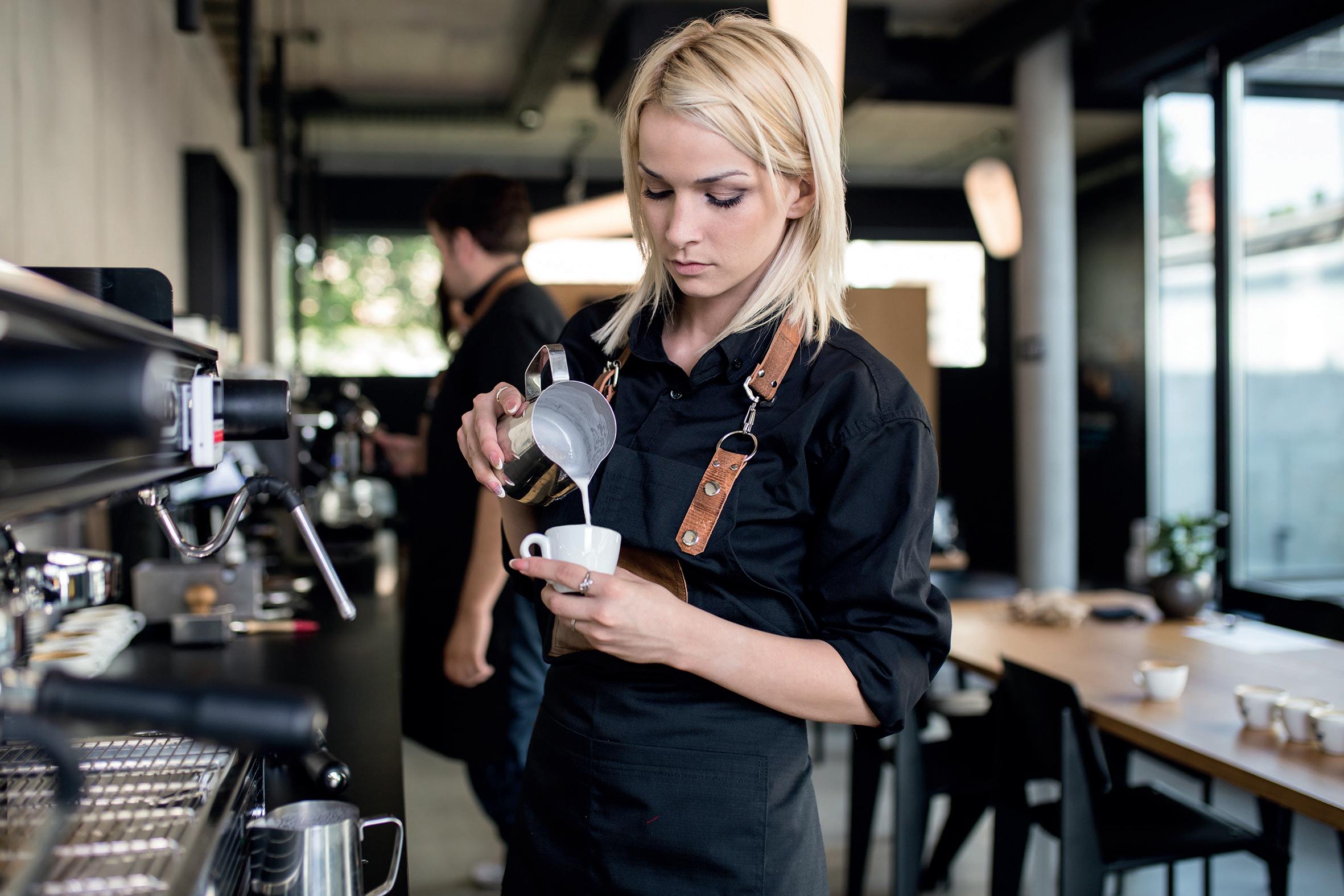

ensure the best possible experience for your customers at any given time.
On the other hand, if you’re a barista wanting to push themselves to be the best at what you do, there are so many resources and opportunities to grow in
Ian Kissick is founder and managing director of Formative Co ee – a world famous co ee shop and roastery based in Central London.
As well as managing wholesale and retail operations, Ian o ers consulting services for new and existing businesses, and is well known in the global co ee competition landscape, taking sixth place at this year’s World Barista Championship.


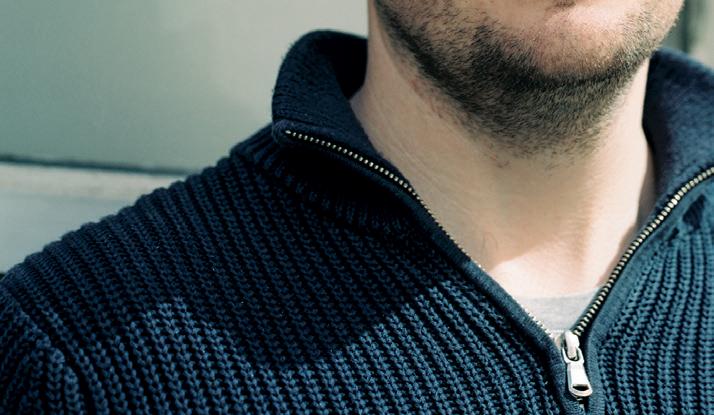
knowledge and ability in the world of coffee. In bigger cities, you’ll find plenty of events focused on coffee where you can get involved and grow alongside other professionals.
But wherever you’re based, there’s now a wealth of resources online, whether it’s structured learning from the likes of Barista Hustle or baristas and roasters sharing their knowledge via Instagram!


For me, if you’re looking to grow in your career, you’ve got to be willing to admit that you always have more to learn. The baristas I’ve worked with who have this attitude always go far!
With the improvement of automated solutions, baristas will be able to shift their focus from the repetitive manual task of making coffee to a more holistic approach of ensuring that guests receive the tastiest beverages with exceptional service.
Take the Mavam MM – an undercounter super-automatic machine which looks great and produces fantastic coffee.
This kind of solution can stand up to the scrutiny of specialty consumers and baristas, and forward-thinking entrepreneurs can use technology like the MM to improve service, decrease wait times and ensure consistency. Many on the consumer side – those involved in cafés and roasteries – have been vocally opposed to superautomatic machines, as this technology can be seen as a way of cutting staff numbers from existing businesses. But in a world where coffee is becoming more expensive, good people are difficult to find and exceptional experiences are few and far between. There is an abundance of opportunity to create business models which stand apart from the crowd in the way they leverage technology.
In this environment, what are the keys to success for baristas? I believe there are three things they can do to help prepare for the future:
1. Improve their ability to taste coffee, and understand how it relates to the sourcing, roasting and extraction.
2. Learn more about the history, geography and science of coffee, so that they’re well equipped to create exceptional experiences for guests.
3. Work hard on customer service skills, as building relationships is the key to any hospitality business.


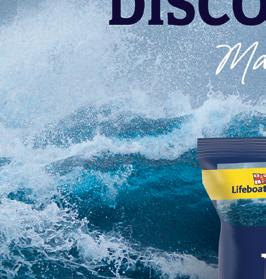


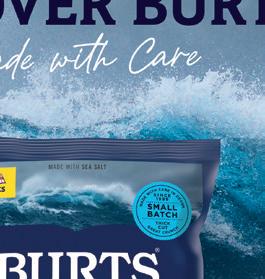




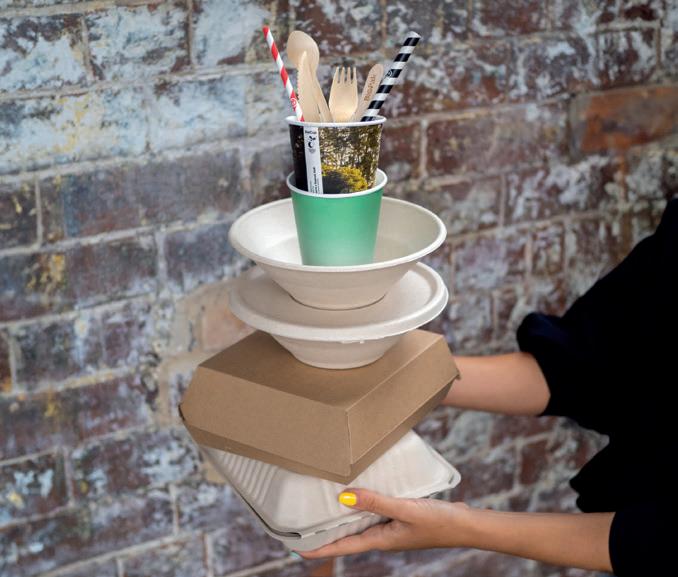
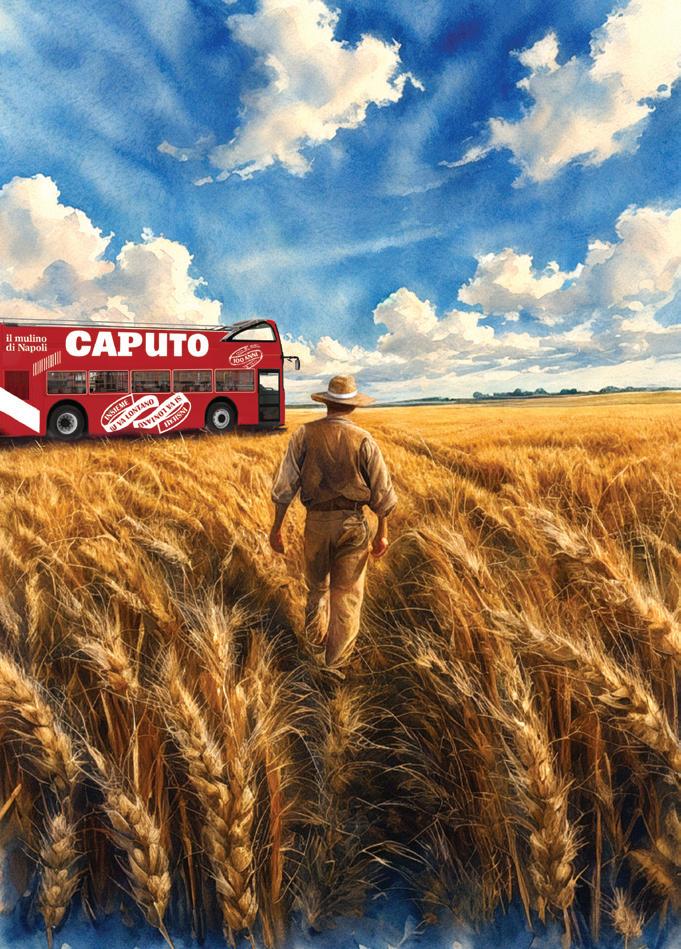


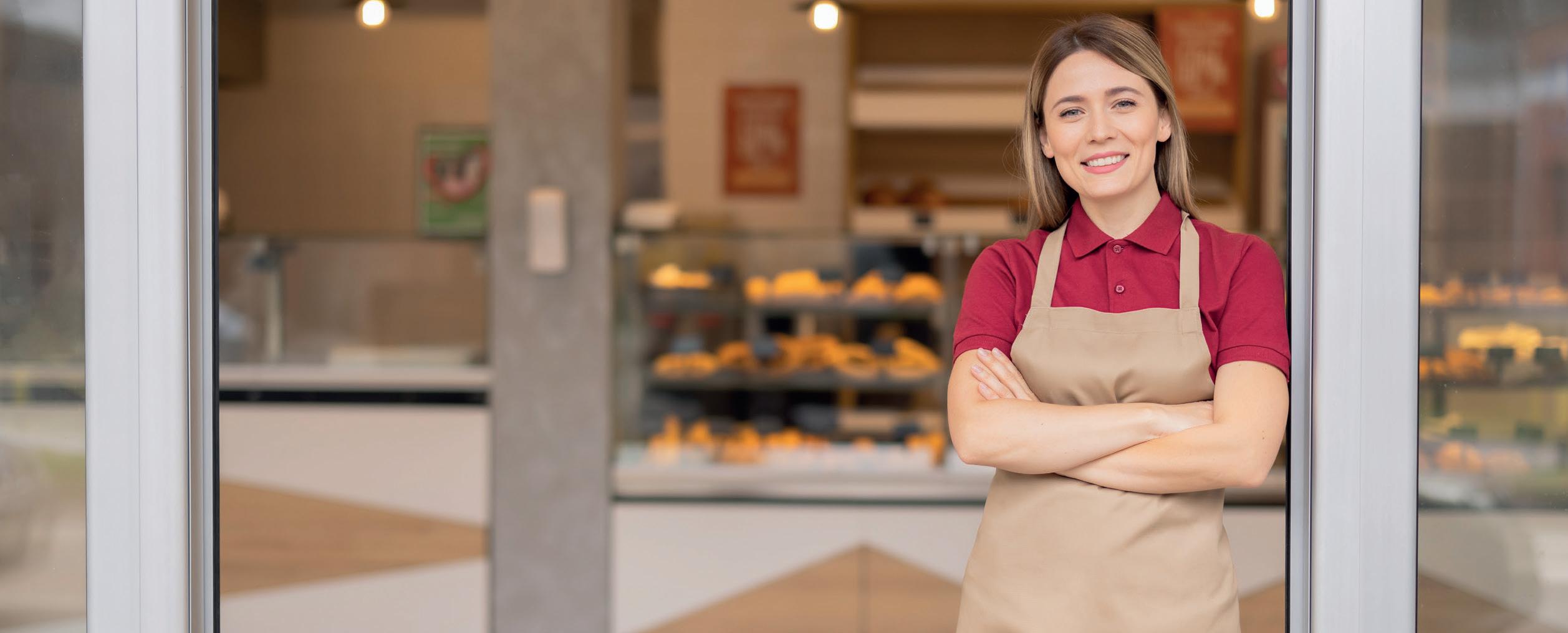





Want to serve up a hot, tasty dish at any time of the day, without the need for a chef or large kitchen?
Whether offering hot food for the first time, or expanding your menu, the Merrychef conneX® 12e high speed oven offers an affordable, entry priced, versatile appliance that can cook, grill, toast and reheat food from fresh or frozen. The Merrychef conneX® 12e fits into small spaces and is already highly trained with pre-programmed menus so no need for extra staff.